







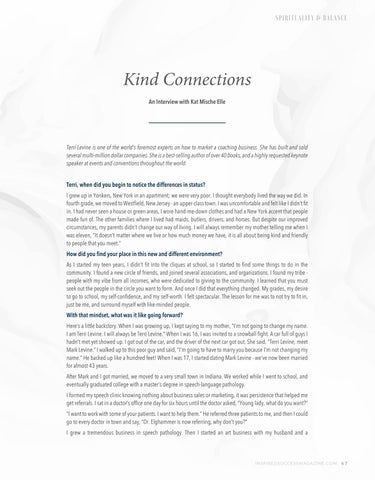








There are clubs, and there is Kohanaiki—a private oceanfront playground that welcomes a new generation of Kona-lovers. Five minutes south of the Kona International Airport, and uniquely positioned to offer a sense of escape, Kohanaiki embraces island life in ways both new and familiar. Whether at the 67,000-square-foot Clubhouse, on the Rees Jones-designed golf course, aboard the 39-foot Kai Kea, or in the cabanas opening out to views of ancient lava flows and anchialine ponds, you’re surrounded by history, culture and adventure. Refreshingly private yet remarkably social, Kohanaiki is a new living experience unlike anywhere else in the islands.


This issue of Inspired Success Magazine celebrates International Women’s Day!
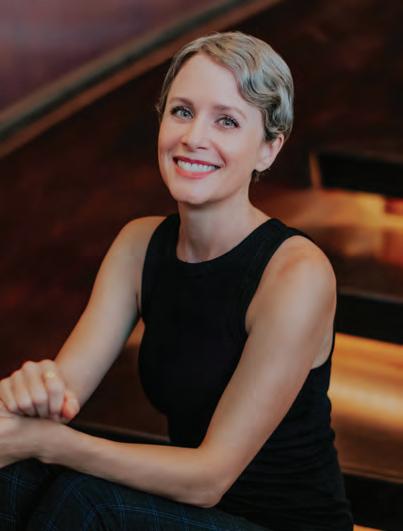
Annually, March 8th is a day to honor the aspirations and strength of women who have overcome adversity and celebrated progress. Highlighting amazing women is a beautiful way to recognize their contributions and inspire others to live more in the power of their opportunities.
International Women’s Day gives us all a moment to reflect on women’s achievements throughout history and to acknowledge them in all areas of society, including their significant contributions in every field, from science and technology to politics and the arts. These women encourage the next generations to pursue their dreams and reach their full potential.
It is also a time to recognize and focus on the all-life sustainability required for our global home.
And it will take all of us.
We all have a role in creating a more equitable and just world.
We have the resilience and tenacity to achieve Inspired Success!
I wanted to give a special thanks to all the women who have personally influenced my life. I am grateful for my grandmother, mother, sisters, cousins, nieces, and all the women who became my sisters.
Within these connections and friendships, I learned how to be the most authentic me I could be by observing so many different personalities and deciding where I felt the most at home with myself.
One of the biggest takeaways gained was the realization that what I perceived as weaknesses were efforts of acting out moments of survival and strategy. I can forgo judgment for another woman’s position and have gained compassion and understanding.
I also celebrate the women I know who have become my sisters over the years and are out loud and fearless about taking on life! Courageous women who I once feared within my insecurities while quietly building friendships with them. My experiences with them were very different from my early conditioning of what it was to be a young woman stepping into the world. I quickly realized these women were showing up in my life, living in full force by example and helping strengthen my backbone.
Near
Inspired Success Magazine is designed to transform people’s lives so they think better, choose better, and take action. We offer practical tips and tools by interviewing thought leaders, professionals, adventurers, entrepreneurs, and influencers so our readers can bring their visions into reality. We’re on a mission to share inspirational stories: the trials, lessons, and wisdom that lead to success.
I dedicate these publications to my family, friends, acquaintances, and everyone who unknowingly reaffirmed where I intended to find my place. I am grateful for all the moments I have shared with people while aligning and resonating with them and all the moments in contrasting and opposing conversations. Every exchange has helped fortify my strength and inspiration in this life.
I am forever grateful.
Founder/CEO: Kat Mische Elle Photographer: Rojeena, Rozy Kat Photography




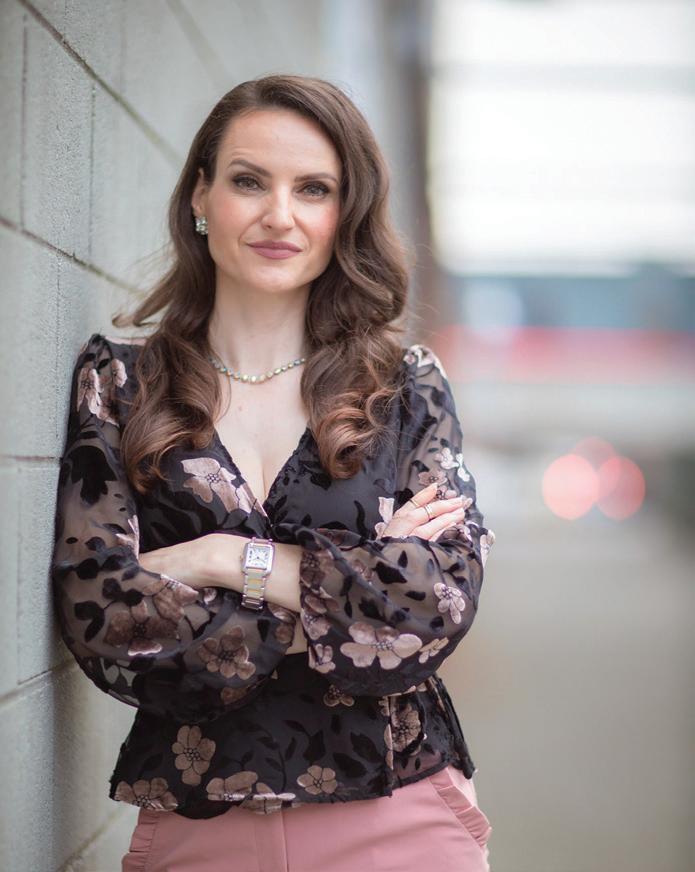
Brook is multi-award winning, entertainment and media veteran and has won an Emmy Award for “Outstanding Direction”. She is an A-list expert on personality driven branded entertainment across all platforms. Her unique approach to storytelling explores the idea that corporate strategy and life improvement can be paralleled in the same breath. Brook has been at the forefront of innovative programming and holds 4 Emmy Awards, 19 Telly Awards and 1 Anthem Award.
Brook, can you share how you began your relationship with the west coast?
It was 1970, I was five years old and living in Brooklyn, Midwood, between Ocean Parkway and Avenue M. My father was an accountant working at Price Waterhouse and he was offered a job in Los Angeles with a boutique firm that was in the music business. So, just like the Beverly Hillbillies, we “loaded up the truck and moved to Beverly Hills, swimming pools, and movie stars.”
I didn’t know the difference between Brooklyn and Beverly Hills at that age. I did know Town Mouse & Country Mouse, except this was in suburbia, and my parents chose opulence. I could see the sun and play in the grass. The sky was a royal blue color, 365 days a year.
The good news is I made many friends, many of whom are still in my life today, and some are closer than others. Max Mutchnick is one person who warms my heart whenever I think of him. We were inseparable through most of elementary school. We laughed, danced, cried sometimes, and no matter what, felt comfortable in our skin around each other. We were like-minded, and unbeknownst to us, we both were gay, I just knew he was a true best friend.
My Dad was managing money for southern rock bands, like Steppenwolf, Three Dog Night, and Black Oak Arkansas; they all were a big part of my childhood. They were always hanging out at the house and in our pool. My Dad would often take my sister and me to concerts while working. The moment he saw me fading in exhaustion, he would put me on the speaker on the stage and let me fall asleep with the band jamming and thousands of people singing and screaming, and I was out like a light.
On the intense vibration of a speaker?
I was always around incredibly high energy. It didn’t faze me. Eventually, my dad transitioned from music to entertainment, so movie stars replaced the musicians.
My father was more of a business manager than an accountant. Some of his clients were Aaron Spelling, Bruce Willis, or David Lynch; the spectrum of talent was broad. My father always said, “Don’t go into the entertainment business. It’s hard enough just getting a foot in the door.”

I took his advice initially and pursued sports medicine at SFSU. One semester, I chose a film class as an elective that focused on making super eight films. I picked up a film camera, fell in love with storytelling, and that was that.

So, I transferred back to the East Coast and went to a small liberal arts college, Hampshire College. I studied film theory, film history, and television communications. I enjoyed what I did so much that it never felt like “a job.”
Were your parents always accepting of you and your choices?
They appeared to be very accepting. My Mom was devoted to us and very present. She’d come to all my track meets and my volleyball games. She was always there rooting for me. My Dad wasn’t around much in high school. He was always working; his work became his identity.
At that time, I didn’t know anything about narcissism. I didn’t realize that he had a lot of that edge because he was incredibly self-obsessed.
I had a boyfriend named Karl Moseman in high school, whom I was madly in love with. He was a junior, and I was a freshman when we met; he was my world. At the beginning of my senior year, he ended our relationship. I was heartbroken, but he said, “I know you want to be with women.” He knew my unspoken secret and permitted me to be me. That year I started to explore my “gay gene.”
Most lovingly, my Mom asked if I wanted to see a psychiatrist. I said okay. I had two sessions, and the therapist said, “There’s nothing wrong with you.” My parents accepted that, and we never talked about it again. How did you begin directing in your twenties? Tell us how those connections formed.
After graduating from College, I moved back to the West Coast to learn production and was offered a job working in production for an extraordinary human. His name is Joel Silver, and he’s known as “The King of Action.” All Die Hard and Lethal Weapon franchises, 48 Hours, and Matrix. That’s Joel Silver. He’s brilliant. So here I was, this little graduate from school ready to go, working in production for him as a production assistant, learning everything from the ground up, getting coffee for the director, and bringing talent to the set.
I would hang out with every department head because they were the best
in the business. I would ask questions and watch everything they did. It was a quick study for me. I only understood the nuts and bolts of what it takes to get a movie made but not the financing part of it. I had no clue. But Joel gave me so many opportunities. After we shot Die Hard and Roadhouse, Joel was preparing to launch “Tales from the Crypt, a series for HBO, which was kind of an anomaly because it was a million dollars for every half-hour episode in 1990, which was a big budget for TV. We hired A-list directors and A-list talent, which was also unheard of for TV. Richard Donner, Bob Zemeckis, and Walter Hill were the executive producers of “Tales from the Crypt.”
Joel offered me the opportunity of a lifetime to be a production coordinator for the first eighteen episodes. I made that leap from PA to production coordinator and had so much to learn. Fortunately, my boss was the production manager, Fred Baron, who took me under his wing and taught me everything about production. My most memorable moment was pulling off a seamless week of filming in Arizona for Two-Fisted Tales, a pilot that Richard Donner was directing.
After we wrapped, he told me I was flying home on the private jet. He sat me right behind the pilots in the jump seat and handed me a martini, for a job well done.
After 18 episodes, I was ready for the next step in my career. The only way I could leap into producing and directing at 25 was to start my own production company. So, I did. I had an opportunity to work permalance, (a permanent freelancer) at Sony Music Entertainment and moved back to NYC. After five years of doing multiple projects simultaneously, I was completely burned out. My life became work, work, work, and no sleep. I decided to take six months off, get to know myself again, and determine what I wanted to do next. Not long after I made that decision, I received a call from an Executive Producer, Eric Liekefet, who was launching a new series on daytime television. He got my name from a colleague at Sony Music and asked me to meet with him about a new daily show launching on CBS called Martha Stewart Living (MSLO). I had never launched a daily show before, so I was intrigued.
I took the job, built an awesome team, and hit the ground filming. I won my first Emmy for Directing that year, and two years later, our company went public. The show ran for many years, and then about six months before

Martha was indicted, I was let go from the job. I came in for production one day, and Human Resources fired me. I had never been fired from any job in my life. I was disappointed that Martha didn’t have the conversation with me directly after all we had accomplished together, so I asked her to meet me for dinner. As upset as I was, she said, “Brook, you are way too talented to be doing this show anymore.” I didn’t fully understand it at the time, but her words were magical, powerful, and stuck with me. So, what did you do after that, as far as your career goes? Where were you stamping your name?
When I left MSLO, I met a woman who became my partner. I relaunched my production company in the digital space and bought a second home in Sag Harbor, NY. Coincidentally, on the heels of purchasing our home, I was offered a job in the Hamptons as General Manager for launching a leisure community-based, local TV network called Plum TV.

I then began the next chapter of my life, motherhood. In 2006, I gave birth to a beautiful baby girl. The relationship didn’t last, but I have the incredible experience of being a mother to my daughter, who impresses me daily with her incredible inside and outside beauty.

When did you become involved with nonprofits?
Once Covid-19 shut the world down in March 2020, nonprofits scrambled to get their funding transitioned because they couldn’t do in-person events during the pandemic. Most companies seemed to be looking at the Zoom platform as a solution, but I decided to learn a new medium using 3D technology and Unreal Engine software to create an experience that was engaging, entertaining, yet rooted in compassion.
I took on two nonprofit clients, the T. Howard Foundation was trying to find a solution for their Annual Diversity Awards Show and Regional Hospice in Danbury, CT, which was gearing up to raise money for a new children’s wing called North Star.
For thirty years, the T. Howard Foundation has been placing young, diverse talent in entry-level jobs within entertainment and media companies, giving these interns a foot in the door they would not otherwise have had.
We worked day and night to create every element of the show from scratch and won several awards.
A colleague introduced me to the President and CEO of Regional Hospice, Cynthia Emiry Roy. They are extraordinary humans doing the work of angels. Their mission redefines hospice care. Whether it’s end-of-life care or a life-limiting illness, human connection is their mantra, and their culture honors each patient’s unique end-of-life journey. Hospice is a word that people never want to talk about. Then layer on children with a life-limiting illness, and it’s almost unbearable to speak about.
The North Star facility was designed by world-renowned Architect Roger Ferris. I worked with Roger and his team to use his architectural flythrough rendition of the wing as the set for the show. Our visual effects team did a stellar job, and we won a gold Telly Award for Set Design.
We hired the lead in Hamilton, Miguel Cervantes, and his wife, Author, and Activist Kelly Cervantes, to host the show. We chose Miguel and Kelly because they had lost their daughter when she was three years old. Every moment of the show was right from the heart. Families who had lost their children played a significant part in the production, which I believe now was a significant part of the healing process.
There is a profound difference between what you create when you are heart-focused and not just project-focused.
Regional Hospice raised more money than it ever had before with this production. We won 6 Telly Awards in different categories including Director. It was a magical experience for me and an honor to work with these foundations supporting their mission.
What are you focusing on for 2023?
The main focus for me now is raising my daughter. She is the most important part of my journey, which is why I am now developing a new project specifically focused on a sustainable lifestyle.
What is the best way to get in touch with you?
The best way to find me is through LinkedIn. u

At sixteen years old, Mikalah Gordon became the youngest top 12 contestant on American Idol. She went on to host American Idol Extra and the Tyra Banks show. Proving she could do it all, Mikalah showed off her acting chops where she starred in Living with Fran with Fran Drescher, and The Unit on CBS. Having a knack for comedy, Mikalah began her stand up career in 2015 and found social media fame by impersonating Melania Trump in the height of the pandemic where she gained 1.6 million followers on TikTok. She is a member of the LGBTQ community and was the host for the first national LGBTQ morning show for four years on Channel Q. Mikalah released her first album in September, where she used it to advocate for women’s rights, mental health, and the LGBTIQ community. You can catch Mikalah every Friday at 8/7 central on the CW where she corresponds for season three of Worlds Funniest Animals. You can also listen to her new podcast So Funny, It Hurts where she interviews your favorite funny people, and explores the trauma that made them that way, as she advocates for mental health.
Mikalah, what led you to where you are today?
My father was a jazz musician whose inspiration truly shaped me to love music. Knowing what I wanted to be was a huge part of my identity. I knew I wanted to be a singer. I grew up with a single mom and experienced a complicated, dysfunctional youth. Not something I would ever take back, but I genuinely believe it made me who I am today. It allowed me to share the stories, have empathy, write my album, and gave me the drive that ultimately led me to audition for American Idol. I was a fearless 16-year-old wanting to get out. American Idol led me on an incredible journey of highs, lots of lows, and a lifetime of great memories.
What main events and supportive highlights helped to shape your future?
I was very sad about being laid off from the morning show that I loved and had hosted for five years. I could have said, “Oh my God, I’m devastated, or, this is an amazing opportunity!” The universe works like a vacuum, taking away something to allow something new. I chose to go with this amazing opportunity. It has taken a long while to like myself. I still battle with self-worth issues, but for the most part, I can look in the mirror and say I love my resilience, tenacity, hard work, capability to do things, and ability to step back and relax. I was raised without any expectations. I had to get through the lower light issues and make an opening for empathy, to be a well-rounded human being with morals, authenticity, honesty, and values. Blessings are meant to be.
Which parent are you more similar to?
The love of music and perseverance are traits that I share with my dad. I attempt new things despite my anxiety and fears. At 62, he went back to college to get a degree in jazz because it was important to him. He didn’t let age get in the way. He’s living on his terms, and I admire him for that.
And what characteristics do you admire and take on from your mother?
She and I are similar in many ways, even though we haven’t always seen eye-to-eye. One thing she instilled in me was that anything is possible. She dove into spirituality books; I enjoyed reading them from a young age. She was

this witchy, gypsy woman who reminded me of Stevie Nicks; I thought she was fabulous.
How much strength and success have you gained from taking chances on yourself?
There are many answers because it was a long road after American Idol. It was the first time I couldn’t control what was happening based on my personality. Even though I dealt with eating disorders and harsh message boards from the audience, I just wouldn’t quit on myself. I couldn’t. I must always take care of myself and not let myself down.
What is one of the most difficult things you have experienced during your climb to fame?

I’ve never discussed this publicly, which is still very difficult. On American Idol, you needed a chaperone, mine was supposed to be a woman my mother was dating, but she was a drug addict. She loved me, and I loved her. I’ve never been judgmental about their drug use. I was raised by her and my mother and believed they were some of the most sensitive people just trying to self-medicate. But she was supposed to be my guardian and died of a drug overdose the day before I left for American Idol. My mom was getting help at a mental facility and had to leave the facility to be my guardian on American Idol.
We were kind of a mess; I was grieving her partner, who was supposed to also take care of me, and I was grieving a parent trying to get her anxiety and depression in order while we were in the spotlight. I was grieving being sexually assaulted at 14 and the message boards of American Idol calling me horrific names. It was a lot for a 16-year-old to bear. After the show, I didn’t sing for years because I felt like I was so harshly criticized.
How has that experience strengthened you?
I’m in a place where I believe these things need to be talked about by other 16-year-olds. You don’t know what people are experiencing behind closed doors. You just have to be kind, even if you don’t understand. It takes nothing to be kind and smile. I was in a dark place, and I was romanticizing suicide. I’m not looking for sympathy, but I want to share that people need to understand that there are many layers to people, and you have to meet them where they are.
It’s difficult to feel lonely in such a big world. Had I shared my story, I might not have felt so alone. I am sharing it now to say,
“If you’re reading this, you are not alone. And if you
choose not to share anything that’s ever happened to you and just want to use me as an example, you’re not alone. I hope this brings you some sort of comfort. The comfort I feel like I desperately needed so many years ago. I know that feeling. And I love you.”
What supportive advice and guidance would you offer to emotionally struggling teens, and women around self-acceptance?
Therapy helped me more than anything. The stigma around going to therapy is heavy, especially growing up in an Italian family where you were told not to cry or feel. Professionals know how to guide others through these situations. I asked for a lot of help. I’m not afraid to ask for help with anything, help from my friends, or help from my family. It makes other people feel good to help. It’s a gift for both sides to ask for help because people who care about you also want to be there to give support.
What are your efforts currently advocating for?
I made an album and named it after my Grandma Vivian. The most important song is “Hands Off,” where I opened up about being sexually abused. I also made a music video depicting all types of women who were abuse survivors. This music video gives them the voice they also deserve to have. The biggest thing I learned is that I was tired of holding a secret when I hadn’t done anything wrong.
I advocate for women and men who have been sexually abused. A percentage of the proceeds from my album went to support Planned Parenthood because they are, first and foremost, about quality, affordable health care!
I spend a lot of time researching the aspects of depression and anxiety, and I know there are cures. I’ve recently dove into the applications of therapeutic psychedelics and understanding how they can help repair the brain’s neural net from trauma. My heart also lies with the #MeToo movement and mental health awareness.
What is the most exciting news coming into your life this year?
After eight years, I’m engaged and thrilled about it.
Will you let yourself enjoy being a fiancé for a bit?
I’m so excited. Everyone wants to know if there’s a date, but I refuse to fall into the pressure trap. I want to continue to enjoy being in love.
And you are marrying your best friend?
Yes, I’m marrying my best friend, family, and person.
You don’t know what people are experiencing behind closed doors. You just have to be kind, even if you don’t understand.
I’m moving into my family, Lisa is my family, and we’re going to create our own family that is loving, healthy, and functional. We go to therapy, and we know how to ask for help. We are strong, and I am happy.
What else are you planning for the rest of the year?
I’m excited about 2023. I am doing a rebrand. I love singing and comedy, but I want to start having real conversations about all of the trauma I went through in a relatable way, with a lot of dark humor, because that’s my brand. I’m excited to announce that I now have a podcast I just launched called “So Funny, it Hurts,” where we talk about the trauma that made us funny and the steps we’ve taken to heal.

Growing up, I was the funniest girl because I was the saddest girl. I needed to laugh and find ways to feel lifted, and I liked to make others laugh. I want the podcast to be a humorous way to know you’re not alone.
What advice would you give to your younger self?
When I check in with myself, I always ask, “What would my 16-year-old
self do?” That is when I was the most determined in my spirit to escape from the life I was living. That’s literally how I have lived my entire life. My work is better when I do that. I think a lot of people are motivated by their children. I’m motivated by my inner child because I don’t have children yet.
Who have you looked up to the most in your life for inspiration?
Specifically Barbra Streisand. She is a funny girl, you could see she was in so much pain, but she was funny, adorable, likable, and lovable. And Dolly Parton also had major traumas but never talked about it until recently. She’s brilliant. Dolly and Barbra are my girls.
How can we keep tabs on your next greatest upcoming creations this year?
You can find me on social media at Mikalah Gordon or my website MikalahGordon.com u
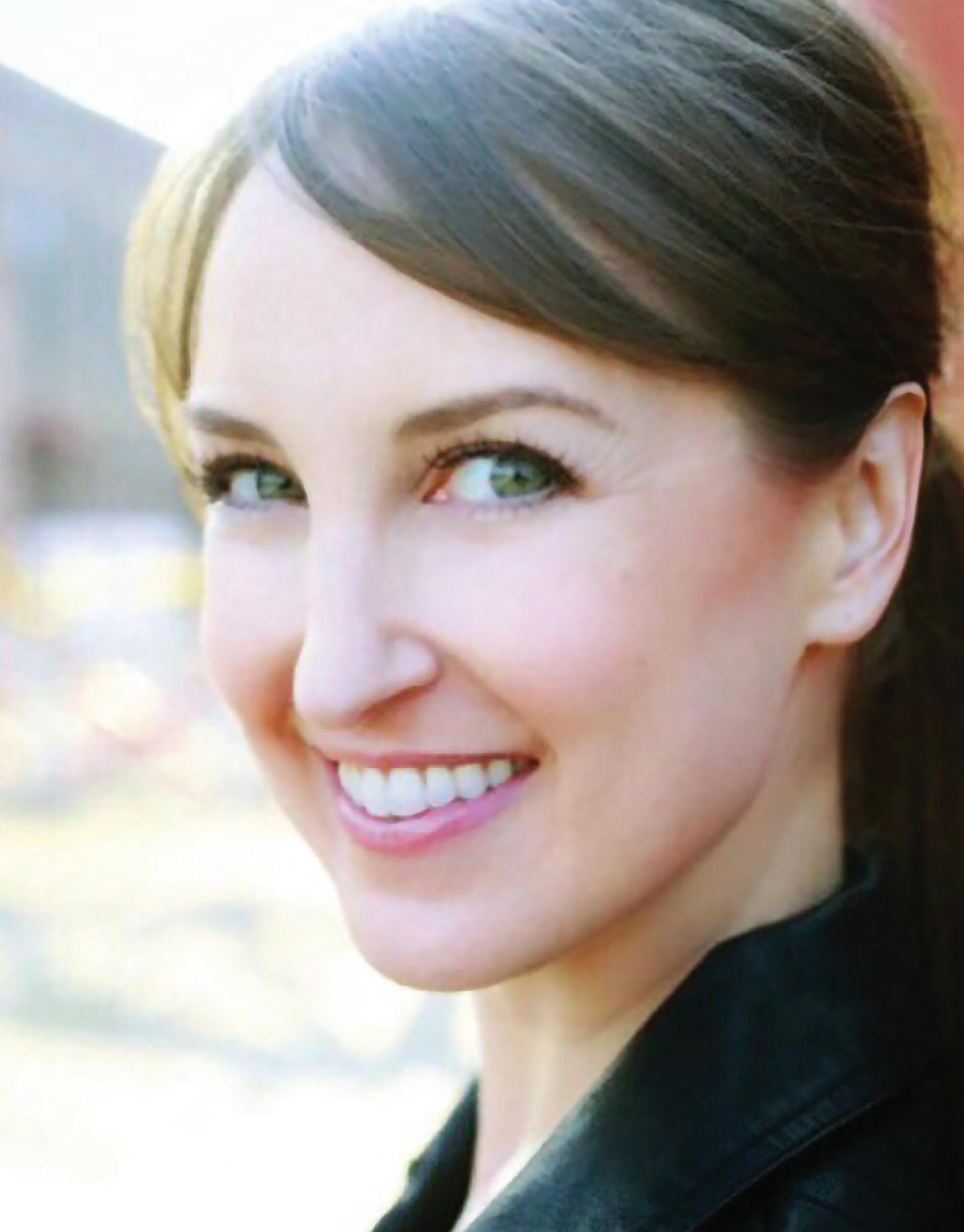
Jessica began studying classical ballet at the age of 5, and has been dancing professionally since the age of 17. Her career has taken her all over the world. She is currently performing in the Phantom of the Opera on Broadway. In 2017, Jessica founded the children’s hospital outreach nonprofit Broadway Hearts.
Jessica, will you share segments of the journey that led you to your current life? I grew up in California and started dancing at the age of five to improve my gymnastics. After my first ballet class, I came home and said, “I don’t want to do anything else!”
I was focused and obsessed. My drive for my entire childhood was ballet, ballet, ballet. I grew up with two brothers. My little brother, at the age of four, also started dancing. My older brother was a martial artist and an athlete, my father was a writer, and my mother was an artist and potter, and had a dance clothing company. We all grew up surrounded by art in some fashion. Our parents were incredibly supportive of anything we set our minds to and were passionate about. My parents were so supportive of our dreams that they would even take us out of school early to drive us an hour and a half each way to study ballet.
Was your brother also in ballet?
It’s the quintessential story of the younger brother following the older sister into a ballet class and going on to become a ballet star! He was a beautiful dancer. It was a huge commitment for my family for us to study. I had studied on a scholarship for summer sessions with the School of American Ballet in New York City from the time I was ten years old and then at 15 decided to stay and train for the year. It was when I suffered my first major injury. I fractured my hip, an overuse injury that came to light during ballet class - I felt a click in my hip doing one of the combinations, and it kept me from dancing for almost two years. I had to go home to California, which was devastating at the time. It was also the beginning of my ongoing path of self-discovery through injuries.
How did you heal from that injury?
Time. That was the beginning of some of the roughest phases in my young life because it was the first time I had ever been without dance. I was a teenager, and I had to think about my identity without it. Those were a really tough couple of years for me. I didn’t know where I was going.
I ended up moving to San Francisco and started to teach at a local ballet school where my brother was training and I discovered a love a teaching!
What was your takeaway from this healing period?
The love of teaching others was now a part of me for the rest of my life and continuing my knowledge. Teaching is something I gained from that injury, it helped free me from being stuck.
The great takeaway from my time away from dance was that if you love to do whatever you do, something else can also come from it. And so always staying open and curious was a gift to me. This was something that my parents impressed upon us while growing up and this was the first time I was actually implementing it.

We both went to Washington, DC, studied with The Kirov Academy there, and then came to New York City. I’ve been here ever since.
And then, I sustained another terrible injury, which kept me out for almost four years.
Was it your hip again?
No, I tore my Achilles tendon and thought it was the end of my career.
How many years between your injuries?
About six years. This injury came and just flattened me. The doctor said I shouldn’t count on dancing ever again. I didn’t agree with that. But I hustled during that time and worked a million different jobs. That was a defining moment for me because I realized that I could do different things if I allowed myself to.
What things did you discover you were good at in addition to dancing?
The work ethic that ballet gave me applied to anything I put my mind to. In the four years I was out of dancing for my injury, I was a sous chef, a candy maker, a receptionist, a bookkeeper, and so many other things, as I needed to make a living for myself.
In essence, was this the beginning of your self-ownership?
Absolutely. My career didn’t define me, I defined myself. And that was such a huge realization that I would be okay. My life and happiness had always revolved around dance. When I finally got back to dancing, and in shape, I realized that my Achilles would never be strong enough for ballet company life.
A friend of mine was in Phantom of the Opera, and she said, “Why don’t you audition? You could rehab your foot specifically to do this choreography.” And so I did. I auditioned a few times over a year and a half, and I finally got in and got the job. It was a dream job with a steady paycheck and incredible health insurance. It also allowed me to do some other gigs –like The Nutcracker.
And then, my father got diagnosed with pancreatic cancer in 2009. My dad was one of the greatest source of joy and happiness in our family’s life. Losing him took all the air out of the room and out of my world. It changed everything. He was diagnosed in October, and he passed away the following August. We learned it was a genetic cancer. His whole family had died of either pancreatic or ovarian cancers. He was tested for a specific gene, BRCA (a genetic cancer gene). He tested positive for it, and they said, “Your kids should get tested.” And so I got tested, and I too was positive for the gene.
During this insane grief, I had to figure out my health and how I would move forward with this genetic mutation. BRCA1 predisposes me to ovarian, breast, and pancreatic cancer (the big ones!) and five or six other types of cancer. And they keep adding cancers all the time. So rather than dealing with my grief, I went into full distraction mode and kept my grief as far away from myself as possible.
I had to figure out what I would do with my health and the doctors. I connected with really good oncologists and they were urging me to have an oophorectomy (take my ovaries out), which was going to put me in immediate surgical menopause, and I wouldn’t be able to have kids. All I could think was, “I can’t do this right now. I can’t make this decision right now.”
I put that surgery off for a while because I didn’t know what to do. But I dove headlong into outreach for genetic cancers and got involved with several genetic organizations, to gain as much knowledge as possible. It became a channel for my energy, and a substitute for dealing with grief. Honestly, it’s still hard.
The outreach proved an incredible gift because I got to help other people, it was this wonderful place to put everything into, and I got to know so much about the cancers. And then, I decided to do my first surgery. It was a knee-jerk decision to have the oophorectomy, and I didn’t have a postoperative plan in place. It was so stupid. I just winged it.
I spent the next two years trying to get my body to where I felt like myself again. I had horrible migraines, and I felt like a completely different person. It was a process to get my chemistry levels and hormones balanced. And I thought, “Oh my goodness. Wow! I must share this story with others to ensure that no one else does what I did.” That became my mission to help as many women as possible with their decisions regarding the care they will need.
From what platform(s) were you doing that?
One of the groups I work with is called FORCE (Facing Our Risk of Cancer Empowered).
I’ve become a patient advocate. They pair me with women having the same surgeries, doing surveillance, or specifically dealing with surgical menopause. Later, after a mastectomy with reconstruction, they paired me with women going through something similar as well.
So, how did Broadway Hearts come to be?
I knew I wanted to start a foundation in my dad’s honor, but I had no idea what that would look like.
At Phantom, Make-A-Wish® Kids regularly came to see the show, which was a beautiful part of our experience there. I wanted to figure out a way to bring a version of a Broadway show to kids in treatment. And that became a focus. I started calling local hospitals, and finally, I got an okay to bring a group of Broadway performers to children at their hospital. And then that hospital turned into another hospital, another hospital, and then Ronald McDonald House®.
The momentum grew! When the pandemic hit, we took everything online, which was unbelievable because it allowed us to go into hospitals nationwide which I had wanted to do anyway. Online allowed us to visit with kids in every part of the hospital, not just the children who were well enough to come into the room with us. We now have over a hundred incredible volunteers from different Broadway shows, unbelievably big stars, first-show graduates, and everything in between. The kids we visit are beyond inspiring. They live so completely in the present moment, it’s this huge reminder of how to live. They light up when we visit, and we feel very fortunate to get to share the healing power of music with them. Our visits are a wonderful exchange of energy. With all of our programs we try to create wonderful memories for these amazing kids. New, wonderful memories to hopefully take back into their next round of treatment to help buoy their spirits. And we’ve been able to do some really great things for a small boutique nonprofit. I have huge dreams for Broadway Hearts!
You’re blending your art and hearts.
Yes, and my dad would’ve loved this. I get to dedicate this to him. This is, it is all about him, and my goodness, I feel so fortunate.
What is your inspired, impactful focus for the rest of this year?
For the foundation, I would love to bring in a developmental person to take
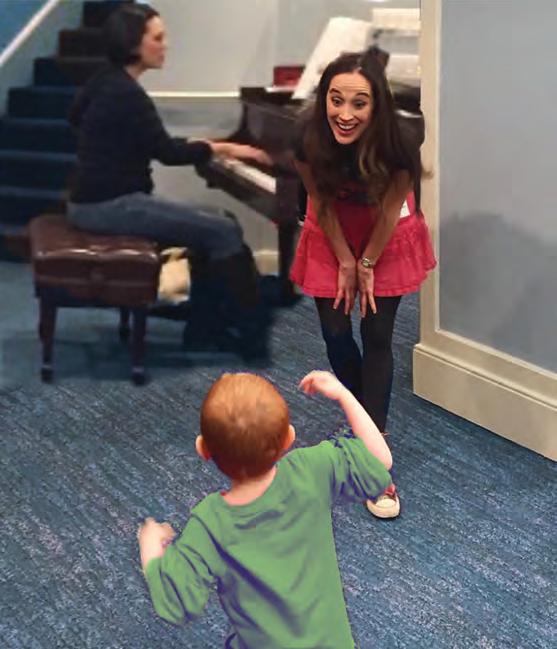
us to the next level and see us go global so we can be in every children’s hospital. I have huge dreams for us, and I don’t think that there’s anything that we can’t do.
I want to do what we’re doing on a much grander scale and keep expanding our programing. I also have a company called Broadway Unveiled, where corporations and individuals can book Broadway performers for an up close and personal concert for employees or parties.
So there are some exciting things ahead, but Broadway Hearts is where my focus is, and I wake up and go to bed thinking about it. How can people find out more about the foundation?
Website: Broadwayhearts.org
Social Media: @Broadway hearts u
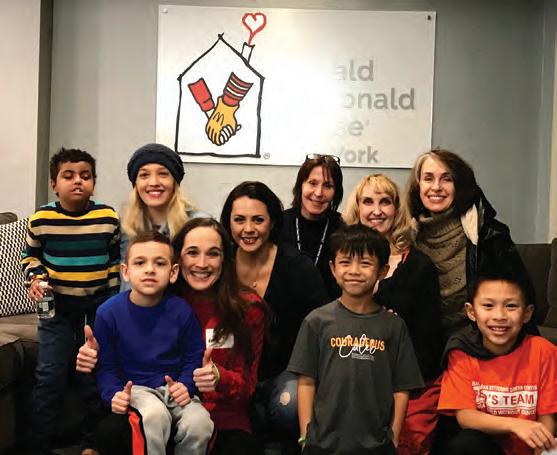
Jeanne Simmons was born in coastal New Hampshire in 1964. She graduated from the Maine College of Art in 1991 with a BFA in Sculpture. She attended the Skowhegan School of Painting and Sculpture the following summer. In 1992, Jeanne moved to Chicago to attend graduate school at the School of the Art Institute of Chicago. She moved to the Pacific Northwest shortly, eventually settling on Vashon Island, WA, where she met her husband, Gunter Reimnitz, a sculptor. Jeanne and Gunter moved to Port Townsend, WA, in 1999, where they raised their two beautiful kids. She has devoted her life to parenting and the creative process ever since.
Jeanne, did you always know you would be an artist?
I grew up admiring artists immensely, but I never believed I might be one or become one. Fortunately, I discovered a trail of breadcrumbs that eventually led me to art school in my early 20s. My time at the Maine College of Art and Design (formerly the Portland School of Art) was life-changing. It set me on a trajectory of curiosity, observation, and creative expression that has since defined my life. I briefly attended the School of the Art Institute of Chicago as a graduate student in sculpture in 1992. I quickly discovered that urban living was not conducive to my well-being. I followed my nose and intuition to the Pacific Northwest, where I have resided ever since and where the natural world inspires me. I walk the beaches, fields, marshes, and woods of the Olympic Peninsula daily, along with my canine companions who lead the way. My time in nature sustains, stabilizes, and inspires me. I hope to describe my devotion to and love of the natural world with my work.
I hope to communicate my belief that humans are an extension of the natural world, just as the natural world is an extension of us.
I hope to describe the possibility of a harmonious rapport between us and nature and to remind the viewer that there can be no “us” without “it.”
The art I am making now is, in many ways, a product of my anxiety about climate change. I spend a great deal of time thinking about, worrying about, and losing sleep over the environmental changes we are already witnessing and the changes that are sure to come. Part of how I cope with this anxiety is to spend time in nature. I observe it, revel in it, embed myself in it, love it, and grieve in it if I have to. My experiences in nature heal me daily. I find my equilibrium there. When I manage to create something in nature that adequately describes my reverence for it, well, that is a perfect day and what I would describe as a peak experience. These experiences bring me joy and satisfaction, which help me to continue to show up in the face of all of life’s abominable tragedies with courage and purpose.
My mission is to describe and honor the interconnection between humanity and the natural world, as there can be no “us” without “it,” and we are treading precariously close to our demise. It is my personal belief (and mantra) that I am (we are) an extension of the natural world, and the natural world is an extension of me (us). My work strives to be a visual depiction of this sacred exchange. I hope to remind the viewer that we belong in nature and are part of nature’s very fabric.

How does your artistic process honor the ecosystem you use while creating?
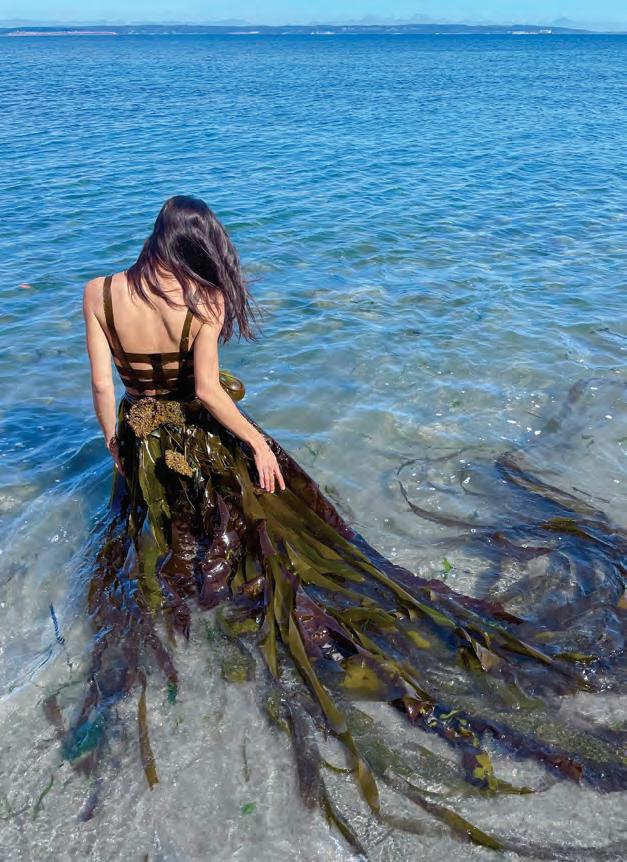
My work reflects my reverence for the natural world. I harvest and work with beautiful materials, generally considered weeds or residue. That is to say. They are not considered precious (although they are to me). Those materials include grass, ivy, Queen Anne’s lace, kelp (that I find washed up on the beach), tiny bits of moss, dried fennel, fern, scavenged cedar bark, and the occasional flower. My projects do not require me to alter the landscape. When I finish a project, there is little to no evidence that I was ever there. I work with a “leave no trace” mindset. The materials that I work with decompose after the completion of a project. Therefore, I create no waste. I generally do not have to buy anything to create my work besides gloves and clippers, although I have purchased fabric for a couple of projects, which I hold onto and reuse. I am grateful to have found a way of working that aligns with my ecological concerns and priorities. My goal is to elevate the natural world through my work, not denigrate it.

The creative process is my favorite topic of discussion. It’s my favorite thing to think and wonder about. And when I am blessed with an interesting idea for a creative project, it feels like a gift from the gods. I love listening to other makers’ stories about their creative processes, whether they
are musicians, comedians, visual artists, dancers, writers, or scientists. Anyone whose work requires imagination, intuition, and creativity has my undivided attention.
For myself, I know that I have to be looking for something. I need to pay close attention and walk around to find an idea. So there is a kind of courtship process. Very often, a certain material stimulates an idea or suggests a project to me. Sometimes it’s a specific place or landscape or something atmospheric. Sometimes the idea will come to me whole. Other times I need to nurse it along and flush it out. I mull and analyze. If the idea survives my scrutiny, I might set out right away to make the piece.
Occasionally I do a project in the studio and bring it to a location to document a model (I think of my models as surrogates, as they have an experience I wish I could have). Most of the time, I make the piece onsite and document it the same day. When the day finally comes to make and/or document the piece, it’s a big deal. It means that my schedule, my model’s schedule, the weather, the light, the season, and sometimes the tide have all come together in an almost holy (in my mind) union. And then, the whirlwind of collecting my materials (usually on site), building the piece (often directly on my model), documenting the piece, and then deconstructing the piece all happen in rapid succession. Afterward, I’m exhausted, exhilarated, high as a kite, trying to piece together what just happened, satisfied for a little while, and enormously grateful to have
I am grateful to have found a way of working that aligns with my ecological concerns and priorities. My goal is to elevate the natural world through my work, not denigrate it.
completed something I consider part of my mission, raison d’etre, and life’s work.
What are your concepts of sacredness and violation?
In trying to find the terminology that best describes the forces that have led us to our current social and environmental predicament, I’ve settled on what bell hooks describe as a white supremacist capitalist patriarchy. However, I think white supremacist capitalist heteropatriarchy works even better. This is a mindset of overarching violence and systemic discrimination inflicted upon the natural world, women, and all marginalized groups. Long and shocking histories of violence and violation have brought us to this precarious moment as we now teeter toward self-annihilation.
It’s difficult to be a sensitive person born into a cult of consumption and exploitation, and we are all required to make sense of it and survive it the best we can. My work is a practical invention that has served as a personal antidote to the crushing weight of unfettered patriarchy. It is a counterbalance to the destructive forces that consume and exploit the Earth’s resources and people. I think my work might resonate with some people because it depicts the possibility of an intact and harmonious relationship between humans and nature. Humans are embedded in nature, comfortable in nature, wearing nature, and celebrating nature. I think that we long for the sacred connection with the natural world that
many of our ancestors once knew and that we are looking for a way back to it before it is too late.
Does art need to last?
My work is temporary. It generally exists very briefly in three dimensions and is then relegated to the realm of digital photography. It’s been a long stretch for someone who identifies first and foremost as a sculptor.
Who has been an inspiration on your journey for artistic expression?
When I started having these impulses to embed women into the landscape, I was fortunate to have Andy Goldsworthy as a role model. To the best of my knowledge, Mr. Goldsworthy doesn’t work with human models, but he certainly works in nature, with natural materials, and often in a fleeting way. While I know Mr. Goldsworthy has also created largescale permanent works, his early works have inspired me enormously and demonstrated that art could be temporary. Art can melt. The tide can wash it away. The wind can blow it asunder. And it can still be art. When I set out into nature with my gloves and clippers and maybe a knife or trowel, I (humbly) feel an affinity with Mr. Goldsworthy. He is my unofficial Patron Saint of Ephemeral Creations in Nature. I like that my work eventually rots and becomes part of the landscape I hold in such high esteem. I am glad I am not adding to the clutter of many objects taking up space on this overwrought land. u
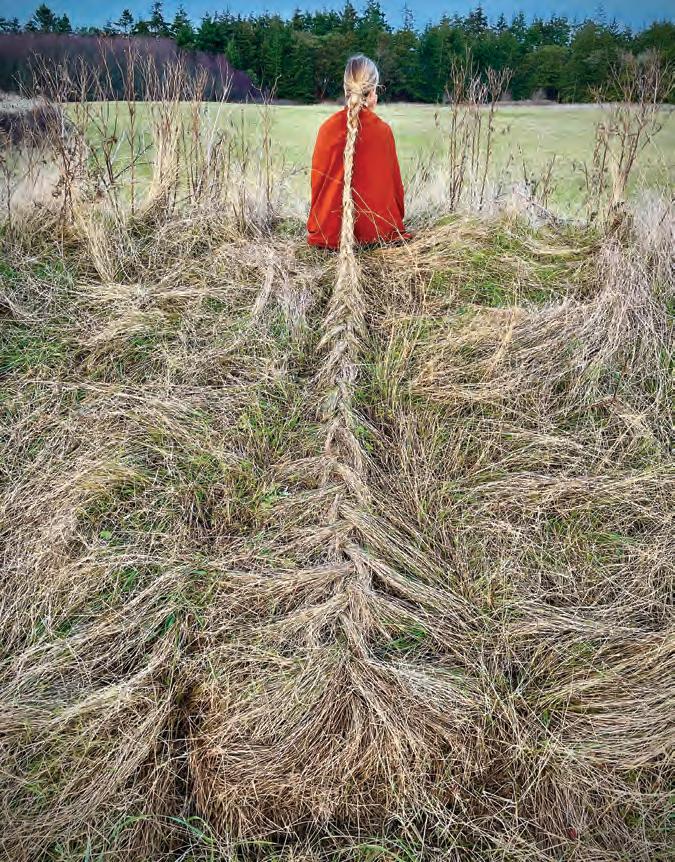

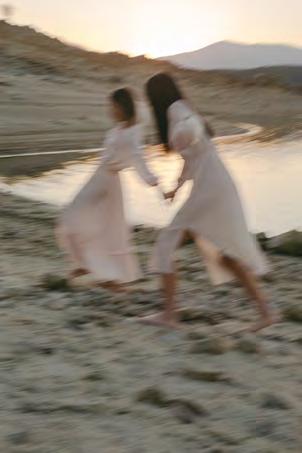
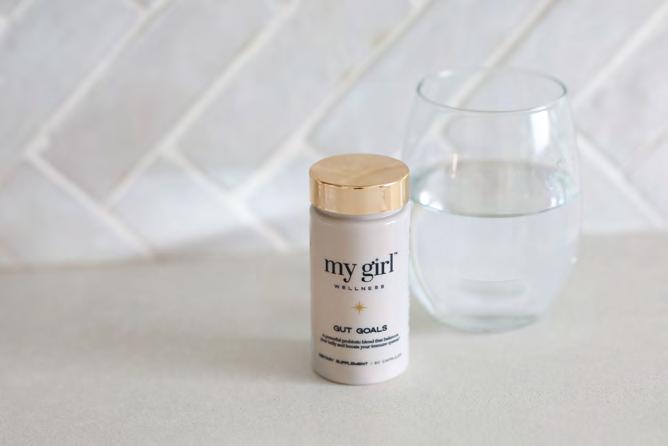


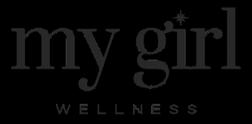
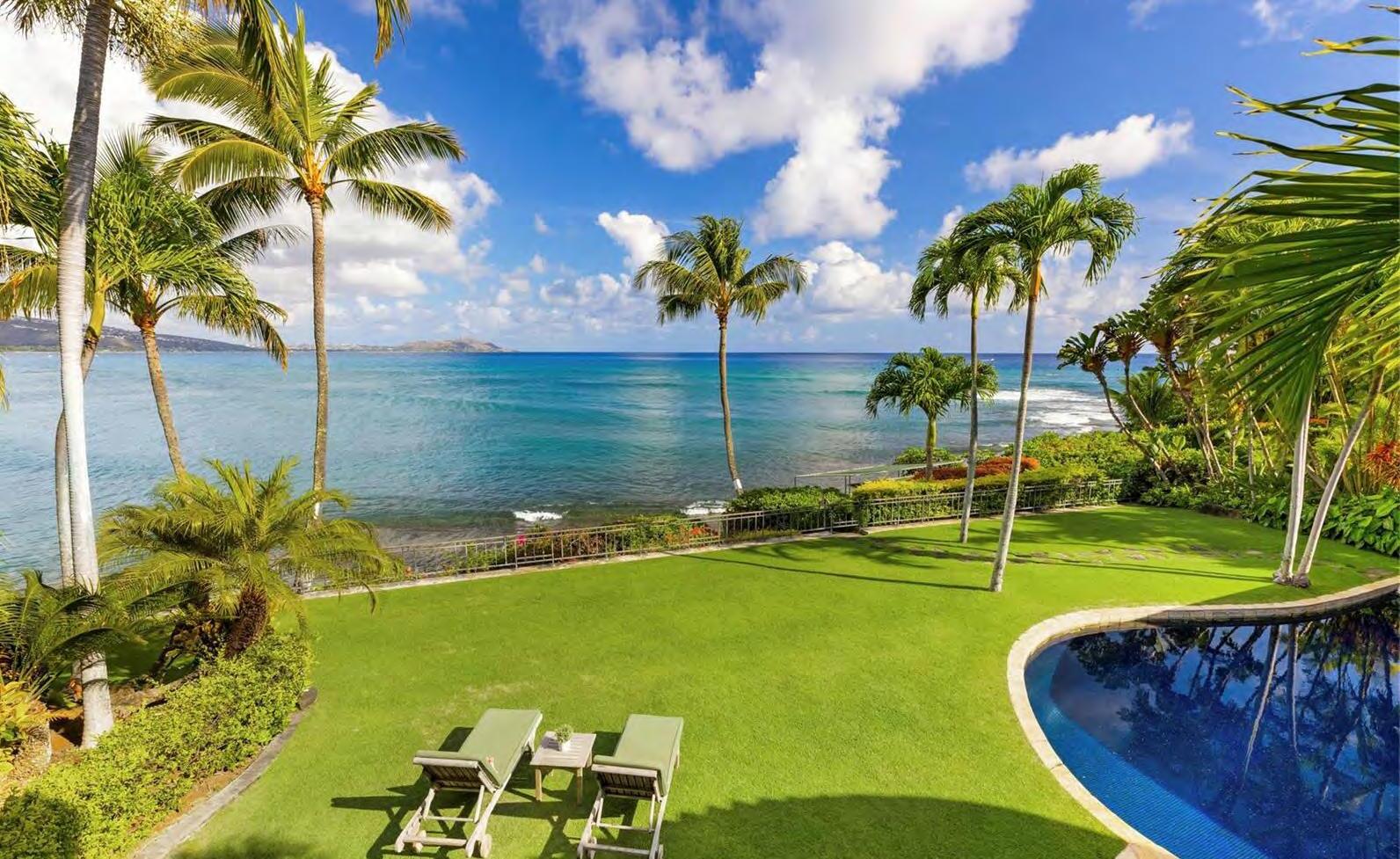



I help people make passive income from new technologies with our educational company.
Ashley Armstrong is a Canadian entrepreneur, professional spokesperson, author, speaker and consultant who is most well-known as The Hidden Rules Expert®, teaching the “hidden rules of business.” She was one of the only female authorities in the online/eCommerce industry, bringing her expertise to TV as a regular guest expert on a nationally syndicated Emmy Award-winning show, The List TV, on CBS, NBC, ABC and viewed by 40% of the United States.
Armstrong partnered with ecommerce sales expert Dan Hollings, which achieved sales of over $57 million in only seven months, launching the world’s most popular crypto training program, The Plan, breaking digital marketing records and onboarding members from 130 countries. In her spare time, she focuses on championing women over 40, especially mothers, breaking ceilings in life and business.
I am from the very isolated Peterborough in Ontario, Canada. My childhood “friends” were whatever animal I could catch, and I kept myself occupied by making clothing, jewelry, and tree forts.
My father was not around much in my younger years. He was a “racer chaser,” a ski technician for the Canadian National Men’s and Women’s Downhill Ski teams; he also was a manager at Atomic Sports Canada. I lived with my mom, aunt and uncles, and grandparents. My mother was also very distracted with her time and left me to raise my little sister. I felt like a mom at eight years old. It was hard being a young child in a parenting position.
My father traveled the world with athletes taking them to the Olympics. I grew up in a very structured, mentally focused, athletic family. I watched the athletes grow their careers, train, and observed their stumbling blocks.
With my father being the man he was, I was thrown into a sport I didn’t like as a child, but I loved skiing because I was better than everyone else. I was a natural athlete and always ended up on podiums for any sport I competed in. I had to live up to expectations and win. At that time, the belief was that if you didn’t hurt yourself, you were not trying hard enough—the typical 1980s sports mentality. Despite being terrific athletes, everyone in my family seemed to have issues with learning. Regarding formal education, we were a square-peg-round-hole family. My grandmother understood my challenges with school and helped me feel loved, understood, and normal. She was a college professor, and one of the first to introduce the concept of learning disabilities to people in Canada.

When I got into school, I did not have the foundation and stability that others had with their classwork. My parents wanted my sister and me to be bilingual in French and English. However, I couldn’t write or read English, let alone French. So, in grade 4, I had to start all over again at the level of grade 1. I was put into a class with kids with learning disabilities.
In high school, I was constantly put in a room where I felt like I didn’t belong. It was a massive struggle because I was always treated like I was stupid. Thank God for my sports abilities - I kicked everyone’s butt on the field, so the other kids knew better than to make fun of me.
My friends excelled at school, and were placed in general or advanced classes, whereas I was in lower-level classes. This caused my first deep depression in Grade 9, because I was separated from my friends.
I worked my butt off going to summer school every year with tutors, and I went back to high school after I graduated to take more credits so I could qualify to apply to college. When did you find out where you fit in the best?
I’ve had a few epiphanies in life. I was a skier, competed at the International Ski and Snowboard Federation (FIS) level, and went into coaching and training. I coached in all four disciplines within the snow sports industry, ski racing, half-pipe, park, and snowboarding. One of the only few females at the time, I ran ski schools, trained individuals, and was a representative for a ski company.
One of my most significant, eye-opening experiences happened in Whistler, Canada. There was an important event where ski companies would demo skis and introduce new equipment. I was the only woman in this group of 20 guys. And one of the guys who has known me since I was a child working with my father told me, “You’re a girl, you don’t belong there, you shouldn’t be here, and my son should have your job.”
It was then that I asked myself, ”Why am I staying in this sport that I don’t love? It isn’t me. It isn’t my passion.” I walked out of that event and did not step on snow again for 17 years. I was done.
I then questioned myself, “Who am
And what do I even do?”
And at that time, I took any job I could and started selling timeshares, where I met my future husband, decided to trade the snow for the sand, and moved to Mexico.
My first child was born in Cabo San Lucas. I was a young adult living in a country where I barely spoke the language and was unemployable. None of my skill sets were there. That lit a fire - I began to focus on increasing my education and staying relevant.

I decided at that time to set up a future for my children that would be better than my upbringing. My journey was unique and different. When I was almost 30, I started a small business out of my home. I became a local natural health practitioner and a childbirth educator. I created things that didn’t exist in the town where I lived.
I wanted to make my business bigger, so I moved the business online and learned about making money in different capacities from anywhere in the world.
How much strength and success did you gain by believing in yourself?
It’s a foundational thing - if you can’t run with me or as fast as I can, then you need to get out of my way; I’m going to blow you over. It came from my influence in sports originally, but I have come to apply it in many areas of my life.
My faith has always been strong. For me, there never has been a question of if taking a chance would work. I believe that you can get what you want as long as you keep showing up and doing the work, but you also must let it go at times and let the universe provide. What took you to your next best success in the story of your career?
I decided to move everything online, ‘the early years.’ I had my girls, and now my most significant focus was preparing them for when I was dead.
People asked, “What are you doing?” I told them - this is how I operate. I am preparing my children for a life without me. I have done that since they were born. When my oldest was four years old, I decided that I was going to write a book. No one thought I could do it! I ended up publishing six of them. My passion project turned into books about my kids and for my kids, about life lessons, how to be an entrepreneur, how to deal with bullies, how to meditate, and how to ground yourself.
It was my first kick in the butt, the first thing that made me realize that I could do anything and make money from anywhere. I had discovered how to make my own money my way. The idea of being online and selling something when I was sleeping was almost unbelievable. I thought if I could do this with books, I could do it with other things. So I began to manufacture products.
Have you always been a leader?
I’m going to be the best, and I’m going to be the leader; no one tells me what to do.
I’ve always been the teacher, the trainer, and the leader. I guess it is from the maternal instinct I discovered while raising my younger sibling from a very young age. I created the Cabo Moms group when I had my kids because I didn’t have a community. I started the community online, and opened it up to all local mothers; we now have over 2,000 members. It’s amazing! I’m always trying to create and cultivate whatever I see is missing. Someone has to take charge, and when I’m passionate about something, I usually end up being that person.
Through my mom’s groups, I helped many women make money from home, start local businesses, online businesses, or start manufacturing within the country. I went from nurturing my kids to nurturing and encouraging women by helping those women accomplish their goals.
What supportive advice and guidance would you offer to selfsacrificing, career-driven individuals, especially women?
When it comes to self-sacrificing, that’s an interesting term for me.
The word “sacrifice” to me means hardship, difficulty, and pain. And I think life naturally is all those things, no matter what. It depends on what mood I’m in, or at what point in life I am to either accept that word or not.
When it comes to business however, it’s more about the whole concept of balance. Is there such a thing as balance in business and life? I don’t believe there is, especially in parenthood. You make the best choice at the moment that you’re in for whatever it is that you’re trying to accomplish. And that’s it.
As a founding partner, we launched Dan Hollings Crypto Program in the last two years. It was the largest digital marketing launch ever, breaking records.
We generated 57 million in seven months, which was hard to embody. When you hit these big goals, you ask yourself, “How can I do this again?”
It was life-changing and scary, and I went through a massive entrepreneurial depression throughout that success. I would think, “I have everything I need and want, and every success. So how can I be depressed, sad, or upset when everything is so great?”
I’m still coping with it, trying to figure out its meaning and how I will leverage it.
The next big focus is to build business bigger, better, and help more people than I’ve been able to help this far.
I am also planning to write another book, do speaking engagements, and eventually host a TV show in the next three-to-five years.
My next book will focus on the value of women in their 40s; we are not trade-in-able and are way more valuable than society might imply. We are statistically the most depressed demographic, and I aim to change that for my daughter’s future and create a positive influence for business leaders toward change. Part of this plan is to share it as a talk on a TED X stage.
Do you have a favorite motivational quote?
My father often said, “Just make sure you’re always flexing your failure muscle.” That’s the quote we’ve coined since I was kneehigh. It means that you need to lean into the fact that failure is your best teacher. Failure is a positive word. We use failures as stepping stones to reflect, detect, and correct. Just keep going. It is important to always strengthen your failure muscle like any other muscle in your body.
Who has been a significant inspirational influence in your life?
My family. My mom, my dad, and my matriarchal grandmother have always inspired me. But to be quite honest, the biggest inspiration in my life is me. I have done everything I possibly can to live the best life ever. If I die tomorrow, I will die happy.
What is the best way for people to find and follow you?
Instagram: @AshleyArmstrong.HiddenRules
TheHiddenRulesExpert.com u
















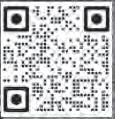
Zarifa Ghafari is an Afghan activist, politician, and entrepreneur. In July 2018, she became the mayor of Maidan Shahr, the capital city of the Wardak Province in Afghanistan. She is one of the first female mayors in Afghan history and the youngest, having been appointed at the age of 24.
Zarifa studied higher education in India and started a very popular radio station aimed at women in the Wardak region. Known for her efforts to advance women’s rights in Afghanistan, Zarifa experienced an untenable career in politics. After being appointed Mayor in July 2018, Zarifa became a role model to women in Afghanistan. In 2021, she became the Director of a Department of the Ministry of Defense of Afghanistan. She received several international awards, including being named to the BBC 100 Women 2019, a list of inspirational and influential women from around the world. After the Taliban took control of Afghanistan’s Government in mid-August 2021, Zarifa fled with her husband, mother, three sisters, and four brothers. She now temporarily resides in Germany.
“I love my country, I believe that if I continue to fight, Change is possible.”
Zarifa, your incredible journey has required extraordinary strength! How did it feel to look at your life so closely while making the Netflix documentary, In Her Hands?
The production of this documentary is very close to my heart. It’s the story of a woman coming out to an unaccepting society, of a woman’s voice and presence in a leadership position. It tells the story of a girl starting her career by fighting her own family for approval within her community rather than having support for her dreams.
The first part represents the entire population of women in my country. It is the story of every woman. And the second part of this documentary shows the divided population that supports this level of treatment of women and the others who don’t.

While I was the mayor it was a strange reality knowing that even my colleagues were related to the Taliban, who wanted to see me go including the most trustworthy person on my team, my driver. I discovered he was involved with jeopardizing my security at certain events.
Afghan women are victims of conflict, wrong policies, and war politics. But they also are symbols of resilience and commitment. I’m not just talking about myself. I am talking about my neighbors, my community, and every woman.
I am proud of this documentary because it’s the first time you can see an accurate picture of Afghanistan without edits, or any story put inside the actual events. There is nothing fake about the life of an Afghan woman in this documentary. It’s the real picture of that society for the world to see.
“I am here to be the voice of the people in Afghanistan who are not able to come out of their houses, those women who are not able to work nor to speak out.”

We started filming in January 2020 and ended in May 2022. The entire two-plus-years of the journey were filled with ups and downs; there were sacrifices, laughter, and happiness. It took over 450 hours of footage, and only 93 minutes of it made it into the documentary but I was there for every second. I know what happened, why, and how.
What is the earliest age you recall standing up for your rights?
I started realizing how different life was for me compared to my brothers and the men in my community by the age of six; I noticed the way my mom and dad spoke to me and treated me. I was not allowed to sit with my father’s colleagues. I was not allowed to go with my dad to parties, to meet people, or go to the market, but my younger brothers could. I was not allowed to walk anywhere outside of the house, but my brothers were, they were not restricted from anything.
Starting from that point, I realized it was a different life for me. Growing up, I began to understand it went beyond the walls of my house, and these restrictions were not just between my brothers and me. This was the behavior of everyone in the entire community where I lived.
From a very young age, I knew someone needed to start something and do something that could bring positive change to the community. And then I realized that I couldn’t change anything if I could not change my family’s mentality toward my abilities, work, and personality. I knew that was where I needed to start first.
I argued with my father often; I blamed him for being a part of this community. I couldn’t see how my dad wanted to protect his daughter then. I came to understand him more when I started my University, graduated, and became involved in the community.
My father felt that if I did something considered ‘wrong,’ he would be dishonored by the community, which has its own set of consequences. This was the only reality through which he knew how to navigate.
Once I became an adult and finished University, my father saw the woman I was becoming and realized that I could stand up and fight for my rights and the rights of others. He knew I could manage, handle, and tackle everything in my way.
When did your father begin to support you?
My father started supporting me and having my back when I went out into the community to discuss the injustices the women endured. He would stand next to me every time I was in a big crowd with a smile on his face. His eyes were full of love and pride.
I started addressing issues with my community, other family members, close relatives, and friends. It has been a challenging walk and fight on an even tougher road. These changes need an immense amount of support from the community.
It was becoming clear to me that I should be on a bigger platform, so I decided to run for mayor.
Winning the mayoral position was bittersweet. I was making progress in the changes that needed to happen and then two years into my term and then I lost my father at the hands of the Taliban, on November 5, 2020. They were sending me a message. Before they took my father’s life, they frequently informed me how much they disapproved of me and my
position as a woman.
My father losing his life because of my path is my biggest and only regret. Losing him brings me more pain than anyone could imagine. The only thing that brings me peace around it is the conversations he and I had before he died about how he trusts me with my decisions.
I have no choice but to keep going forward. I keep standing strong.
Both joy and pain can fuel our determination in life. I appreciate your realness in this interview. I believe it shows even more of your strength and beauty.
I believe that when you share from the heart, everyone will understand you more.
Tell us about your determination to be educated as a young girl and when you discovered that would be a way to help save your life. When I was a small girl, one of my family members, my paternal aunt’s husband, was a very good man and an ambassador. When I realized he was an ambassador, I started dreaming of being one when I was older.
I knew to achieve that, I needed to go to university and have a degree. So, I became obsessed with achieving an education. Being educated became my best weapon to support and uplift my community back home.
I believed that if I helped improve the education within the families, especially for a mother, she would never raise a child to be a terrorist. To show her boys that they don’t need to be a destroyer or someone who does terrible things to the community. I believe that an educated mother can raise a good child for society.
My focus and future campaigning for Afghanistan was for more ongoing education for girls and women.

After my term in office was abruptly ended due to the reinstated Taliban rule in Afghanistan in 2021, I felt like I still needed to learn and pursue a master’s degree in human rights and economics.
What is the main driving force for you to be free of limitations and to acquire independence for yourself and other women?
This is a tough question to answer because, especially in a place like Afghanistan, it doesn’t matter how big the title is for your family or how open-minded you and your family are. It’s the community that will put you in a cage.
Even in a brief moment when my environment appeared to be accepting of the degrading circumstances, there was always an overwhelming sense of being surrounded by hopeful whispers praying for change.
When I look back, that was the start of my driving force. And I made it my life’s mission to turn up the volume on those whispers and turn them into a voice that is to be heard loudly and clearly by all women who are imprisoned in any circumstance.
What do you believe are your strengths as a woman?
Sometimes I feel as if there are two of me in one body. I am clear on who I am; I am friendly and direct, and I stay committed to my values, but at the same time, the other part of me is so emotional and I can easily feel my heart being punched.
But most of all, believing that I have no limitations in or around my life is my ultimate strength!
What inspires you every day?
The biggest inspiration for everything around my life is the lives of the women around me, starting with my maternal grandmother.
My grandmother is a wonderful and strong lady. She was 27 when she became a widow. She had five children and was six months pregnant with her last child when my grandfather died. He was a principal of a school, when the Mujahidin kidnapped him and all the other teachers, killed them, and threw them into a river. The reasons for why they did this, to this day, are still unknown.
My grandmother, from that day, started only living for her children. She raised three sons and three daughters with love, courage, and determination, and she made sure that every one of her children was educated to create good lives for themselves.
If you sit with my grandmother today and have a conversation, you will believe that she has a master’s degree, but she has never been to school.
She’s a remarkable woman with such electricity! She educated herself to this level in an era with life-threatening
consequences if her pursuit of learning were discovered. There was no internet, no facilities, and no resources. She did this on her own and tackled all life’s challenges by being just a woman with a fierce and determined belief in having a better life.

All women in Afghanistan are symbols of incredible courage and determination because I have seen it in every community of the country. I feel I have a huge responsibility to keep the same values I have received from previous generations of women in my country.
What are you creating in 2023?
In 2023, I’m expecting my first child. I want to dedicate a good human being to the world, especially to my country and community.
I am also motivated to create a significant bridge between the Afghan community, Afghan women, and the world.

I am also completing my second book which is about the lives of Afghan women.
What is the best way for people to follow you and to keep updated with your mission?
My website is: www.zarifaghafari.com
Twitter: @Zarifa_Ghafari u

Mitzi Perdue, MPA, F.ISRM, Senior Fellow, Bosserman Center for Conflict Resoution, Anti-Trafficking Advocate, Award-Winning Author of MARK VICTOR HANSEN, RELENTLESS – Available on Amazon, all Royalties Benefit Ukraine.
• An Amazon #1 Bestseller
• Winner, Best Business Book 2022, 3 million-member OnLineBookClub
• Winner, Southern CA Book Fesitval, Best Biography 2022
• Winner, Literary Titan Book Award 2002
• Winner, New England Book Festival, Best Biography 2022
• Book of the Day, OnLine Book Club, 2022
• Online Book Club, Chairman’s Choice

• Top 100 Business Books, C-Suite Network
Mitzi, tell us about your backstory from childhood to where you are today. What made you, you?
Well, certainly my parents. Both parents were very focused and intentional on not having spoiled children. They didn’t want us to be entitled. They made sure that even though my father was the co-founder and president of the Sheraton Hotel Corporation, they still ensured that our education included time at public and private schools.
Up until the age of eleven, the only clothes I ever got were hand-me-downs. There were 5 of us, and I was the youngest. I remember being excited the first time I ever had something that was not passed down to me from a sibling. It was a pair of gloves.
My mother said that she wanted me for once to have something that was just for me.
My father was a very philanthropic man. I remember when I was a child, maybe age of ten, I walked into his office in our house, and he was busy with books and reading letters.
I asked him what he was doing. He said, “I’m answering requests for charitable contributions.” And then he said, “The greatest pleasure my money ever gave me is giving it away.”
My mother was equally generous. She pounded into our little minds that it was our responsibility to give back to the community. That life wasn’t just a one-way street. A lot of nice things came our way. But it was essential to give back. My brothers and sisters and I owned that as a part of our life’s path.
When I became an adult, it was important for me to achieve goals on my own and not take advantage of my family name. Now at the age of eighty-one, I’m not sure I agree with that approach. I think it was almost foolish to throw away some of my aces. Nevertheless, I chose lines of work where I had to earn it on my own. For example, I became a writer. If you’re not a good writer, it doesn’t matter who daddy is; you won’t stay employed.
I became a syndicated columnist, first for Capitol News in California. And eventually, for Scripps Howard News Service, which is national. I also applied for and auditioned for jobs on television.
Eventually, I had a show called Mitzi’s Country Magazine that was syndicated to 76 stations. My confidence grew knowing that I didn’t get the television spot because of who daddy was. I got it because I auditioned and was chosen. I was quiet about my life and up until my late 40s, I did everything I could to hide my family background.
The world has been paying attention to Ukraine since the beginning of the war that began earlier this year. What led you to visit Kyiv this year in July?
Kind of a tenuous thread that led to it. But, at least digitally, I got to know a person who fled Odessa, Ukraine and was living in the United States. But before coming to this country, he spent at least a couple of months in Poland and while there he saw
human trafficking among the refugees from Ukraine. So, I wrote a story on what he had observed, and it was published in Psychology Today. I write a blog for Psychology Today. on human trafficking.
The article had human trafficking in the title, and it also had Ukraine in the title. And somehow, it came to the attention of General Andriy Nebytov.
He is the head of the police for the Kyiv region, which extends across a very large region from the capital city to the border of Belarus.
My article about Ukraine and human trafficking came to his attention. And it resulted in a zoom call, in which he invited me to see for myself of what I had been writing about in his country.
Ten days later, I was in Kyiv. The night I got there, there was an air raid, and I spent my first night in a bomb shelter.
As a guest of the Kyiv police, I also visited Chornobyl, areas where Westerners aren’t normally invited. And we’d be traveling at 80 miles an hour to go thru it, never stopping.
There were two reasons for this. One, we could be exposed to radiation and become horribly sick. But I was told that we won’t absorb a significant dose if we go through the area very fast. After we drove thru the area, we were checked with Geiger counters to ensure we were safe from radiation poisoning.
The second reason for driving around eighty miles per hour near the Belarus border through villages was because if we drove slower people on the Belarus side of the border could easily target us for an attack.

While I was there I wanted to interview members of the Kyiv region police department. The incredible men and women who are in a war-torn city were still providing protection and help to its citizens wherever they could.
General Nebytov told me I was the first Western journalist interested in how the war was affecting
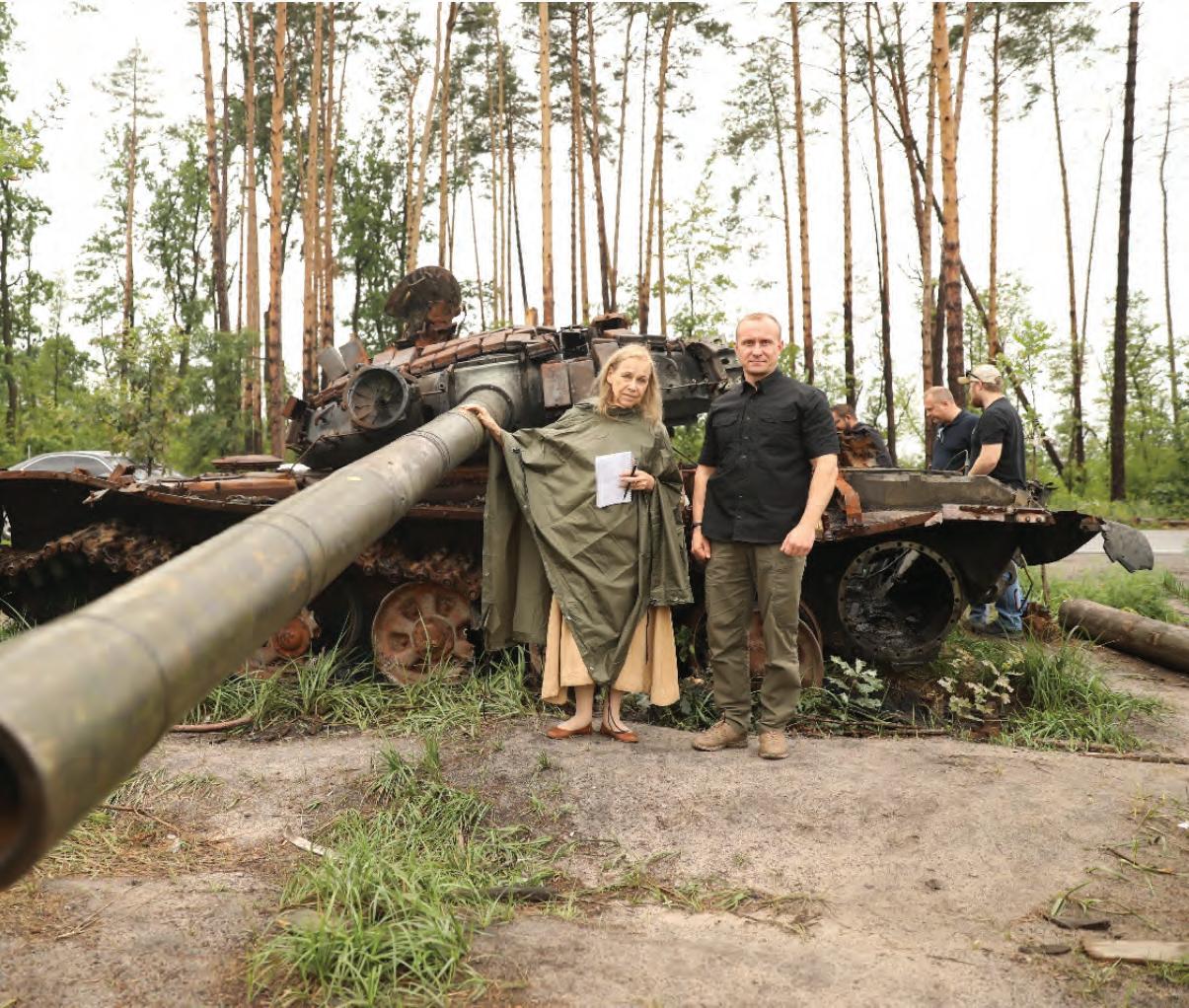
the police. The first thing that Russia did was bomb the police stations and steal the police cars. They destroyed all police records and police communications.It’s a psychological operation designed to demoralize the residents and make resistance much more difficult.

The Russians deliberately emptied the prisons. This means that the murderers, the rapists, the arsonists, and the looters were roaming free, and the Russian’s goal was to keep people demoralized by not having them be able to call on the police to serve and protect.
Once I returned from Ukraine, I wanted to do what I could to work with law enforcement in this country, to develop a bridge to help law enforcement in Ukraine.
I have been a part of creating organizations where American law enforcement people will be visiting Ukraine, learning who their counterparts are, learning what’s needed, and how they can help. And I’m incredibly proud of that.
The biggest thing that I learned had to do with human trafficking. Traffickers from throughout the world always choose the most vulnerable people. With Ukraine and its millions of refugees, there are tens of thousands of people with no money, no home, and who are emotionally traumatized.
When women and young girls more specifically cross the border thinking they are safe from bombs. Instead, they are being approached by men who appear kind, offering a warm meal and shelter but they must hurry because the van leaves in 10 minutes. Then these women find themselves hauled off to where the traffickers take control of them. Odds are, these women are going to be trafficked. For the rest of their lives, they may be forced to have sex with a dozen strangers every night.
Did you witness trafficking taking place when you were there?

Yes.
When I was first entering Ukraine, I entered from Poland. We took a car from Warsaw to the border at Medyka, Poland and at this border town of Medyka, it was a 10-minute walk to the border crossing.
An intelligence officer I was with pointed to two pretty girls who were talking with a couple of attractive-looking guys who were helping them into a Mercedes Sprinter van. The intelligence guy said, “Those guys are traffickers. By tonight, the girls’ lives will be pretty much over. They’ve just made the worst mistake of their lives.”
What we witnessed was a heart-wrenching tragedy that haunts me to this day. What was happening was far enough away that there was nothing we could have done about it.


General Nebytov has a way. At the border crossings, the men, women, and children crossing the border are so vulnerable. They’re scared, they’re traumatized, and they’ve lost everything that makes life feel normal. The General wants to create shelters for women where they can rest and get advice so they don’t make what could be the very worst decision of their life. To help finance this, I sold my engagement ring, a near-perfect large emerald for $1.2 million, and a good bit of the proceeds are going to help with the General’s project. All of the proceeds will go for humanitarian assistance in Ukraine. The emerald in question was an engagement gift from my late husband, and it came from the treasure ship Atocha, which sank in 1622. I can’t think of a better use of something so precious to me, and further, I know my dear husband, who was the most philanthropic person I ever met, would completely approve of this use for the ring.

We can do something about landmines. One of the horrors of Russia’s war against Ukraine is they’re covering an area that’s so far, the size of Florida, with millions of land mines. They booby trap playgrounds and childrens’ toys, they booby trap houses so that when, for example, you open your dishwasher, you activate the pin of a grenade, and you’re killed. I’ve seen an estimate that 10% of Ukraine’s prime agricultural land has been mined, meaning the farmer who wants to plos his field risks having his tractor blow up, or worse, he may be maimed or killed. The result is, he doesn’t farm. The Russians are also mining the sea lanes to undermine Ukraine’s ability to support itself through trade.
I’ve started a crowd-funding campaign to help provide funds for the world’s oldest and largest demining organization, the HALO Trust. The goal is to raise $300,000, and when we raise that much, we can pay for a team of 18 people to clear mines for half a year. It will make a huge difference in everyone’s lives, when villages or farms or free of mines.
One of the special things about the crowd-funding organization, DonorSee.com. is, when you donate, you get a weekly video report so
you can see how your money is being spent. I’m loving this because I’ll get to communicate with people about how its going. For example, I’ll be attending de-mining school in Ukraine, and I’ll have reports on how it’s done, including mine-sniffing dogs, robots, and drones! It’s exciting stuff and I’m eager to share it with everyone!
What do you feel is the most important thing to know about Ukraine and what that country is experiencing right now?
These are good people who are fighting for their national lives. If Russia prevails, there will be cruelty on an unimaginable scale because we already know what Russia has done in the areas that they did conquer. I have visited mass graves where 300 to 400 people were shot after torture. Another reason Ukraine has to prevail is that we know more than 200,000 Ukrainian children were kidnapped and taken to Russia. They need to be brought back to Ukraine. I hope that people support Ukraine with everything they’ve got. These are good people who didn’t ask for the misery that has been inflicted upon them.
What is the best way for the readers to find and follow you and keep updated on everything you’re involved with?
It would mean the world to me if readers would go to DonorSee. com/Ukraine and donate even $5. I’d love to have as many people as possible help with the mine-clearing project, partly because it’s the right thing to do, but also, because each person who donates is showing the people of Ukraine that we in the West care! Further, for anyone who makes a contribution, you’ll have insider information on what’s happening in Ukraine, and you’ll get the enormous satisfaction and maybe even joy of knowing that you really, really, really made a difference in people’s lives! So, come to DonorSee.com/Ukraine and make a donation in any amount! u
 6.25 carat octagonal step-cut emerald ring was given to Mitzi by her late husband Frank.
6.25 carat octagonal step-cut emerald ring was given to Mitzi by her late husband Frank.
An Interview with Kat Mische Elle
Melanie is a sought - after empowerment + mindset coach working with individuals and teams across the country to align and integrate their personal and professional spheres for increased success and abundance without compromising their joy. She is also a successful writer, speaker, and Professor of Sociology and Women’s Studies and has written and/or contributed to over 9 books on empowerment, personal transformation for collective liberation and cultivating resilience. Combining over two decades of professional and personal work, Melanie integrates her backgrounds in mindfulness and embodied wisdom with her academic expertise and advocacy work. In this way, she offers a holistic and unique pathway to personal freedom and prosperity, one that is customized and designed to each individual. She co-founded the “Yoga and Body Image Coalition” in 2014, one of her many efforts to create community, encourage collaboration and diversify the larger cultural narrative. Her TEDx, “Conscious Empowerment & Collective Liberation,” is now available online.
Melanie, when was the moment you first established a connection with yourself?
One of my most significant memories is being five years old playing in my grandparent’s backyard underneath the giant trees. I remember looking up at the sky and experiencing this poignant moment of feeling in touch with something much larger than myself. I could see myself, my consciousness, hovering above the scene and I was profoundly moved by my human self on the ground. It felt expansive and wonderous. I sensed that one day I would step into some enormous shoes and that something extraordinary was waiting for me.
What did your early years look like and how did it impact who you are today?
My parents were both hippies, but my father was American, and my mother German. After I was born, we moved to Germany to be closer to my mother’s family and lived there for several years until it became too challenging and taxing for my father. As an American who did not speak the language well, it eventually became hard for him to find work. Plus, the villages in Germany were not very welcoming to my hippie parents at the time.
So, we moved back to the United States. I felt completely ripped out of the environment that felt comfortable, loving, and warm. I felt deeply connected to my roots, family, and the land. California was nothing like the small village in Germany. The entire experience was jarring and created turmoil for me. And yet, it allowed me to see and experience an additional perspective that people, communities, and societies don’t all live the same way.
What significance have mentors had in your success?
Mentors have always helped shape my life. In my recent TEDx talk,” Conscious Empowerment and Collective Liberation” (available online), I describe the journey I spent during the year leading up to

finding my first mentor in community college, my professor of Sociology of Women, Pat Allen. Before being introduced to her class, I was adrift and disillusioned bouncing from place to place trying to find myself. I landed in her class after a harrowing drive-by shooting that inspired me to go back to college and find meaning and purpose in my life.
Pat introduced me to sociology, media literacy and feminism. All three theoretical perspectives provided explanations, justifications, statistics, and research to unburden my experiences and feelings that up until then I had blamed myself for. This newfound awareness allowed some of the shame and guilt I’d been carrying to begin to slide off my shoulders allowing room for possibility.
It was liberating! Like a lightning bolt, a thunderclap—the most resounding and clearest moment of my life. I wanted more of this sense of agency, possibility, and the ability to make conscious and deliberate choices on my own terms while contributing to the collective. Through Pat Allen’s mentorship and belief in me, I knew I could be a leader on my own. I transferred to a four-year university to become a professor. When I didn’t trust myself, I knew I could trust Pat and what she saw in me. Eventually I became a professor of Sociology and Gender/Women’s Studies. People who had known me in my early teens were shocked that I could create that arc of change in my life. I have Pat Allen and all the mentors who guided and supported me over the years to thank.
I stepped into my first yoga class in 1996. I discovered that my yoga, meditation, and mindfulness practices were natural supplements to what I had been receiving from my sociology and gender/women’s studies classes and media literacy education. Both my embodied practices and my critical awareness from my years as a student allowed me to raise my consciousness. In my first book, Yoga and Body Image: 25 Personal Stories About Beauty, Bravery and Loving Your Body, I sum it up by stating, “Feminism freed my mind, yoga freed my body.“

I had been practicing for about four or five years when I noticed some interesting trends occurring, not within the practice itself, but within the culture. I was alarmed by what I was starting to see. The advertisements and content in mainstream yoga magazines were beginning to change. It was eerily similar to what I had always seen in the diet, fitness, and beauty industries. I began to witness the commodification and objectification of yoga bodies, yoga practitioners, and the practice itself. I thought, “Okay, this is not acceptable to me.”
Yoga and meditation had always been a saving grace for me, a sacred space where I could step out of the noise, confusion, and chaos without all of the advertisers vying for my attention, telling me who I should be and what I should want. This was the only place where I could truly learn how to be quiet and listen deeply. Now contemporary society, capitalism, was
Photo by Sarit Rogerscoopting and this sacred practice.
I thought, “Okay, I need to do something. I have all this training about privilege, oppression, systems of domination, and internalized oppression. I know how this operates, and I know how to begin to challenge it.” So I did. How did blending sociology and yoga complement your life’s direction?
After the alarm bells went off in my head as these new trends began to appear in the culture and business of yoga, I began to officially merge the two things that had made the significant shift I was experiencing in my life. I had always seen them as the same thing – raising consciousness in order to be better and do better.
I began to use my academic background to write and present at sociological conferences around the country. I presented papers such as McYoga: The Diet for Spiritual America and The Rise of the Yoga Celebrity. I employed various sociological theories around culture and macro systems of oppression to analyze what I was seeing within a practice from India that was being appropriated and mutilated by western consumer culture. Many individuals in the academic world felt that this was a fluffy topic and not something to be taken seriously. But I continued to do my work.
In 2010 I critiqued an online yoga blog for its distorted representation of the women’s movement, and as a result, the blog asked me to write for them from a feminist perspective. I took that opportunity because I understood this was where I could make a bridge. I talked about wellness, yoga, and meditation in academic spaces. I knew it was the right time to bring critical consciousness and theoretical research to deconstruct and analyze what was happening into the wellness space.
Platforms such as Facebook and Twitter were only a few years old in 2010 and yoga, mindfulness and wellness communities were just starting to appear online. I was one of a few who were the first to talk about how sexism, racism, commodification, sizeism, ableism, ageism, classism and heteronormative values and norms were being produced and reproduced within these communities. As is common when at the forefront, these critiques were met with quite a bit of backlash and pushback.
completely supported what we wanted to convey. About a year before the book’s publication, I began to see many of the topics our contributors and I wrote about in the book reduced to slogans and catchphrases such as “love your body.” While I could appreciate the sentiment, I was concerned that the political undertones and collective work was being reduced to nothing more than a catchy hashtag. Having studied social movements, I knew all too well that mainstream culture and media has a long history of co-optation. It’s like, here’s something to capitalize on, something else to sell. So, before the book came out, I felt compelled to create a coalition where we could aggregate our voices to actively agitate and educate as a pathway to social change.
I also knew that there were other people, not only across North America but all around the world, who were also thinking and feeling the way my colleagues and I did but were not finding like-minded people. An additional intention in co-founding the Yoga and Body Image Coalition was to create community connections and solidarity.
There were and continue to be a lot of challenges from cultural appropriation, commodification, and objectification to accessibility. That was our work and our mission… to create change. And while there continues to be work to do, the wellness industry has radically transformed beyond what we could have imagined back in 2010. There are conversations and actions being led by dynamic leaders around cultural appropriation. Ad campaigns and representation in yoga publications and festivals are more likely to feature a diversity of sizes, ages, abilities, races, gender identities, and sexual orientations.
When we can tap into the power of the collective consciousness, we can do some extraordinary things.
The work my colleagues, allies and I have done to help reshape the conversation and imagery in wellness spaces and beyond is evidence of how much power we have individually and collectively. We can absolutely reject, resist and reshape the world around us.
How
Many of the neoliberal white people who came into yoga and wellness as a form of escapism or to let the “universe take care of everything” didn’t want to hear any critiques of sexism, racism, ableism, or ageism. People made it clear that they didn’t want to have that conversation within yoga and meditation spaces – or anywhere else, to be honest.
Despite the resistance, I began to build incredible relationships with incredible, like-minded people doing deep and empowering work who became contributors in the first anthology I published with my co-editor, Anna Guest-Jelley, Yoga and Body Image: 25 Personal Stories About Beauty, Bravery, and Loving Your Body (Llewellyn Worldwide, 2014). We were clear that we would not publish the book if we had to depoliticize or diminish the truth we wanted to share. We were also clear that we did not want a cover image with the traditional stereotypical image of a thin, young, and flexible white woman practicing yoga. It was the most empowering and encouraging experience to have editors and a team who
My sociological, gender/women’s studies and media literacy education, as well as my mindfulness and embodiment practices, social justice work, and, most importantly, that first awakening I had as a young girl made it clear and demonstrated that we all have much more power, agency and possibility than the stories we’ve been told.
Remember that it is not your fault if you feel displaced, invisible or disempowered. That was huge for me, recognizing it’s not my fault. I’m not the problem. These systems of oppression are the problem.
Liberation came from the understanding that I have choices. YOU can make empowered and conscious choices, too. Think about:
• What do you want to challenge?
• What do you want to create and share?
What is the best way for people to find and follow you?
Melanie C Klein | melaniecklein.comInstagram: @melmelklein | LinkedIn @ Melanie Klein u


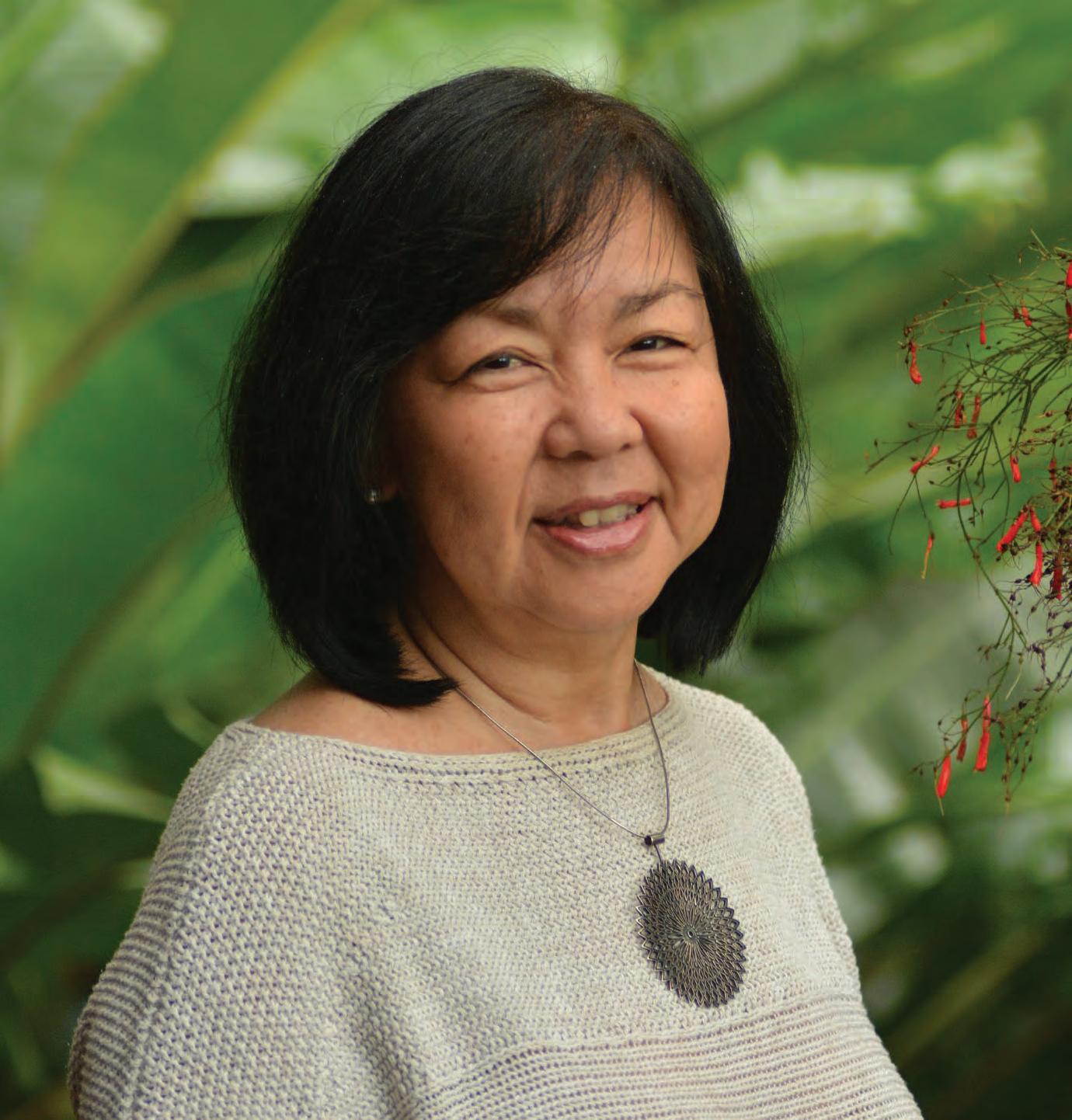
Kelly King is Vice President of Pacific Biodiesel Technologies, LLC, a renewable energy company. In Hawaii, Kelly served as an elected member of the Hawaii State Board of Education, representing Maui County from 1994-1998. She recently held the County Council seat for South Maui from 2016 -2023. Kelly has been active as a board member of many local, state, and national nonprofits, including:
• Maui Hui Malama Learning Center
• Hawaii Renewable Energy Alliance
• Hawaii Energy Policy Forum
• AKAKU Community Television Board of Directors
• UH Maui College Sustainable Sciences Management Advisory Council
• Maui Farmers Union Board of Directors
• Hawaii Technology Development Corporation
• Hawaii State Association of Counties, Executive Committee
• Maui Nui Food Alliance Steering Committee
• NACO Western Interstate Region Board Member
• ICLEI – Local Governments for Sustainability, USA Board of Directors
• Local Government Advisory Committee to the U.S. EPA
• Delegate to COP26 and COP27 (for climate change) and COP15 (for biodiversity).
Kelly, you have achieved so much in your life. Can you share what drives you?
My journey began in 1959 in Gardena, California. Our family of seven lived in a Japanese American community.
In 1970, at age 10, we moved from a family community where everybody knew each other to Santa Barbara, an affluent, mostly white city with few minorities - we were the only Asian family on the block. My sister and I were two of four Asian students in our elementary school. I was shy and reserved and felt ignored and intimidated by the environment where I was growing up.
The first time I heard the term “Jap” was my first experience with racism from a kid on the playground. The kid’s father was an ex-military guy who probably fought in World War II, and he passed his prejudice on to his son. That was my first big trauma - I remember telling my teacher she got upset, and the kid was suspended for a week. I went home and asked my mother about it, and that is when I learned about the Japanese internment camps my parents had been in. My mother went in at five, and my dad was nine. It was a learning and turning point for me as a child who was already intimidated by being a minority.
When I asked her why I was just now learning about it, she said, “When your father and I got married and started our family, we agreed that we weren’t going to tell you about it until you asked. This is a big life lesson because this didn’t happen to you. It happened to us. We don’t want you to carry anger about this and let it affect your life. You need to learn from our experience but live your life going forward.”
I think people have two reactions. People can jump right into that anger, hate, and be aggressive, or they can learn from it by taking a step back and deciding how to use this experience to help future generations to be more accepting.
My father greatly influenced me because he was all about tolerance, integrity, and recognizing injustice. And my mother was very quiet and reserved where even when she saw injustices, she didn’t jump out and scream and yell. Women of her generation tried to figure out how to fix things without being loud and aggressive. I noticed that everyone in her generation got married, had kids, and their husbands told them what to do and seemed to run the household. I remember fighting with her several times, calling her a doormat, and asking her why.

She got mad at me when I spoke to her like that. She said, “I am behind the scenes. You don’t know or understand how much I do control.” Fast forward – it’s the lesson I think about today. My past work on the Maui County Council was so much about knowing when to speak up, get aggressive, be silent, let people have their say, and then move forward with a new or modified message.
In high school, I was still pretty shy. But the thing that saved me was journalism class, becoming involved with the school newspaper, and becoming the feature page editor.

During high school, I had a column in a community newspaper, Goleta
Valley Today. Every Friday, I would submit a column about high school life and get paid $5. It was a way to have a voice.
When did you shift from being intimidated to stepping into your personal power?
In 1979, I moved to Maui and got a job at Skipper Printing company working in sales. I had previously worked in Santa Barbara at a printing company in the graphics department. Those days were pre-digital - we had computers for typing, but you had to physically create artwork. I would work all day drawing, designing layouts, and doing overlays by hand with an X-acto knife.
Eventually, I left the company and transitioned into the tourism industry. In 1980 I got an offer to start an activity center at Seaport Cruises. It was the first concept of booking tours and activities for visiting tourists. And I met the man I would marry one day, a mechanic on the boat our company used for whale watches.
Japan was also open to tourism then, and I was determined to visit the country where my family originated. The experience greatly impacted me. I connected with my roots and deeply appreciated the culture I had never seen before.
When I returned to Maui, something changed in me. I found that I had a deeper appreciation for all cultures. When listening to politicians talk about Hawaiian or local values, I understood that they’re not that different from any other place.
Every culture has values. Every good person values integrity and honesty. There are a lot of different cultures in Hawaii. It’s such a melting pot that everybody fits in. One of the reasons I came and stayed on Maui is because I felt so comfortable being in this community of different ethnic groups. I had come from a community where I felt ostracized and ignored to Maui, where I felt like everybody. I began to think more about generalities and prejudices against certain cultures and how we must help all people, not just one race.
In 1985 I got into community work when my daughter was one year old. In my town of Kihei, I found a community activity called Playgroup. This was part of a Maui county-sponsored activity in many of our island communities. Kids would come with parents and play together under the direction of a volunteer. I became a volunteer director.
That was my first community involvement where I was in charge. After that, I volunteered in Girl Scouts.
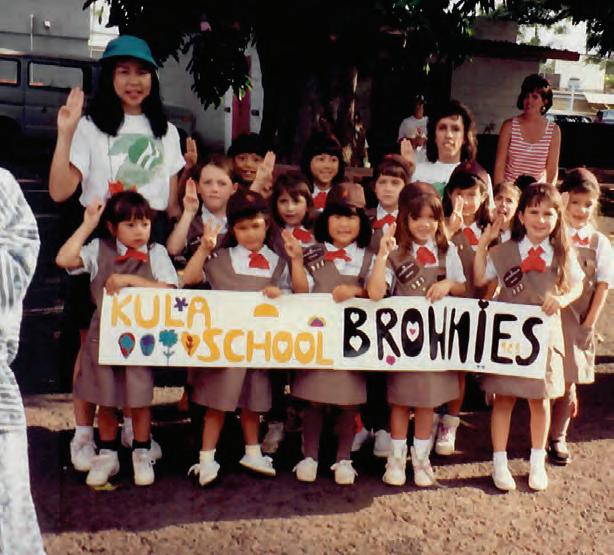
When my daughter began kindergarten, there were 2000 kids from K-6th grade in the elementary school. It was overcrowded! I got active in the PTA even before my daughter started school and created a Kindergarten party where the kids and parents could meet before the beginning of the school year.
Becoming involved in change was starting to be a pattern in my life.
In 1989, I saw a head-in-the-sand community that didn’t want to get involved because it would take too long to improve. So, I went the other way and just dove right in. This was my first introduction to asking for things from the community.
Joining the PTA was a pivotal point for me. When I saw great changes happening with community members coming together, it inspired me to go further. I initiated the first community park super-playground on Maui by heading up a group of volunteers. We designed the playground through community meetings, where I learned about outreach, bringing in stakeholders, listening to people, and working with volunteer labor. Volunteers felt proud to be a part of something for the community; this was the point and impact of the Why: Coming together and creating positive change for the community.
My involvement with the Maui County communities evolved into being elected to the Board of Education.
I was the most visible board of education member. I was the only one with my phone number in the phone book and always received calls. I talked to parents about issues, how to get things done, and the process. I learned how to talk to angry people. Nothing makes a parent angrier than thinking your kid has been wronged, and no one cares.
I accomplished my goals while on the Maui Council by creating experiences for our community to look at the big picture and helping people focus on real priorities.
I did my best to take emotion out of the equation in those discussions.
How have you grown in your political involvement?
Being there with people, hearing the people, and connecting with people built momentum.
I began to think creatively about improving the school infrastructure. This was when my husband and I first learned about renewable energy technology. We knew that once the schools were retrofitted to use these resources, the institution would save money on utilities. That money could be added to the educational system for improvements and upgrades.
Although I couldn’t convince the rest of the school board to move in that direction then, it was the start of something new in my personal life that I would create with my husband. We believed in our vision for sustainability and created Pacific Biodiesel, now the oldest biodiesel company in the United States.
When we began to take the conversation about renewable energy statewide, I watched people who were purely in it for the politics while I was in it to try to get something done.
I joined the board of the Hawaii Renewable Energy Alliance. And then, I was asked to be on the Hawaii Energy Policy Forum.
I started getting linked in at the state level with what was happening with renewable energy and did a lot of talks at the East-West Center and with a new group called WiRE (Women in Renewable Energy). A few women involved in government at the state and county levels started this group on Oahu.
Later I got together with Willie and Annie Nelson, Daryl Hannah, and Laura Harrelson and started the Sustainable Biodiesel Alliance.
I was always back and forth with the legislature on sustainability subjects. I gained experience working with politicians, developing relationships, and talking about things that mattered. So, when we started this nonprofit, we were getting more involved in the legislature and trying to get them to do the right thing.
At the Hawaii State Energy Conference in 2016, a community activist from Maui tasked me to run for office for South Maui. He got down on his knees
and begged me. I told him I wouldn’t know where to start, especially with only four months before the primary. I laughed and said, “Why would I ever want to do that?”
Two days later, he emailed me and said, “I found you a campaign manager, a treasurer, an event coordinator. Now, will you do it?”
There were already two people running against the incumbent, this was April, and the primary was in August. My activist friend said, “You’re the only one that could beat them, Kelly.”
I decided to give it a shot and ended up winning by a pretty good margin, and my new chapter in politics began. I was reelected twice, and our team was extremely productive.
In January 2020, I stepped down from Chair of the Council to create the Climate Action Resilience and Environment Committee, which I have chaired for the last three years. We achieved many major pieces of legislation.
Taking these positions is an act of community service and should not be for personal gain. We would all be healthier if our politicians looked at it that way. I cared about my community supporting my decisions because I wanted to represent them. It was not about being reelected
After three terms of Council service, I dove back into Pacific Biodiesel and am on the board and involved in the Kihei Community Association. On the global level, I serve on the board of ICLEI USA, part of a global organization that has 24 secretarial offices around the world, with headquarters in Germany. Our organization helps local governments worldwide develop environmental initiatives, climate action plans, baseline data, etc. ICLEI has been a major partner in global climate conferences.
It has been an incredible experience to see how much of Maui’s message resonates with people worldwide.

The words from the song “Imagine” by John Lennon and the vision for the next chapter of my life in 2023.
Though, the community and all the continuing support and appreciation keep me going. Hearing from others that I have inspired is a true gift and the best reason to continue focusing on the future. I have two beautiful children and two beautiful grandchildren, and while they are the personification of the future, the world has become a very small place in which we need to start realizing we are all family. u
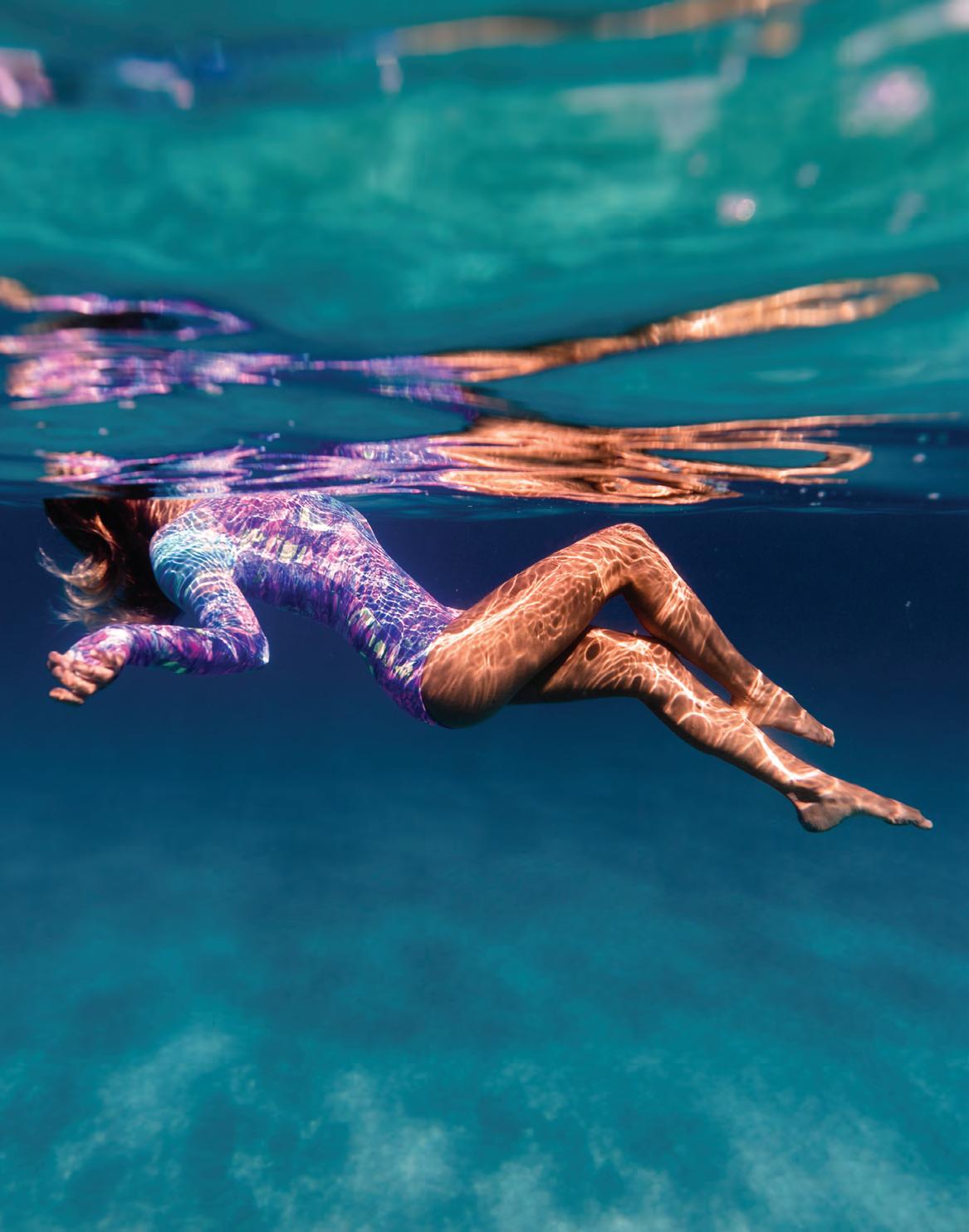
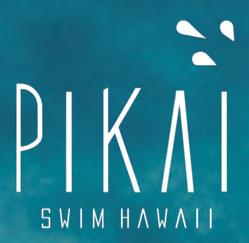
Sunny Savage is a wild food forager, whose life is dedicated to helping the world identify, harvest, and prepare wild plants. She is a sought-after educator and has taught thousands of people about wild foods. I had a very unconventional upbringing, that afforded me a life outlook and set of experiences that were unique and nature orientated. I was exposed to cities, travel, and the wider world. I feel very blessed. Certainly, every life is full of challenges, and I had my challenges as well, but it’s really beautiful to reflect later on and feel gratitude for the effort my parents put in to create a different experience.
Well, I think that most people assume someone like me is anti-technology and is off eating wild foods daily. I like to let go of that restrictive approach. My motto has become one wild food every day. It’s not realistic that we will be out there foraging food for hours every day. But, by including small amounts of wild foods to keep the connection alive, to keep the genetic transfer of information, adaptability, the thriving and nutritional quality of these wild foods to become an embodiment of us. That’s my approach as to what I feel to be realistic about our relationship with wild plants. I was an early adopter of technology. My father was a calculus and physics teacher who was interested in technology, and I remember the very first Yahoo Chat group called, Forage Ahead, being in an online community of forgers from around the world. I felt I was the oddball - the out person who’s off harvesting these wild things. And these people encouraged finding a community and a group of people with which to resonate.
So that was kind of the early days. And then now, of course, I have used technology to facilitate more people participating and engaging with the land by building a mobile app, called Savage Kitchen, which has now been downloaded in 64 countries and over 10,000 users, achieved through organic growth without any advertising. People who have a deep connection with the earth, should be in control of technology.
It is a tool that enables people to find wild foods, educate themselves on the identification of look-alike plants, quiz themselves, and watch video tutorials along with hundreds of recipes. It also encourages you to set the phone down and listen, smell, see, taste, and feel, using all your senses to have that moment of disconnecting from other things going on in your head.
The app helps you get there, and it also helps on the other end when you need that little spark of inspiration in the kitchen. I am a lover of technology, but I feel like we have moved to the next level of requirements around self-control. It is our responsibility to monitor self-control and monitor our use and decide what it is we are feeding online.
Have you determined how far back your lineage with foraging goes?
I think that ultimately, we all descend from foragers. Every one of our ancestors were foragers, and 99% of our human experience thus far has involved foraging. This disconnection from the land and plant identification and being able to feed ourselves is a modern-day disconnection. Of course, I felt a lot of curiosity about my ancestor, Thomas Savage, who was on the second boat into Jamestown in 1607.


He was 13 when he arrived, and less than a month later, he was involved in a political exchange with Chief Powhatan. Thomas Savage, lived in the home of the Indian Chief Powhatan, along with his famous daughter, Pocahontas. He grew up as adopted kin. The historical records show that he and Pocahontas had a great relationship. He was kind of one of the only speakers of the Powhatan language and became a translator and negotiator in that area.
Who was the spokesperson for the political trade?
Captain John SmithSo, he became a speaker, translator, and representative from that cultural perspective to convey that into the society he was currently in?
Yes, he was the chief negotiator and translator as Jamestown grew and the two cultures intermingled.
Please share with us a recap of your 20s and 30s and how those years helped you create the services that you offer now.
After I graduated from high school, I moved to Antarctica for a year. I went through the experience of eating canned and frozen food, and I realized how important food was to me. When I returned home from my journey, my mom was getting into herbal medicine. I dove in with gusto and learned from books about edible and medicinal plants. It was my moment! At 19, I found my purpose; to be inspired by sharing with others this joy, and the spark of inspiration from the foods that are growing all around us! That led me to get a Bachelor of Science degree in dietetics, followed by a master’s degree in nutrition education where I focused on the antioxidants of wild greens. I taught at a tribal college for a few years and then hosted the Hot on the Trail with Sunny Savage on television in the United States and three other continents.
I wrote a book, Wild Food Plants of Hawaii, did a TEDxMaui talk, and offered lots of workshops, wild food hikes, and community engagement educating people about wild foods. I also had a successful Kickstarter campaign that funded a food truck where I served invasive species that were forged on the island. Where and when
I arrived in Hawaii in 2008 while hosting my television show, Hot on the Trail with Sunny Savage, and met a guy. We lived on a sailboat for three and a half years filming a documentary. I was teaching plant classes, some English classes, and whatnot - little side jobs along the way. Upon returning to Hawaii, I dove into writing my book. Through a Kickstarter campaign, I funded a wild food truck called Savage Kitchen and focused on invasive species. I teach about all kinds of wild foods, but my focus is on eating invasives and shifting the narrative instead of just, oh, kill, kill, kill, these are horrible.
I understand from a conservationist perspective that everybody wants to return to all these incredible native and endemic species. Still, to do so, we must deal with the invasives here. And while we’re dealing with those, and understanding that they are sacred plants, understanding their history and being brought into awareness of the profound medicinal and edible qualities they have. On the food hikes, I take people out to the locations of their choice, in small groups to identify plants. I also offer workshops that involve cooking, and I work with a lot of school groups. How much strength and personal success did you gain on this path foraging into awareness?
I realized early on that I had a unique offering to share with people. Being a woman who owned a small business, forced a lot of lessons, but doing something very outside the box also posed challenges. Even though a lot of groups in Hawaii have employees who follow my work, from an organizational standpoint there typically is not a lot of support if I’m trying to apply for grants. Usually, those organizations are tied in with chemical industries and policies that are moving in a different direction. When I had my food truck, I also was reported to the health department for serving invasive species and had to pay the state to harvest invasive species. People are really interested and curious, and that’s my motivation to keep going. I believe there is a deep gratitude to all the people that have come before me and kept the knowledge alive. When I was growing up in Northern Minnesota, people on the reservations nearby were still being arrested for fishing rights and harvesting wild rice. All of the people who have kept the knowledge alive have put themselves at risk to do so. There is that deep, profound sense, mostly for indigenous people who have done this at their own risk and risk to their families. It’s an ancient practice, and we would not be here as a human species if we didn’t know how to forage. It’s just so old, it’s new again.
I am noticing that more people are researching Hawaii before they visit – have you ventured into tourism market?
No, I haven’t because 98% of my clientele are residents. My services and knowledge have spread word-of-mouth. I’ve reached a point now where I want to start doing more bookings and am going to move in that direction.
What guidance would you offer to others regarding expanding their education around foraging?
If someone is interested in foraging and is new to it, I think finding a person you can learn from, to go out into nature, and make those connections. It’s so powerful. I encourage finding someone that offers wild food hikes, finding plant people at nurseries, or locating mushroom groups and clubs. Pono is the word that we use here in Hawaii meaning, ‘do the right thing.’ Your words and your actions should be correct, and to educate others on what you know, have
experienced, and what’s true. And then you can’t go wrong.
What is the next adventure you have set up for yourself this year?
I feel like I have a new chapter of life emerging. For the last five years, I’ve had a major health challenge that I was dealing with, and I purchased a house that I thought was turnkey. After a few surgeries, I have a clean bill of health, and my home is almost complete after some major renovations. I’m looking forward to not being in search of seeking, and wanting to just go with energy, but rather by cultivating that skill of calling things towards me. I’ve reached a point in my professional career where I have a lot of knowledge and a lot to offer. I am looking forward to a more grounded sense of stable awareness and moving in the world with that.
I am very open. I have no idea what the future holds other than to continue my path of providing high-quality information about wild foods for people. Let me cater to the people interested in this and take that to the next level. I’m open, I’m curious, and I’m excited. I feel good on multiple levels, so I’m really happy with where I’m at.
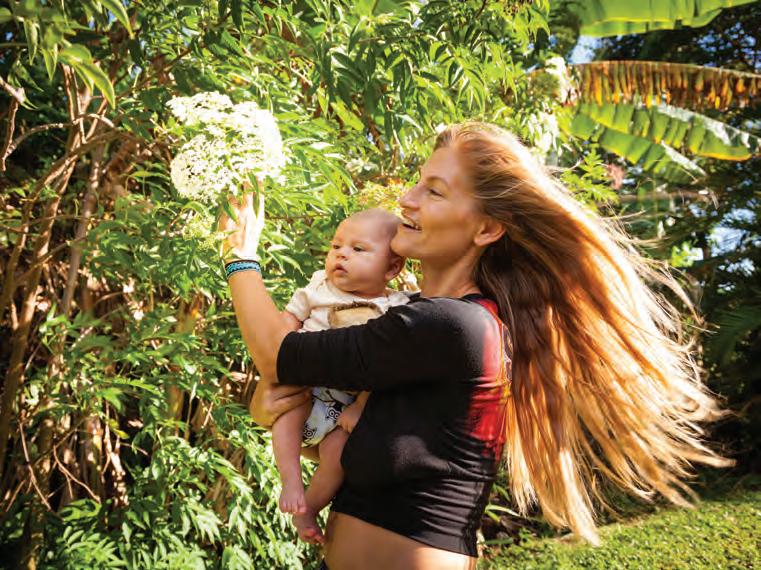
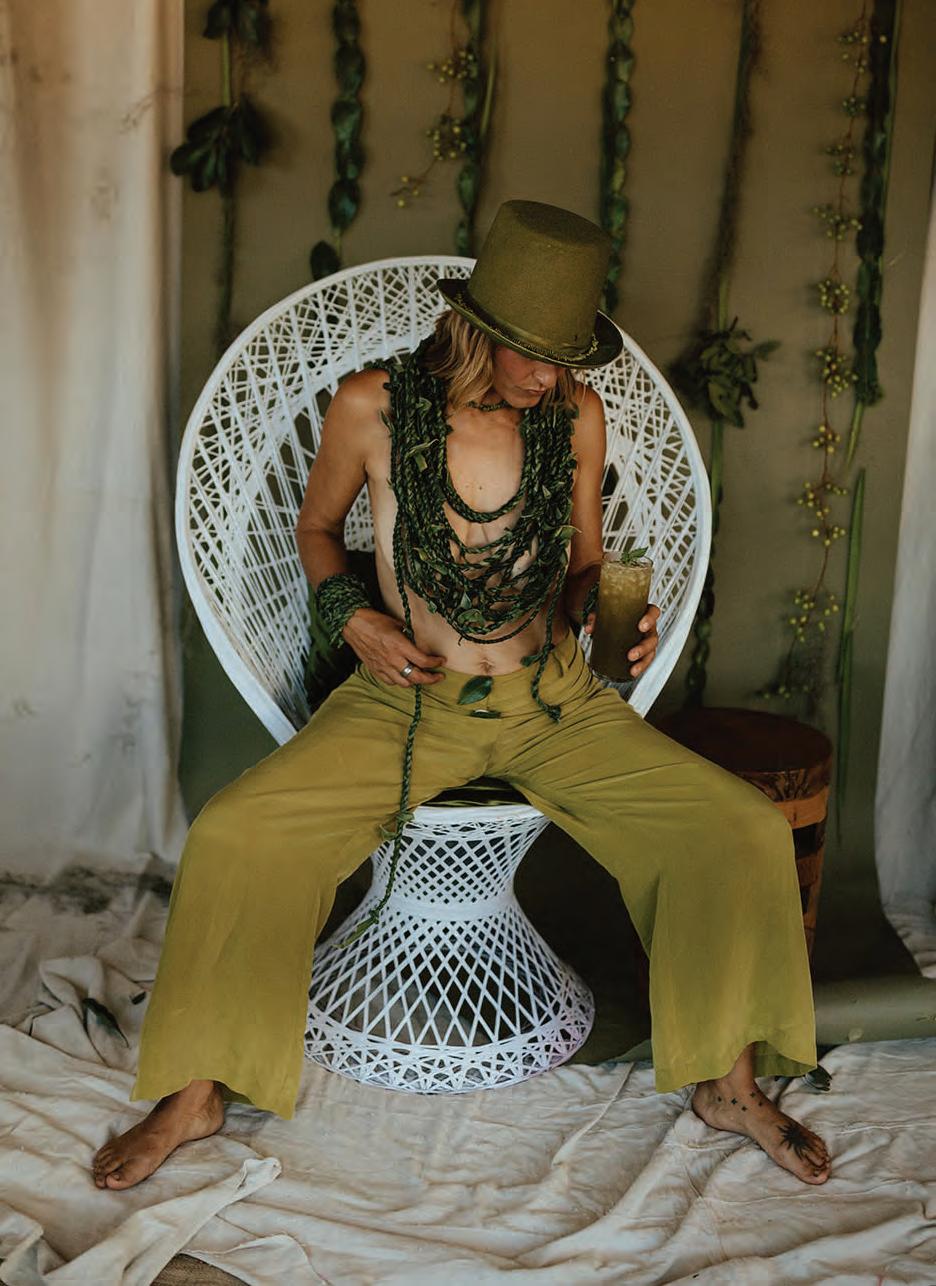
Where do you dig deep for your inspiration?
I’ve had many, and I would say from a foraging perspective, Sam Thayer, whom I’m blessed to call my friend, has been such an inspiration for me. He is a self-taught forager who has published several books in the foraging community, that are considered the best of the best, and he has a dedication to excellence in the information he puts out there. I would encourage you to look up his information. In addition to being a published author, he provides wild food products. He is one of the few people from which you can get wild food products that are unique.
Where can we locate your current updates?
sunnysavage.com | Instagram and Facebook
I also offer digital downloads with wild food materials, and people can book Wild Food Tours with me on my website. u
Photo by Sue Hudelson Photo by Cadence Freely









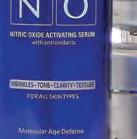






























































Schiammarelly Pinckert is a 27-year-old Bolivian doctor, yoga teacher, and health coach. Living in Bolivia, enduring an intense government crisis, Schiammarelly is a part of the fight for democracy. She lives a life devoted to helping her community, and her happiness is in the moments when she can help save lives. She traveled to many different countries while growing up, allowing her to observe different cultures and beliefs. These experiences helped her develop a natural ability to be open to listening to all views, medically and politically.
At seven years old, I went to America to stay with family members until I was sixteen. I loved America and adapted very quickly, learning to speak and communicate in English fluently within six months.
How did you learn to teach yourself English?
My family was insistent that I did everything in English. They told me to ask questions and use my imagination to learn to communicate in the new language. They would put me in places where I had to learn – like daycare. I would come home with new words every day. My translation was terrible, and everybody laughed at me, but they explained why they were laughing, and I laughed with them. “You can’t go forward being sad about the mistakes you make,” they would say.
Years later when I returned to Bolivia, I couldn’t adapt. The culture shock was big noticing how Bolivian children act a different way. Teens and young adults wouldn’t work, and were not allowed to be independent, or couldn’t go out to do their own thing. I was used to the culture of the United States, so after ten months, I went back to America to graduate high school.
After high school graduation, I began waiting tables. After work, one day, while watching the television show, Grey’s Anatomy, I told myself I wanted to learn to be a doctor because I love caring for people. Studying medicine was initially a superficial interest - until my grandpa got sick and needed my help.
I knew medicine was what I needed to do. However, studying medicine in America is much more expensive than in Bolivia. So, I returned to Bolivia to go to medical school and be with my family.
What field of medicine are you currently studying?
Obstetrics and gynecology are my areas of study. I thought choosing this line of health care would put me in a position with beautiful, perfect babies everywhere–it’s not like that at all. People have loss and sadness everywhere in medicine.
Can you describe a normal day in your work week?
Keeping up with my family, friends, and myself is hard. I do 36-hour shifts every three days with only one day of rest in between. I just want to come home, take a shower, and sleep.
How many births do you assist daily?
In the morning, we typically do three to six birthing procedures. We do rotations inside the hospital, so I work in all aspects: consults, surgery, and OR assistance. In the afternoon, I do ultrasounds and coordinate labs, doctors, and all materials to ensure the next successful procedure.


Tell me about the social unrest in your country and some of the scenarios you’ve witnessed.
We’re supposed to be a Democratic country, but in recent years we’ve had a different type of party come in. This party advocates socialism, creating many issues.
So, if it’s still democratic, who’s imposing the socialist policies on everyone?
In 2019 we had a president from a pro-socialist party who was known for notorious election fraud.
It was right before the pandemic. The country went crazy with a civil movement - and the Bolivian citizens stopped the country for 21 days.
Everybody stayed home and blocked the streets with their cars. You couldn’t go anywhere. No travel, trips to the supermarket, shopping, or going to the hospital. The economy stopped. And anyone who went against what our government said or believed in went to jail.
Civil movements are everywhere in my country. In America, you have
states in my country we have departments. Each department has its own civil movement happening.
Were these protests the strongest where you are located?
Yes. Our movement was very strong. Right after Christmas, the person leading us was Fernando Camacho. He was the leader of the civil committee. This position represents the voice of the community. He was a normal, friendly man who cared about the people. The police, who are supposed to care for the community, shot at his SUV and kidnapped him without a legal arrest order.
He was lost for three hours, and during the time he was lost, the entire country went crazy because he was the person leading us to finally break away from the government fraud that was stealing our voice of democracy. We threatened to stop the country again but enacted a peaceful protest this time. But the police went after the community and started gassing us.
Describe the horror that your community was subjected to.
Many women and children with white flags filled the streets and went to the police command center, asking for peace. And when we got there, they started firing pepper spray at us.
Did the protest switch from peaceful to not peaceful?
The protests turned violent, and the police burned cars and threw cans of pepper spray causing eye loss, brain trauma, and death. The police did not care – they went after everybody.
Because the movement had different opinions and wanted a different voice?
As a country, we are in so much pain, separated because of money and power.
Our beautiful country has many resources that could be exported with a better government and organization. I see how badly it affects us here in the medical field.
We do have free healthcare, but there are many problems. When we run out of something, the patient has to buy that item themself to get their procedure. We don’t have enough beds because the census only counts half of the people in the area.
We have had people from Chile and Spain visit and reach out to different organizations to do something to help. There were so many irregularities – it scared them.
When they began to voice their opinions within 24 hours, they were asked to leave and never return to our country.

How are the women of your country contributing to a positive future in Bolivia?
Women here are close to each other. We don’t recognize race or age. Young women and grandmothers are crying and saying together to those who will listen, “This is my country; you work for us. Why are you attacking us?”
Witnessing all the women unified in the same prayers and voices for peace in our country is very powerful.
Whenever there is a conflict, you think the man is the strongest to help. The man might be strong physically, but the women behind them give them the strength to fight. At one protest, the men would retreat after being gassed, unable to see or breathe. The women had backpacks filled with milk (the only antidote available to remove the burning from the chemicals) to treat the men’s eyes and skin before they went back in again. My husband was fighting in this protest, and I would take turns running out to the fight to treat him and the others. The police came down
hard on us with smoke bombs. The police shot at us with bazookas, and this went on for many hours.
We began to run with the smoke hitting our eyes. There were moments I felt blind. Men and women were running to survive the gas and smoke. It was terrible and sad.
We were exhausted, but knowing what we were standing for kept us going.
How did these encounters give you strength for the future? They validated my determination for fighting for liberty, democracy, my future children, and my voice to be heard.
Where are your ambitions leading you personally and professionally for the remainder of 2023?
I will be finishing my residency in Germany. I want to go to another place, observe positive solutions to situations, and bring that influence back to Bolivia. If the opportunity arises in Bolivia to help as a medical professional, I will come back and join a foundation. I will go anywhere to be a part of a positive solution. And I thank God I have a husband who supports my decisions.
What do you wake up to each day that keeps you motivated?
I wake up wanting to make my dreams come true. I want to deliver on my dream of living a happy life. And my happy life is helping people, which I’m meant to do.
What encourages your inspiration in life?
My mother. She is a strong woman who taught me to be firm in my decisions, that women only need themselves to succeed, and that we can move and do everything with our own two hands. She taught me to keep my mind and willpower strong to make anything positive happen. u
I wake up wanting to make my dreams come true. I want to deliver on my dream of living a happy life. And my happy life is helping people, which I’m meant to do.

An Interview with Kat Mische
ElleDawn Cook is a bestselling author, a professional pilot, a successful course creator and the CEO of a unique life-coaching practice, The Aviatrix Mindset. Dawn is also motivational speaker and cofounder of the world’s largest social network/non-profit for female pilots known as FAST (Female Aviators Sticking Together), which proudly supports over 13,000 female pilots worldwide. One of her many goals is to be an example of what is possible, not only to her two young daughters, but to all women. A native of northern Virginia, she has remained on the east coast for most of her career.
Dawn, tell us what makes you, YOU, and the inspiration that brought you there.
I am a mother, a wife, and I’m a professional pilot and entrepreneur. But all that being said, the hats I wear all came about because of another incredible woman, my mom. I love how people say, “Behind every great man, there’s an incredible woman.” But there is usually another incredible woman behind every driven, determined woman!
“What’s caught is taught.” That came from my mother. She was a flight attendant for U.S. Air during my high school years, and I would go to work with her in the summers. This was way before 9/11, and you could bring your children to work. We would come up to the crew van and walk on the airplane.
My mom was based in Northern Virginia, the National Washington, DC airport. Her route in the summer times was the D.C. shuttle. So that was D.C. to New York, DC to Boston, and back and forth all day. So that’s what I would do. I would wake up at five o’clock in the morning and fly with her and have breakfast in New York. Then I would return to D.C., fly up, and have lunch in Boston. Then I would come back to D.C.

My journey started when I told my mom, “I want to be a flight attendant.” That was the only thing I knew about, how to travel, get paid, and see the world. My mom said, “No.” I thought, “Well, how else will I do this?” My mother told me that she had seen a female pilot. She said, “If there’s one, there’s another. And if there’s only one, why not you?”
This is the mantra I took on. And my mother’s belief in me.
My mother raised four children on her own for a very long time. She had this belief of “And.” She believed she could be a great mother AND leave and travel. She could see the world, AND she could raise four incredible children.
Being raised not knowing “You can’t” and believing in the power of ‘And,’ were game changers for my belief system and were the start of so much for what was ahead of me. In the world, when you’re a minority, and if you’re a woman, if you’re a double minority, you are presented with some invisible work rules that you need to learn to follow. I knew that I had to work twice as hard to seem half as good in the eyes of my peers. Developing that drive and determination, it’s almost like it was the platform for every decision I made.
Some situations came to a point where I had to make hard decisions to get where I needed to be, but I held myself with respect the entire time because anything less was not an option. It was non-negotiable.
I got my private pilot license, which was required then, and my commercial license. But it wasn’t until I was a flight instructor, when I graduated the year of 9/11, that my flight school went under, and when the world was scared to fly. But I was determined. I said to myself, “I will be a pilot. I will figure it out.” I thought, “I didn’t work this hard and come this far to quit now. Something’s got to give.”
I applied to 55 flight schools on the east coast, where I knew I could stay with a family member or friend until I could build up enough clients, students, and finances. I know it was 55 schools because I only had 55 pieces of paper left on the tablet. I had to go to FedEx and print them out because this was before people had iPads and personal computers, and printers at their houses, and I didn’t have that kind of money.
I was hired at a school in the Atlanta, Georgia, area. That position led to an incredible cargo position, which led me to a regional flight job, opening my current airline job. I will be one of the most senior people to retire at this company because I was hired so young. I believe this happened because I refused to give up.
What is your personal checklist that you use to see how strong your self-respect is ranking?
Daily, people are conditioned to go, go, go all the time. We are not taught to check in with ourselves. We, especially as women, are conditioned to check in on everyone else first, kids, spouse, and work. It’s easy to put ourselves at the bottom of that to-do list.
The first thing I do in the morning is check in with myself and ask, “How are you doing? How are you feeling?” And if I notice any overwhelm, I remind myself, “If you want to speed up, you have to slow down.” And this is coming from the Queen of 500 miles per hour all the time! We have got to slow down. I do take that very seriously. Just slow down, especially with different gut decisions. It’s almost as if two different sides are happening within me. The younger Dawn who wants to go, go, go, and the more experienced, not even enlightened, but living with a better perspective Dawn who tells herself, “Let’s just see.”
Have your experiences given you a broader sense of awareness?
Yes. And when I tap into that and let that voice be louder, it helps me make decisions more clearly. That clarity gives way to the confirmation of, ‘this is going to work.’ It feels good. This sits well with me. Instead of being in that version of an old mindset of, “This is what everybody else is doing… go here, go there, this is bright and shiny, I must follow along.” I now walk a path of, “How does this feel?” type of centeredness. When making
decisions, my check-ins are, “Is this heavy? Is this light? Does it feel okay? How does my gut feel? Is there a little frustration with it?” I refer to those answers versus what everyone else is doing. I stopped following the crowd or what seems easy, popular, or even practical sometimes. If it doesn’t sit well with me, I won’t do it.
What was the most impactful experience during your climb to your next career level or personal success? Tell me about creating F.A.S.T. From the cargo flying, I went to regional jets. From the regional jets, I was hired at a major airline. After I took my position at my new airline, I was assigned to mentor new hires coming in. This was unique because the new hires didn’t have a lot of guidance when I began my career. I stepped up and wanted to help with all the questions I wished I could have asked when I started. This was a very different situation because there was a large number of women that we were hiring. I loved seeing this! But now, these women are also starting families. There was no protocol to inform these women about situations for having a baby. I took a few under my wing and became a mentor. Other female pilots and I began discussing some ideas and decided to start a group for the other women at this airline. A group for topics such as when they are starting families and going through all of the things that you don’t want to talk about in the open groups because you don’t want any red flags put on you for having questions. It was to be a platform for the female pilots to communicate their inquiries and curiosities safely.
We started a Facebook community for the women at our airline. And it was fabulous. It was a wonderful success. It contained information in an almost step-by-step to-do list of “Welcome to the airline. If you’re having a baby, here’s what you must do. Here’s how you leave. Here’s how you come back to work. Where to find maternity uniforms (which are hard to find), and so on.”
We were inspired to create resources and a support group for being a professional and a mother in an aviation career.
My inspiration came from being raised to view life with ‘And,’ not ‘Or.’ This was important for me to develop because the message was, ‘Or.’ You could be the pilot, but you couldn’t be the mom. ‘Or’ you could be the mom, but you had to quit being the pilot. I knew a woman didn’t have to do that and make that kind of choice.
After I started this group, women from other airlines found out and wanted to join. We knew our contract and work rules but didn’t know theirs. So we created a non-profit for female pilots named it F.A.S.T. – Female Aviators Sticking Together. A collective of five female pilots started this organization; we immediately grew to two hundred women, then to over a thousand within a couple of months, and over three thousand in one year.
We now have over 13,000 women worldwide who connect on everything for support in their careers as female pilots. From beyond being a new mother to retiring from your career to your health, your wealth, your mindset, imposter syndrome, living in the power of ‘And,’ and even sometimes, simply sharing, “I just need help.”
We have over a thousand posts a day on Facebook. We are now building out, and we’re expanding. Having that instant support and knowing ‘I’m not alone’ is the most important aspect. That is the biggest theme that we
have found in being a female pilot in the airline industry. The female pilots members can be from anywhere. If you feel so alone because you’re the first in your family to fly, the first one of your friends, or the only female at the flight school and you are some anxiety around it, I get it. For someone to have your back when you are constantly being questioned and nitpicked is important. It’s where other powerful, amazing women remind you that you are good enough! It’s very powerful.

Where does the gratitude for your inspired life begin?
I don’t even think my mom knows how she inspired me. She’s always unapologetically been herself. Being able to witness her having that kind of mindset was everything. Other people who inspire me are the women who say, “Yes, I can.” Whether it’s Sonia Sotomayor or Rosa Parks, it’s “Yes, I can! Yes, I can do that!”
What can we expect from you and F.A.S.T. for the rest of this year?
I will be a pilot. I will figure it out. I didn’t work this hard and come this far to quit now. Something’s got to give.
We are creating a program to help encourage all little girls who dream of being a pilot. Our goal is to sponsor and support 20,000 discovery flights for young girls.
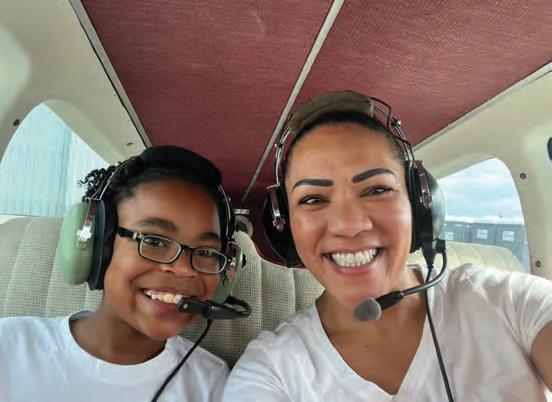
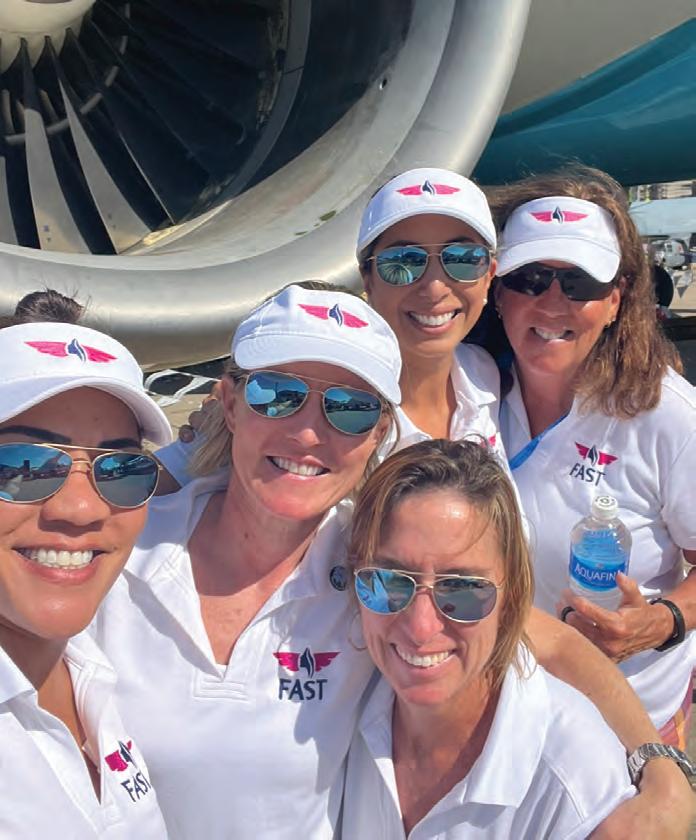
A discovery flight is when someone without experience goes on a flight with an instructor. They take off, fly around, and land, all with the guidance of a flight instructor. I don’t want to create just 20,000 new female pilots. What we will create at the end of this is that we will have inspired 20,000 young girls who now have that seed of confidence, perseverance, and perspective that no one can take away from them. That is a game-changer for someone’s life! Someone doesn’t need to become a pilot, but you must know it’s possible. Knowing it’s possible that you can live that dream, you will be able to create many others.
How can we find out more about F.A.S.T?
F.A.S.T. (Female Aviators Sticking Together) can be found at: fastpilots.org
My personal website is: DawnDebbieCook.com u

Terri Levine is one of the world’s foremost experts on how to market a coaching business. She has built and sold several multi-million dollar companies. She is a best-selling author of over 40 books, and a highly requested keynote speaker at events and conventions throughout the world.
Terri, when did you begin to notice the differences in status?
I grew up in Yonkers, New York in an apartment; we were very poor. I thought everybody lived the way we did. In fourth grade, we moved to Westfield, New Jersey - an upper-class town. I was uncomfortable and felt like I didn’t fit in. I had never seen a house or green areas, I wore hand-me-down clothes and had a New York accent that people made fun of. The other families where I lived had maids, butlers, drivers, and horses. But despite our improved circumstances, my parents didn’t change our way of living. I will always remember my mother telling me when I was eleven, “It doesn’t matter where we live or how much money we have, it is all about being kind and friendly to people that you meet.”
How did you find your place in this new and different environment?
As I started my teen years, I didn’t fit into the cliques at school, so I started to find some things to do in the community. I found a new circle of friends, and joined several associations, and organizations. I found my tribepeople with my vibe from all incomes, who were dedicated to giving to the community. I learned that you must seek out the people in the circle you want to form. And once I did that everything changed. My grades, my desire to go to school, my self-confidence, and my self-worth. I felt spectacular. The lesson for me was to not try to fit in, just be me, and surround myself with like-minded people.
With that mindset, what was it like going forward?
Here’s a little backstory. When I was growing up, I kept saying to my mother, “I’m not going to change my name. I am Terri Levine. I will always be Terri Levine.” When I was 16, I was invited to a snowball fight. A car full of guys I hadn’t met yet showed up. I got out of the car, and the driver of the next car got out. She said, “Terri Levine, meet Mark Levine.” I walked up to this poor guy and said, “I’m going to have to marry you because I’m not changing my name.” He backed up like a hundred feet! When I was 17, I started dating Mark Levine - we’ve now been married for almost 43 years.
After Mark and I got married, we moved to a very small town in Indiana. We worked while I went to school, and eventually graduated college with a master’s degree in speech-language pathology.
I formed my speech clinic knowing nothing about business sales or marketing, it was persistence that helped me get referrals. I sat in a doctor’s office one day for six hours until the doctor asked, “Young lady, what do you want?”
“I want to work with some of your patients. I want to help them.” He referred three patients to me, and then I could go to every doctor in town and say, “Dr. Elghammer is now referring, why don’t you?”
I grew a tremendous business in speech pathology. Then I started an art business with my husband and a
rehabilitation company. I realized I had a formula for starting a business. And then, I made a really big mistake, I took a job as CEO of a national healthcare company. The company loved me. But, I was miserable.
When did you start to see your strength and momentum building?
When I was CEO of this company in 1996, my mother, my best friend on the planet, was dying of emphysema. I was at her side for weeks around the clock. At the same time, my girlfriend, Marni, was dying at the age of 40 from breast cancer. I couldn’t see her in hospice because I was with my mom. I had a conversation with Marni a few days before she died, and what she said has always stayed with me. “Terri, don’t make your life about work. Don’t make your life about to-dos. Make your life important.”
Marni and my mom died within days of each other. In the aftermath of this loss, I knew there was something more for me to do. I realized I wasn’t happy at work; I wanted to quit my job and hired a life coach and decided I no longer wanted the CEO position. I wrote a resignation letter and carried it around for weeks until one day my coach said, “I know someone made a painting of your Mom. Are you in your office where you can see it?” I said “Yes.”
My coach then said, “Please turn and face it.” So I did. “Ask your Mom this question, Mom, do you want me to be happy or do you want me to be miserable?”
That was the day I found the strength to quit my job and said I would spend the rest of my life paying it forward; the business world had been so good to me. I then started my coaching business successfully, and happily.
My coaching and consulting business was originally called Comprehensive Coaching.


At the age of 47 everything was great until the day I was working out with my trainer, and I tore my Achilles tendon and contracted a neurological disease called Reflex Sympathetic Dystrophy (RSD). On the McGill Pain
Scale it is the highest, most painful disease, called the disease of fire burning or hell. I couldn’t wear clothes or lay in bed. It was constant round-the-clock screaming. I was on 29 medications, morphine pumps, ketamine infusions, an elephant tranquilizer.
What causes RSD?
It comes from any orthopedic injury. No one knows why, it’s an orphan disease and isn’t studied, and there is no cure. For 18 months I was in a wheelchair, wanting to die every day.
One day, I sent my husband out with some friends, had someone take my dad to dinner, and asked my day nurse to leave my medications on my night table so I could reach them. I planned to commit suicide. Before taking the medication, I wrote my husband a note. I knew he would understand. And then, a couple of weird things happened. First, my dog, who never came up on the bed, hopped up on to it with me and laid her head on my heart and was staring into my eyes. I remember thinking, she knows what’s going on. I also remember typing what I thought was a suicide note and when I read it - I had written a book about magnetizing. At this moment, I thought, “Why am I not magnetizing what I want? I studied this disease, and I found that there were millions of children affected by it, and I am a pretty strong person mentally, physically, emotionally and this disease is breaking me down. I have this disease because it’s a gift to me. I can be a spokesperson for it.”
When my husband came home, I said, “I need to get well so we can start a foundation for kids with RSD. They need treatment, help, and moral support.” I became determined to work with my personal trainer to get me on my feet, the pity party stopped. The pain didn’t, I’m in pain all the time. I deal with it mentally and I don’t focus on it.
We started the Terri Levine Foundation for Children with RSD. For the last 17 years, my husband and I have given 90% of our income to the foundation. We also do reverse tithing. We live off of the remaining 10%.
About 12 years ago, I was writing a book for my publisher to support my business. He threw the manuscript on the floor and said, “I don’t want this book…Terri, for 11 years I’ve watched you do business, heart-to-heart. No one does it with more integrity, transparency, and authenticity. I want that book.” I went back to Pennsylvania and had one of those moments where everything became very clear in my life.
I wrote the book about turbocharging your business as a Heart Entrepreneur, called Heart-repreneur® then changed the name of my company. And pretty quickly, 8,000 people joined the Heart-repreneur® movement. I have worked with over 6,000 clients in 19 countries over the past 34 years. I am doing what I love and love and what I do.


Let me know what your approach is for business with this inspired creation.
I teach businesses to do business by creating heart-to-heart connections. It’s not doing ads, funnels, or DMing people. We provided content, value, and education. I wear this little bracelet that says Serve and Create. Every day, I wake up and ask, what can I do today to serve and create? When I feel that I’ve done that, I know I’m done for the day. I teach my clients to help people, teach them, train them, advise them, consult with them, and give them everything they have. And then they extend their hand and say, “Would you like some additional help? If you’re interested, I’d be happy to tell you how that works.” It’s that simple.
In 2023, what are your next inspired ambitions?
I’m on a mission this year to impact a thousand people and ensure each of those people is committed to impacting a thousand people, so we can change the world.
I’m looking for a thousand like-minded people who want to share the Heart-repreneur message. We’ve begun that journey in our Facebook group already.
Who are the people that have provided a major inspirational influence in your life?
Eileen Seed inspired me the most when I started my art business, and she became my mentor. She would spend hours with me on phone calls. She gave me everything; her time, shared her life experiences, invited me into her home and took me on trips. She showed me how someone who was way wealthier than I was could live life as a simple person, and be gentle, and generous.
My very first mentor was Zig Ziglar. I took out a small business loan to hire him. He not only changed my life; he was my first exposure to coaching. I became a Born-to-Win trainer for him. I still go back to the stories, lessons, and philosophy that I learned from Zig.
Another inspirational mentor was Joe Vitale. Joe has been a wonderful force in my life in terms of spirituality and beliefs and of doing good and serving the world.
And then Jack Canfield, the author of Chicken Soup for the Soul, did a foreward for one of my books. I have never found anyone with more integrity. Those four mentors have been huge in my life, and I’m very, very grateful to all of them.
Do you have a favorite quote for motivation?
One thing I defer to repeatedly is, “What is working?”
Nothing else really matters if you go through life focused on what is working. When I first had RSD, all I focused on was, “Why me?” Once I started asking, “What is working?” Everything changed. The only thing you need to remember is, if you keep focusing on what is working, you’ll always feel happy. That changed my life.
And what is the best way for people to find and follow you?
My website: Heartrepreneur.com. There are plenty of free resources there, and tons of freebies. u
Kimber Leigh is an award-winning producer, actress, and journalist. She has produced more than 10 short films and has acted in more than 40 movies. She has also garnered a Telly award for excellence in journalism. She is best known for her work in which she produced and directed Imoceanation, Hawaiian Housewives are Da Bomb, and a comedy Sand in the Crack. She has starred in the feature films, Love a la Carte and Blocked.
What incident do you remember most from your childhood?
I adored my grandfather, who loved Greta Garbo the first silent screen actress. He would take me to his home and show me images of her. My grandfather would say, “Sweetheart, you’re going to be just like her when you grow up. You’re going to be talented and beautiful, you’re going to be an actress, and you’re going to be so successful.”
He built me up on a pedestal where I felt infallible. When I went home to share this news with my mother, I ran up to her and said, “Grandpa, says I’m going to be as famous as Greta Garbo!” She replied, “Sweetheart, you will never be anything but a bitch, a Greta Garitch.”
That’s the nickname she called me. Halfway through writing my book, this nickname came back to me. If my mother ever gave me a gift, her horrific name for me would be it; it became the title. When did you realize this wasn’t a normal way to live?
My mother hid alcohol everywhere throughout the house because, believe it or not, my father did not know what was going on. He didn’t know she was drinking, using drugs, and sleeping with men in the neighborhood. She periodically would come into my bedroom looking for her bottle of vodka that she had hidden under my mattress. My siblings and I didn’t tell anyone, because my brothers and I were told that if we said anything, our daily beatings would be more severe.
“Normal” is a profound question for me, because my bedroom was on the second level, and I had windows all around me. I could see into the house next to ours. They were a very loving family. I would lay there, and watch the mom put the brothers to bed, cover them, kiss them goodnight, and read them stories. In contrast, when I came home from school, I was afraid to open the door because I didn’t know if my mother would be standing there waiting to attack me because the house was dirty. I was at school all day, and when I came home I couldn’t do my homework; I had to cook, clean, and do whatever needed to be done that she did not feel like doing.
At age 14, I woke up one day with the whole side of my face black and blue from another episode with my mother. I told her I was sick because I was embarrassed to go to school. My mom said I was faking it, totally oblivious that my discolored face was a problem, and sent me to school. The school sent me back home.
A few days later, I had my first experience of what it felt like being cared for. I suffered from a severe sinus infection and was in the hospital for a week. While there, I felt the care and love of the nurses and
 Photo by Sylvia Hardt
Photo by Sylvia Hardt
doctors, and I didn’t want to leave. I longed for that kind of care and love in my young life.
How did you survive being abused as you were growing up?
I was born and raised Catholic, and I went to Catholic school up until the 12th grade. I knew who God was, and I prayed every day. One night when my mother reached for the vodka bottle under my mattress and started beating me because the house was dirty, I just couldn’t take it anymore. I was done; I laid there curled up in a ball and prayed to God to save me. While I prayed, I felt myself standing in the snowy streets of Pittsburgh, Pennsylvania, with a golden effervescent, calming, loving, peaceful, unforgettable, bright light engulfing my body. I didn’t feel cold in the snow, it was as if the heavens opened and I was shown my entire life: I was going to be a flight attendant, I was going to be an actress, but I was going to have a very difficult life. The light I knew I could always go to for help, and I felt I was supposed to tell others about it. But instead I kept it a secret until I wrote the book Greta GarBITCH. I regret that I didn’t talk about it sooner, because I know that I could have helped many people. When I moved to Hawaii in 2016, I realized that it was time to talk about the light. How did your life change after leaving home that brought you to where you are today?
I didn’t have many friends growing up, and my mother abandoned my family while I was in high school. Even though she abused me, I desperately wanted to go with her.
As an adult, I was in a very long relationship for 18 years but we never married. One day, he walked out on me. It was like my mother leaving me all over again. I believe he and my mother had very narcissistic traits. They constantly blamed, nothing was ever their fault, and they didn’t take responsibility. I was used to that role because I had played along with it most of my life.
After coming out of that relationship, I isolated myself for four years to be certain that when I got involved in another relationship, friendship or marriage, I wanted to be a hundred percent healed. I wanted to match a person perfectly, because in a relationship, you tend to mirror each other. Where did you find your focus and how did you heal?
I worked on myself every day. I meditated as I walked. With every footstep, I left an imprint of the dysfunction behind. I walked seven miles every day for 4 years: I would take pictures of the clouds, and search for beauty, images, and inspiration. It was super healing.
After about three years of deep, focused work on myself, I realized I was ready to meet someone. I decided to visualize it into being. So every night, I would set a dinner table for two, dance with a broom, and kiss the mirror. I would do this kind of role-playing. I said goodnight and good morning… and at the four-year mark of intentional solitude, I felt ready. I decided to take a trip to Hawaii. I was on the island for three hours and met my now husband. An incredibly loving and supportive man.
To what do you attribute your complete healing?
My healing was a combination of permitting myself to feel normal. I prayed every day and gave thanks, because I never thought I would live to the age that I am today.

When I visited Big Island, Hawaii for the first time, I brought my pain with me because I was determined to release it. It was July 17th, 2016. This is a very healing island. I went to Hapuna Beach and took all of the pain out of my heart. I knelt at the shoreline, and I asked the Earth to transmute the deposited pain back to love. From that moment on, my life has been an utter and complete miracle every day. And what’s blessed, interesting, and not coincidental, about that date is that I got married on the same day exactly one year later. It wasn’t until years later looking back at photos did I then realize that it was on the same day.
Where my heart is today, there are no band-aids or stitches. There are memories, but they are not attached to my heart. My heart is open, loving, and whole.
How can your books help others?
Greta GarBITCH gives a step-by-step plan that gives the reader an opportunity to copy each step for themselves for their growing process. I have another book, it’s a workbook called Achieving Your Miracles where you can use this format for your healing progress. I also have a program called The Wow Factor, to help find the WOW in your life that you share with others.
What does the future have in store for you?
I am currently co-writing a new book called Underdog to Top Dog, Recognizing Your Irresistible Power. The release date is April 1, 2023.
I will also begin a series of book signing tours this year too.
Where can people find you?
Facebook: KimberALeigh | Instagram: @KimberALeigh
My website: Kimberaleigh.com, along with Amazon you can locate all of my books u
Photo by Sylvia Hardt Photo by Elena Thornton
Photo by Elena Thornton

$9,995,000
Big Island

$9,995,000

Papaikou, Big Island | 36 AC
With access to a stunning black sand beach and approximately 3000 feet of spectacular ocean frontage, this historical parcel is nothing short of magical. The site is widely known as the “Papaikou Sugar Mill,” as it was originally developed in 1845 for sugar production. Remains dating back from the mill’s operation are still present on the property today.
MLS# 652727 | $9,995,000
Papaikou, Big Island | 36 AC
MLS# 652727 | $9,995,000
REALTOR® Broker/Owner
REALTOR® Broker/Owner
808.989.1862
808.989.1862
eileen@betterislandlifestyle.com
eileen@betterislandlifestyle.com

With access to a stunning black sand beach and approximately 3000 feet of spectacular ocean frontage, this historical parcel is nothing short of magical. The site is widely known as the “Papaikou Sugar Mill,” as it was originally developed in 1845 for sugar production. Remains dating back from the mill’s operation are still present on the property today. The parcel encompasses approximately 36 acres in total, with a uniquely structured single-family home that boasts breathtaking views of the ocean, Papaikou Beach, Hilo Bay, and even the snow-capped Mauna Kea. There may be a possibility of subdividing. See this legacy property at: https://bit.ly/PapaikouMill

The parcel encompasses approximately 36 acres in total, with a uniquely structured single-family home that boasts breathtaking views of the ocean, Papaikou Beach, Hilo Bay, and even the snow-capped Mauna Kea. There may be a possibility of subdividing. See this legacy property at: https://bit.ly/PapaikouMill

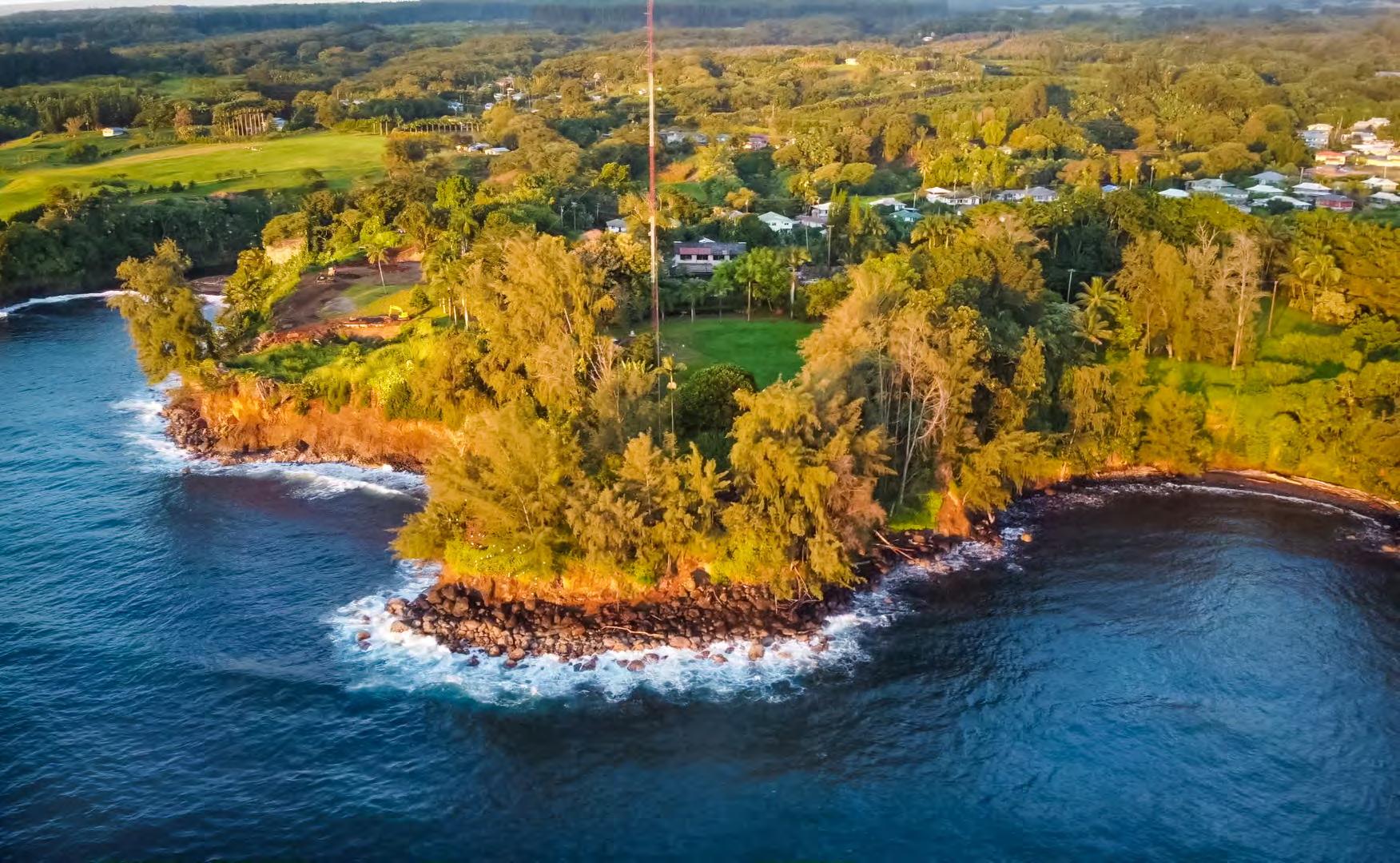
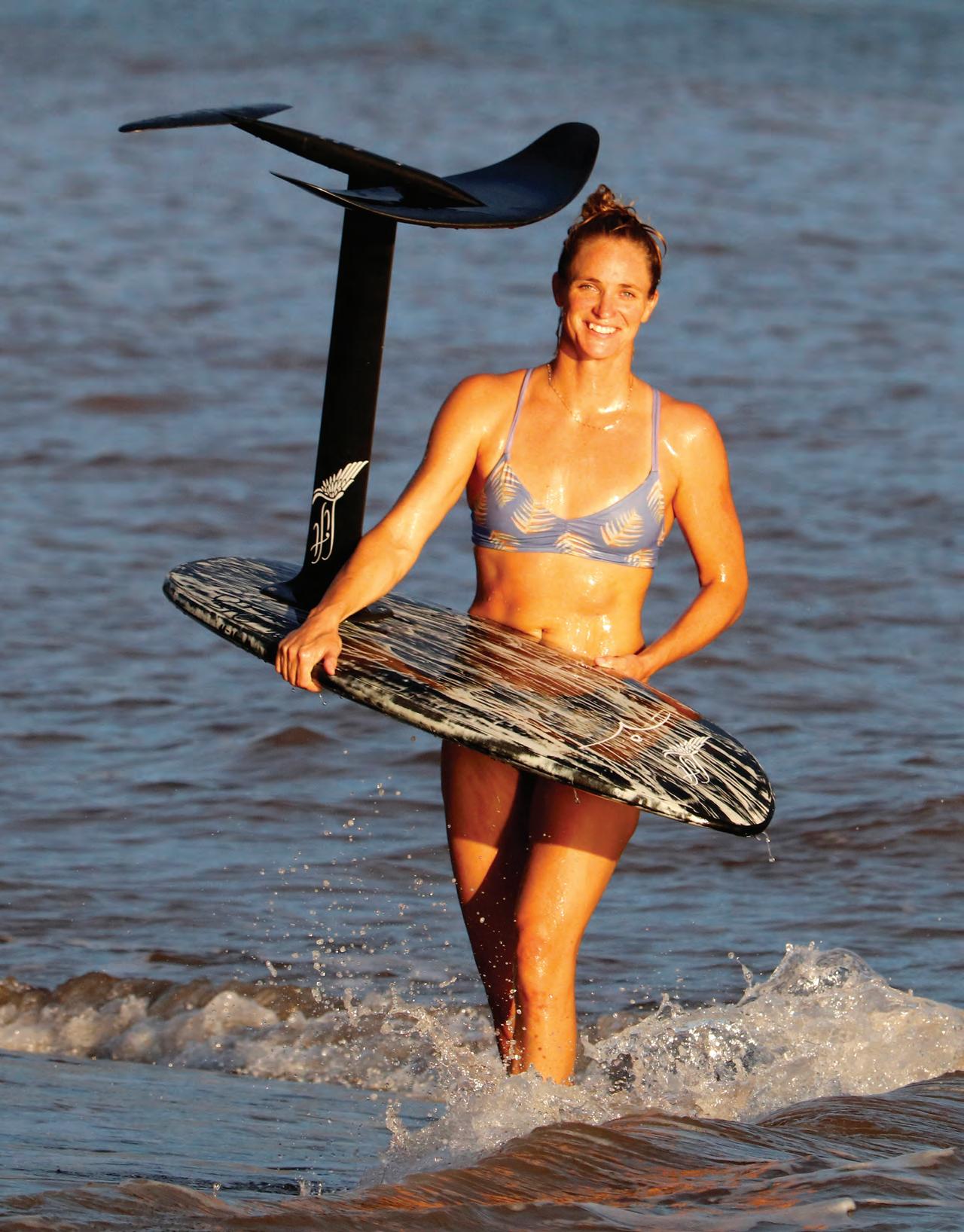
Paige Alms is a trailblazer in promoting the advancement of women’s surfing, and has worked to bring more attention and recognition to female surfers. Recognized as one of Maui’s “token” female big wave surfers, she currently resides in Haiku, just minutes away from Pe’ahi (aka Jaws).
Her career has been full of conquering giant waves and dominating titles, including her 3 Pe’ahi Challenge wins, 2 World Surf League (WSL) Big Wave world titles, and recently for the Red Bull Magnitude Best Paddle and Best Ride of the Season in Hawaii at Jaws in 2022. This year in January 2023, she was one of the first women to compete in The Eddie Aikau Big Wave Invitational, a big wave surfing tournament, where she had the highest heat total and best ride of the women.
Paige, can you share about your upbringing and background?
I was born and lived my youngest years in Victoria, British Columbia, Canada. I had a free-spirited childhood. My mom and I left BC when I was seven and a half years old.
It was my mom’s dream to travel around Australia, so she sold the house I grew up in, and we packed everything into storage and headed off to Australia, just my mom and me.
We ended up traveling the whole country for almost ten months; it was quite an experience! Australia welcomes travelers. Almost every single town has a campground, allowing us to live out of a van for our entire adventure. Our life was full of camping and visiting my mom’s friends, but mostly it was just the two of us. These memorable and formative experiences stuck with me and inspired me to seek more adventure.
Throughout our travels, we always visited Maui once or twice a year since I was born. My aunt and uncle lived in Maui so on our way to Australia, we stopped there to visit. On our way back to Canada, we made one last hop to Hawaii and we decided to stay and make it our home.
What were you doing for school during that time?
I was always ahead in school, so I didn’t do nearly as much schoolwork as I should have during that year in Australia. I was reading and studying math the whole time we traveled, but it wasn’t necessarily a program. I enjoyed math and reading at that age, so it was something I did whether I was in school or not.
When we finally decided to settle in Hawaii, I was still ahead of my classmates. I was 9 then, in the fourth grade, and spent most of my free time at the beach.
I felt confident and comfortable in the ocean, I was a good swimmer. I started playing on my boogie board at my local home break, Ho’okipa, to try to stand up on it; I spent about a year learning the currents. One day my auntie gave me a surfboard to play around with, and before I knew it, I learned how to surf; I continue to surf there every day.
When did you move from play to competition?
I did my first surf contest at ten years old on Maui at Launiupoko Beach Park. I surfed with a team and started to build great relationships. The surf was small, and I placed third. But the competition–I loved everything about it! I was very competitive and determined to get better, I think that helped guide me.
As a kid growing up, I was entering surf events around Maui and the Hawaiian Islands nonstop. In my teenage years, I was entering contests about twice a month.
The contests were something that I looked forward to, and were very important to me at that age. They pushed me toward bigger goals after each one.
By the age of 18, I moved into my professional career where I was competing in events around the world and on a tour schedule.
That path led me to becoming a professional big-wave surfer competing in one or two events each year.
Where in the world has your career enabled you to travel?
I have been able to travel all over the world. Some of the events I’ve competed in were in Australia, North and South America, and Mexico. I have been to Fiji a bunch of times, and to South Africa which is the furthest I’ve been from Hawaii.
What is something unique that your career has given you?
I had an opportunity to be in a documentary film called The Wave I Ride. I also was featured in a short film, Paige with the Patagonia company.
Who has inspired you or has been your mentor?
My mom. She has always been my backbone, guiding me in everything I do. Anyone who knows my mom knows her power. I am so grateful for her.
There have also been a handful of people who have helped me see my path, including surfboard shaper Chris Vandervoort. Chris was a huge influence in getting me to ride bigger waves. He was tough on me in a way that pushed me to be my best.
Chris believed in me, that I had good wave selection and knowledge of the ocean. Chris was instrumental in getting me into and showing me what big waves were by taking me out for my first big wave paddle session at an outer reef here on Maui when I was 15.
I’m also constantly inspired by the people around me who are my peers and have pushed me to be a better surfer.
What competition have you entered that makes you the proudest?
Until 2016, all of the big wave events that had been held worldwide were only for men, and I would watch the contest take place wondering why women weren’t included.
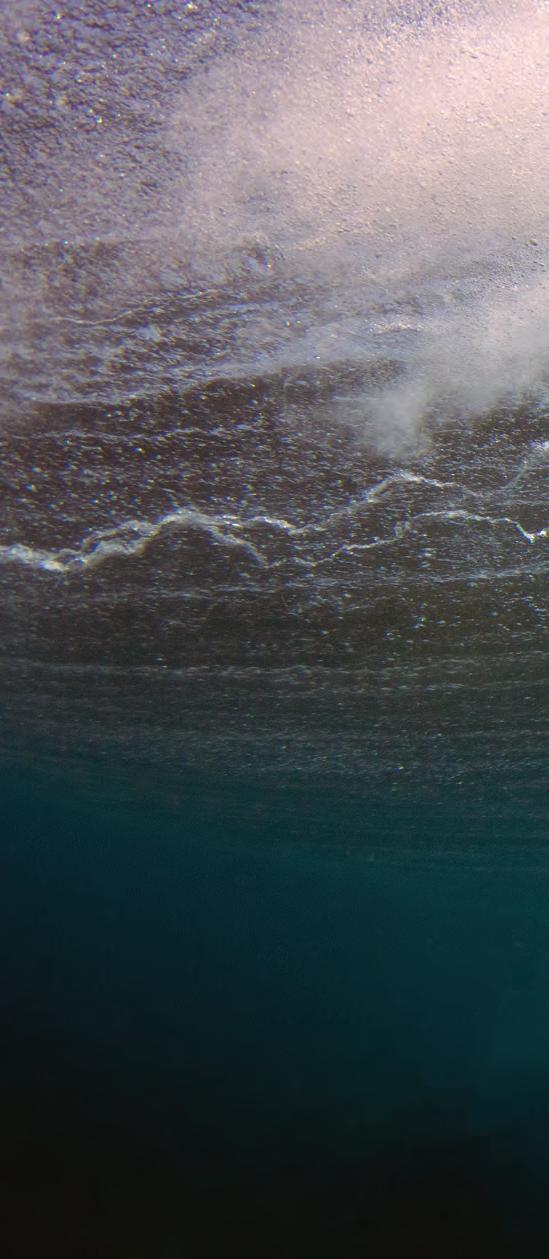

For almost 15 years before 2016, women surfers had to stand up and use their voices to be included. Finally, someone was listening and we were invited to be a part of the events at Jaws
This was exciting because there were a handful of us who had been surfing there alongside the guys for many years. That first year being allowed in these competitions was really special, especially because I won the event.
It came with mixed emotions though, the guys had multiple events, and we only participated in one event at Jaws, but it was still a turning point, moving in a more accepted direction for the sport.
Do you feel out of balance when you are out of the ocean?
Yes! I just truly love surfing, and I love being in and around the water. If I go on a trip and I’m away from the ocean, I feel a little bit off. Growing up here in Maui, surrounded by the Pacific Ocean, I feel a huge connection to the water. And I mean, all of us are made up of salt water. So, I feel like when I’m in it, I truly feel at peace and just connected to my part in this world. I don’t know how else to describe it, but I feel like my true self, whether it’s surfing or just lying in a shallow ocean pond.
Taking a step back and looking at the ocean, I know it has given me my career. It’s given me the house I live in and all the amazing friends around my family. I feel like Mother Nature and the ocean has supported me. And with that, I feel responsible for doing my part to help give back by helping to create more awareness of the impact we are all having on our lands and oceans.
Where are you putting your time into environmental awareness?
I started a program called the Trashy Selfie Project with my friend Sarah Houser. We created an Instagram challenge to get both adults and kids involved in picking up trash at their local beaches, parks, and local environment.
Many of my sponsors became involved to help reward kids for doing their Trashy Selfies. It’s a positive way to encourage responsibility in all of us to be aware of our surroundings and if you see trash on the ground, to pick it up, even if it isn’t yours.
I have also fallen in love with regenerative farming! I’m currently in the middle of taking a permaculture course, it fulfills my being down to the core. Being a part of this gives me the same feeling as surfing and riding big waves.
What is the importance of doing what you love?
If you’re doing something you love, I think it’s important to share your experiences and inspire others to do the same.
I’m also inspired by the Maui Huliau Foundation, it is an incredible nonprofit that my friend Malia Cahill supports. It’s a great youth program that promotes environmental literacy and leadership.
The foundation encourages kids to get involved in making change, through filmmaking clubs, after-school programs, and in-school programs for kids from all around the island. They’re learning how to use cameras and share stories through independent films. The films are related to ocean protection or ecosystem resilience; informative environmental film projects that are rad - for kids to see and not just talk about our problems but putting their words into action for solutions.
What supportive advice would you give to young kids, especially girls who want to pursue their curiosity about riding waves?
If I were to go back and give myself advice, I would want to remember advice I was told by my mom, “to set goals and believe in your dreams.”
Anything is possible. If you focus on putting your mindset and hard work toward your goals and your dreams. Nothing can stop you if you truly believe in yourself!
Be dedicated to achieving your goals. No dream is too big. You only live this one life. If you’re living and doing something that you don’t truly love, then what’s the point?
If something makes your soul glow and you feel a true passion for it, you must follow that.
Where will your ambitions lead you this year?
This year I am hoping to catch the biggest wave that I’ve ever ridden and also experience a giant Jaws barrel.
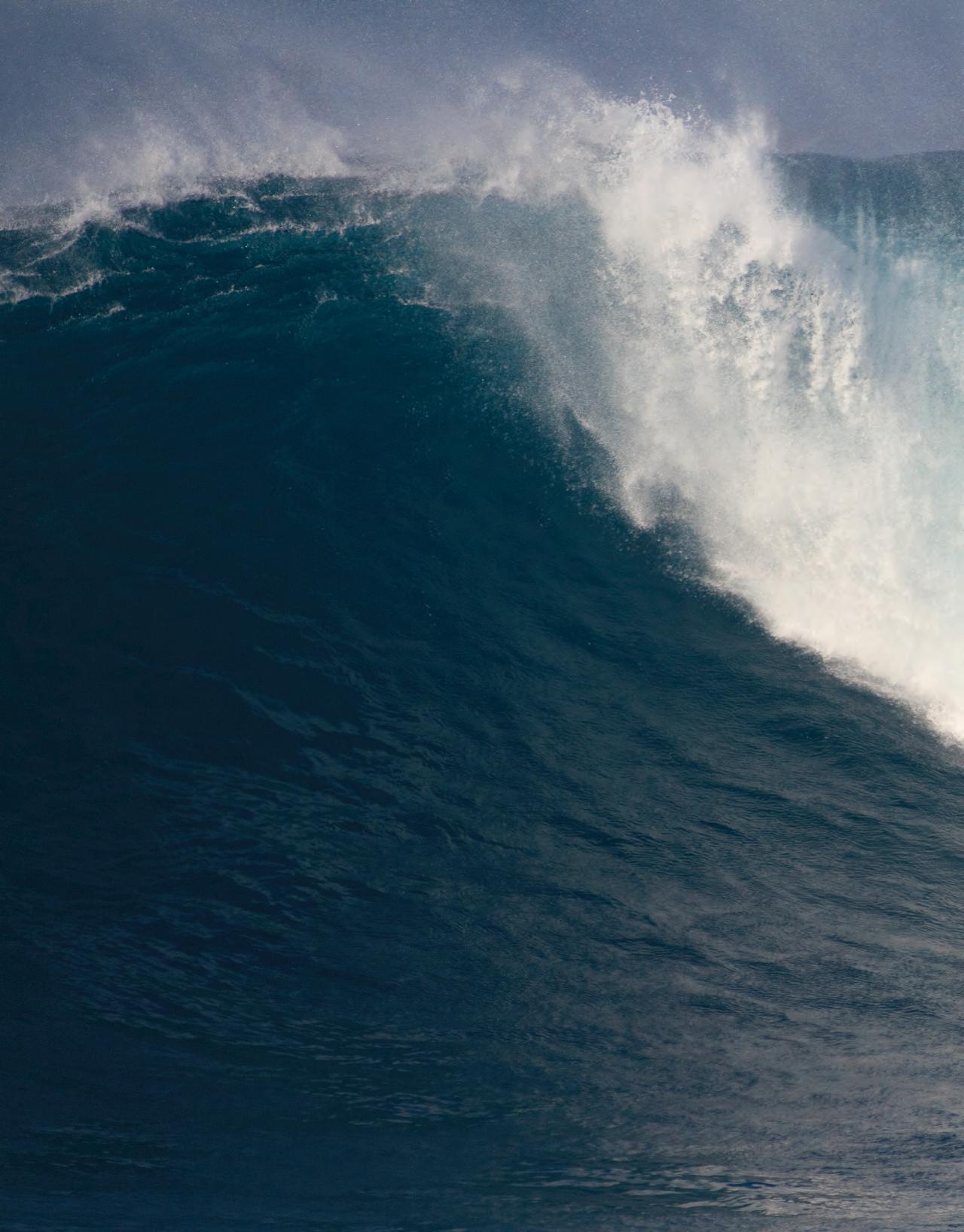
I’m also a part of a film project that will begin in Hollywood any day. The film is based on a New York Times article that three of my friends and I were a part of a few years ago. Charlize Theron’s production company purchased the life rights to this story.
Filming will start soon, and hopefully, all four of us will get to do our stunts in the project.
And what is the best way for people to find and follow you?
Social media. My Instagram is: @PaigeAlms u

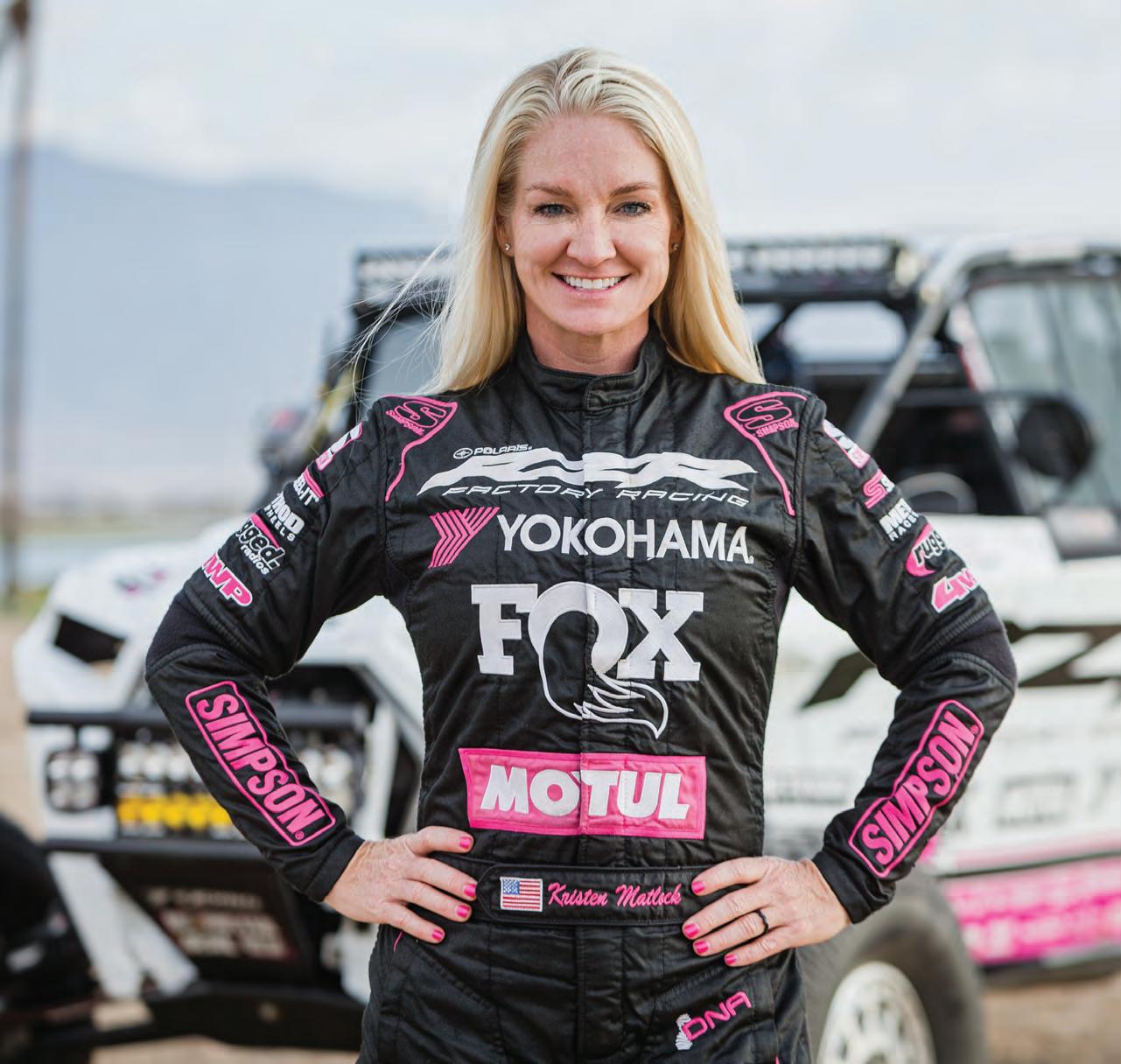
In the world of Baja off-road racing, she’s known as the Iron Woman. Kristen Matlock is a fighter, a competitor, and in races like the Baja 500 or 1000, there’s no sharing the driver’s seat. She’s up for it. That passion for off-road racing, that energy she has to compete for over 20 consecutive hours at a time, comes from her willpower, and her husband, Wayne, who introduced her to this world.

Where are you from and what was your childhood like?
I was born and raised an only child in San Diego, and never left. Growing up, I tried everything involving the outdoors, adventure, and athletics. My parents always encouraged me to go after what I was interested in, so I tried every single type of dancing, figure skating, and roller skating, gymnastics, cheerleading, and horse riding; nothing ever stuck or struck my passion. I loved school and was good at it; I took advanced placement math classes for fun but wanted to find my extracurricular focus.
When I was sixteen, I went camping with my friends out in our local deserts in El Centro and Yuma, Arizona. It was an incredible place to ride off-road vehicles. When I started going with them on these trips, I found myself surrounded by motorcycles, ATVs, and dune buggies. And I was instantly drawn to the power of “desert toys.”
My first desert experience was breathtaking because I had driven past the dunes before on my way to other destinations but never stopped to walk among them. Stepping into that sand for the first time felt like a beach without water. It was a unique experience so many miles away from the shoreline, and I was playing in what was once the bottom of the ocean. A great reality check.
As soon as I graduated high school, I became a registered nurse. I was twenty when I met Wayne (my husband) at a campfire one night on a desert camping trip with friends. I had stayed back one evening nursing a broken wrist from my ride earlier that day, and he decided to keep me company as our friends went for a night desert ride, and we have been together ever since.
Wayne grew up exposed to off-road racing through his father, who raced motorcycles, three-wheelers, and ATVs, and taught Wayne everything he knew.
As Wayne was just getting started in the sport at the age of 23, I supported him in the early 2000s by becoming his team manager.
In 2004 for Christmas, my husband bought me an ATV because he saw my desire to get out and ride. I finally had been stricken with passion for something.
When did you realize you wanted to race?
The thought came to me while watching Wayne at his races. With his guidance, I practiced and improved my skills. I thought, “I’m getting good enough to probably race one of the smaller or the local races.”
It was the winter desert season of 2005 when I entered my first race against the men. I just wanted to see if I could survive it the first time. I placed second in the class I entered and had the time of my life. I was hooked.
When I first started racing, it was a very male-dominated sport. In my next race, out of 150 people who entered, I was the only woman on an ATV in my class. I placed again!
I was now officially hooked! And race after race, I began to notice that the more time I spent out in the lineup, I saw other women on the sidelines witnessing what I was doing.
Within six months to a year later, it seemed like I had inspired some other women to get out there and give it a try.
Observing this lit a fire under me. Honestly, to this day, that’s what inspires me to go out and be the best I can be on the racecourse.
A lot of it for me is to prove to other women, no matter what age, that they could get out there and do it just the same as me. I started a racing career, what I consider to be “later in life,” starting in a new discipline at 20. To me, that’s old compared to others who had been trained and conditioned for the sport since they were kids.
By 2015, the ATV market and craze began to dwindle but at the same time, the brands were bringing in a new vehicle called a UTV.
During this time, my husband and I decided to become an officially registered team, Matlock Racing.
We spent the first ten years of our relationship in the world of offroad racing, so we decided to pursue it differently.
We were currently with Honda at the time on ATVs. My husband raced for Honda professionally for eight years, then decided to expand and approach Polaris RZR, a huge brand.

When we pitched Polaris, they told us regardless of our accomplishments, background, or history, we would have to prove to them that he could get out there and do the same level of racing on UTVs before they signed him on as a factory driver.
I returned to my position as manager and team supporter, and drove the truck down in Baja with our yellow lab, Whiskey, by my side. Most of the time, it was just the dog and me chasing my husband through Baja.
After my husband won the overall for the Baja 500 and the Baja 1000 with the UTV, we went back to Polaris. They were interested in signing with us. During our meeting, I caught their attention with my racing history. They knew I had five women’s championships in our local desert on ATVs but didn’t have experience with UTVs at all.
I never imagined that I would end up behind the wheel of one of them. Polaris decided to sign my husband and me into a factory-supported program they had, and I was completely blown away and ecstatic.
I have now been with Polaris RZR for eight years.
In 2016 when I started racing UTVs, I was one of the first woman in Baja at any of the Baja races. The one that I’m most proud of is the Iron Woman for the Baja 1000, the first one in history in a four-wheel offroad vehicle. I’m the first woman to have accomplished this.
I have yet to win the UTV overall in the Baja 1000. That is my ultimate goal for this year in November.
With the demands of a racing lifestyle, how were you able to factor in motherhood?
While racing ATVs from 2005 to 2015, I wanted to take some time off to have children. During that time frame, I had two boys. I had the first one in 2009, and within two months I was back on the ATV because I figured what better exercise than getting right back at it.
Then two years later, unaware of being pregnant, I raced when I was four months along. I immediately stopped once I knew, and I had my second son that year. Both boys have racing in their blood! They are constantly increasing their skill levels and already have impressive racing styles.
Do you ever hear them say I want to be just like mom?
Yes, they are my number one fans by far next to my husband and family. I have so much support, and the racing life is a family affair for us.
What are you involved with that gives back to the community?
Every summer I organize a ride to a local orphanage in Baja, Mexico. We take about 80 attendees with us, and I gather whatever that orphanage may need before we begin the adventure.
We show up to the orphanage on a Saturday, taking every single orphan in our off-road vehicles for rides. That is the highlight for all of us on the ride. When you look around, everyone is smiling from ear to ear.
We used to do this ride for fun, and then one day, I asked myself, what can we possibly do to improve this experience and give back to Baja? I thought, “There’s got to be something we can do on this extra day to help benefit and give back.” From that day forward it also became a part of our lives.
What are your racing plans for the rest of 2023?
I have five races this year. Four of those are in the “The Score Baja” series. The San Felipe 250 (the season opener in March), the Baja 500 in June, the Baja 400 in September, and the Baja 1000 in November. Each event has a number attached to the title for the miles to race.
I often look for God’s answers. I look for a sign from him. I will talk to him during the races because our races are very long. This past year at the Baja 1000 was the first time I ever experienced one of my deep conversations with Him.

I had a rough race because about a hundred miles into the race, I spiked a fever of 102 degrees. I was only a couple of hours in, and I had to run for 25 total hours at that event. I had to push myself further than I ever have in my life.
I was pushing beyond my limits, but I have that determination and desire to never give up. I couldn’t let my team down. I couldn’t let the co-driver sitting next to me down or myself and the fans out there. I was looking for some motivation and support throughout the entire race. Along with the support of my team on my headset, I talked to God, and I made it through.
Everyone on our team deserves the recognition that I deserve just the same. Every time I get up on that stage, I always like to thank our crew, our mechanics, the guy sitting next to me (which would be my co-driver at the time). I’m grateful for all the support from family, including our two boys who are always cheering us on. I can see in my sons’ eyes that they want to do this someday. They truly believe in us, and we inspire them just like they have inspired my husband and I. For the beginning of it all, My husband Wayne. He has always been my pillar of support and encouragement as I propelled forward in life.
What is the best way for people to find and follow you?
Instagram: @KristenMatlock | Facebook: Kristen Matlock Racing u

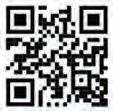
Did you know 95% of all purchases will happen online by the year 2040? Our clients report an average advertising return of over 300%.


Ranked No. 4 coworking space in the U.S. by Inc.com, CO+HOOTS currently houses more than 1,000 scaling entrepreneurs and small businesses across two Arizona cities, was the first coworking space in Phoenix and has been an integral role in creating thousands of jobs locally.
Jenny serves as an advisor for numerous startups, Board Chair of CO+HOOTS Foundation (a 501c3 nonprofit) and as a mentor for several young entrepreneurs. Jenny was named Phoenix Business Journal’s 2016 Phoenix Businessperson of the Year. The first minority and the first woman to receive the honor.
I’m the daughter of refugees. My parents were refugees from Vietnam during the Vietnam War. I grew up in a small restaurant that my parents started before I was born. They told me never to become an entrepreneur because it was the hardest thing they have ever done and didn’t want that level of struggle and instability for me.
These are the key things that have informed my journey in entrepreneurship. I became an entrepreneur whose life’s work is focused on helping underrepresented entrepreneurs grow and thrive in business. It is my life’s mission to make our communities more equitable and accessible so people like my parents, who decided to make the leap into entrepreneurship, have the best chance of success.
In 2008 I was the art director for various publications at the Arizona Republic. When the recession hit, all of the publications I was working on closed and I lost my job. That was when I realized having a job can be just as unstable as being an entrepreneur. So, I started my marketing agency and made the lead to becoming an entrepreneur. I quickly realized that I didn’t know what I was doing other than some of the basics I had picked up from my parents. I didn’t know how to run or grow a business. I could make a profit-loss statement, but I didn’t know how to manage people. I needed guidance and people to help me navigate the journey. This is why I started CO+HOOTS, the first coworking space and entrepreneur center in Phoenix. Today we serve over a thousand businesses as a safe space where people of all backgrounds can feel find help in growing their businesses. We have two locations focusing on incubation, entrepreneurship, training, and programming and serve thousands of people annually.
When a recession happens, swarms of people become entrepreneurs out of necessity. The mass layoffs often result in a surge of new businesses created because they have to build their own income. I happened to have launched CO+HOOTS during the last recession because I was one of those people who lost my job. It started with just a couple of us entrepreneurs in a room and quickly became five. Then five became 12, 12 became 25, 24 became hundreds and suddenly (and not suddenly) we were not just a coworking space but an entrepreneurship center. We launched incubation programming. We created an entrepreneurship program in partnership with
Benedictine University, where we help students build an entrepreneur mindset and launch startups during their time at the university.
As we dug deeper into building entrepreneur ecosystems, we saw a real alignment with local governments who shared our mission around building equity in our communities. The pandemic exacerbated the wealth gap and we saw an outrageous number of businesses struggling at unprecedented numbers. And the government wanted to play a role in the recovery. So in 2020 we launched HUUB a digital platform built to help municipalities and entire communities deliver grants, trainings, 1:1 assistance and connections to business owners and, as a result, see their most marginalized communities build wealth.
HUUB is a digital platform that helps create access to all resources that entrepreneurs need and includes tools to help economic developers engage their community while producing data to make better decisions about how they serve their community. The platform is free to all businesses and accessible to anyone with a cell signal or internet connection. We bring together government resources, with partner organizations programs, tapping into funding mechanisms, training, connecting to expert advisors, and expanding networks and other resources for all, especially underrepresented entrepreneurs. Today, we serve more than 3,000 businesses across Arizona and are expanding nationally.
Jenny, can you paint us a picture of your childhood, your parent’s story, and how their story helped you write your story?
I am the middle child, with an older brother, and younger sister. We grew up in the suburban town of Eden Prairie, Minnesota. While we grew up around a lot of middle class families, we functioned very differently than my peers. After school, I didn’t go home and play video games, we were often shuttled to the restaurant to help and do homework.
It was a small Chinese-Vietnamese restaurant called Camdi, named after my fireball of a mother. We would go there every day after school and spend our time in a little room in the basement where big bags of rice and packaged goods were stored. It was our playroom, homework room, and space to take a quick nap when we were tired. As we got older, we would work at the restaurant, prepping, washing dishes, serving, and clearing tables.
As we grew up, many decisions were made based on the needs of the restaurant. We knew we had to stay close to home to support the business. When my peers were touring colleges all around the country, I knew I had one option and that was the university near the restaurant. Eventually, my parents did try to grow their businesses. They tried to launch two more locations but had to close them because they didn’t have the management experience to sustain them. The failure of those two restaurants caused my parents to build a lot of debt and resulted in them working a lot longer than they really needed to, all things that could have been avoided with the right network and people guiding them.
Because of my parent’s backgrounds as refugees and the lack of systems that could support them, they were destined for small business ownership. They had very little luck being employed at jobs that were above minimum wage. My parents started the restaurant in the 1970s with my mom leading the idea while my dad worked in corporate America. At this time, women were not legally allowed to have a business checking account.
My mom knew she couldn’t get a loan. So she negotiated with the previous owner to buy the business as a lease-to-own agreement and take over the business. This helped her avoid dealing with a bank loan that she likely wouldn’t be approved for. My parents ran the business for 40 years.
My mom is a fireball. People would often comment - “We have no idea how she can run the kitchen, clean dishes, operate the entire business, and serve the number of customers she serves. How does she do that?”
Well, it’s with a lot of systems and processes she’s developed to make sure she is as efficient as possible. She preps well, so she can easily turn out the dishes quickly which is where I think I got my obsession with automating processes with technology. My parents did everything themselves; while they never were rich, they were successful enough to put their three kids through school, and they retired last year.
Who in your life inspires you to stay focused on progress for the future?
You can probably guess this, but my mom of course. She is a fiery spirit. She was adopted as a child in Vietnam, and she grew up in a pretty poor family. She’s just scrappy and sharp as a knife. She would bike to the next town over, buy the bread that was yesterday’s bread at half price, and then bike back into Saigon to sell the bread at regular price. She always figured it out. And I think that kind of mentality has rubbed off on me and is such a gift as an entrepreneur – knowing that everything is figure-out-able.
I’ve seen how access to networks and better understanding of money dynamics can change the trajectory of small businesses and shrink the wealth gap. My mom had to build her network from nothing. Coming here not knowing the language, not having any connections or money, and still being able to build what she built is a huge accomplishment. Yet, I often think, how far could she have gone if she had known about these other existing resources?
I think about our relationship with money as it is relating to owning a building. They rented their building for 40 years and paid rent yearly to a person who got rich from them. If you calculate how much they had paid in rent, utilities, and additional expenses, they could have bought the entire building twice over. Knowing this drives my work with HUUB and CO+HOOTS to help business owners understand the mechanisms they can use to build wealth.

When you rent, you pay an extra fee. When you own, you pay a mortgage and have an asset. Buying a building is the same mental process as owning a home.
I had a good friend sit me down and explained to me, “You can do this. You have enough to show that you can do this. Different kinds of loans allow you to qualify to buy this building. It’s not going to be easy, but you can qualify. You also have been in business, you are a woman and own a minority-owned business - banks want to fund projects like this. You have a proven record.” I still was really scared.
I came from a place where we had very little growing up and was told only the rich could afford to buy buildings. So that was the lens I saw the
world through. I would never be able to afford to own a building. That all changed when I met a financial advisor who walked me through how to create a livelihood for ourselves, our community, and our children through building ownership and a stable business. He broke down the numbers and helped me plan how I could afford the loan and what it would mean for me, my business, and my work. And it was so simple! I didn’t realize that it was possible, but it was, and it was a game-changer.
Now through HUUB, I can give every business owner that gift of a connection to a person who can change your business and life forever. I advocate a lot around entrepreneur education and expanding networks, because someone was kind enough, and had the patience to help me thrive.

How do aspiring entrepreneurs find you and the HUUB’s website?
joinhuub.com - it is the access to our government platform for business owners, free in every city where it exists.
jenny@cohoots.com | jenny@joinhuub.com
LinkedIn | Instagram | Facebook | Twitter u
Nominate a person who inspires you! This can be a family member, friend, neighbor, co-worker, or someone in your community. A person who stands out in an awesome way by just being themselves!
A person who Inspires you to do better in the world. A person who leads by example. A person who you would consider a humble hero.
Every quarter, Inspired Success Magazine will select two people from the submissions for an article interview and have the nominees featured in the next upcoming issue. These nominees will be featured in both online and print versions of the magazine.
Visit Inspiredsuccessmagazine.com to submit your nominee!
Cathi Jo is an active member of the foster care community as a foster parent, parent mentor for birth parents who have lost their children to DHS, and to other foster parents. Cathi Jo was a pastor for 25 years and she currently is a lead concierge networking business leader and a production coordinator. Cathi Jo’s passion is to create life changing moments for individuals so they can and will live their lives to the full potential - helping people dream again and find who they were created to be.

I was born the youngest of 3 in rural Sioux Falls, South Dakota, and raised by an incredibly strong, trailblazing, hippie, white, single mother. I had a beautiful childhood filled with joy, happiness, affection, connection, and support. My mom was a beautician, owned her business, and was elected to boards, all unheard of for a woman in the ‘60s and ‘70s. I can’t think of anything I was denied, even though we were incredibly poor.
As a child, I got in trouble often because I never wore shoes. My mom would say, “you got skin, just head on in.” And that wasn’t acceptable. The no shirt, no shoes, no service saying wasn’t written for us - we loved the earth, we loved the creator. I just thought everybody was happy like us and had a good life.
When did life begin to show you that there were more colors to it?
My friend Maria gave me one of the greatest gifts in my 12-year-old young life. She was diagnosed with a terminal disease and would not live much longer.
That day is biblical in who I became because I realized nothing lasts forever and you can’t let fear be your motivator. It must be joy, life, and happiness. Another lesson I learned was from my mother who fought for all of us –whether it be school problems or a dyslexia diagnosis, she would never accept the negative in anything. I’ve carried that attitude into my adult life. I’ve had cancer, I have MS, and I have faced many medical tragedies. The day I was diagnosed with cancer, I was sitting alone, a single mother with 12 kids living in my house. This was one of the best days ever because this would help me meet some of my goals. That’s the spin my mom put on everything - be positive. A problem is just a way to be creative.
What age were you when you got the cancer diagnosis? How many children were biological, and how many were fostered?
I was 42. I had a double mastectomy, which didn’t even slow me down. I was incredibly busy with four birth kids, three adopted kids, and five foster kids at that time.
How long after your fourth child was born did you consider fostering?
I was married at 23, had my first child at 24, and boom, boom, boom, there were four! I knew I was created to be a mother like my mom was. My youngest child was two years old when we brought in the first foster child, my ex-husband and I fostered about 12 individuals over six years. That was wonderful! We divorced when I was 36, and I moved with my birth children back to South Dakota.
Why did you get re-licensed to foster after your divorce?
At first, I wasn’t going to because I was a single mom. But I got a call from a judge in Nebraska who said, “Hey, I have a little girl sitting in front of me that says you’re her mom.” It was Lexi, who I had had for three years when we lived in Nebraska. So I proceeded to get my South Dakota license, you
have to be licensed in the state you are residing in to foster in that area. Lexi was 14 and came to be my first adopted child.
I became a single licensed foster parent, and the Department of Social Services (DSS) never stopped calling. Over the next 15 years, we had 34 kids that came through our home. Most of them called me Mama Jo. It was the best thing I’ve ever done for me, for them, and for my birth children.

These kids know what broken promises cost – yet they learned how someone could love them unconditionally and still let go. They have nothing, no address, and no one to help with financial aid, college admission, or becoming a responsible adult. Many stay in contact with me after they’ve aged out of the system. When they turn 18, insurance and funding are turned off. I would still be their mom because they needed me, and state systems do a poor job of following up on our kids.
That’s a lot happening for a 42-year-old with a recent cancer diagnosis!
When you get a cancer diagnosis, you learn who is in your circle and who threw the parties in your absence. I became aware of the people who stepped up, not just for me but for my kids.
You were a pastor. How did this change for you after your cancer diagnosis?
I was a pastor from when I was 23 until the day I was diagnosed with cancer. I knew that cancer patients did not make great pastors and that the kids I was surrounded with would never be good pastors’ kids. It was not in the best interest for my family and our relationship with our community to stay in that position. I needed to move on to place my family in the best emotional position and to avoid fretting about the next meal.
People have often said, “Cathi Jo, you must have the biggest heart, and you’re so cool and awesome.”
The whole truth is I’m very selfish.
What do you mean by selfish?
I’m always surrounded by energetic young adults and enjoy watching them
succeed over the years as they grow.
It’s incredible watching kids learn to stand up for themselves without being abused or abusing others. I watch the kids welcome other new foster kids into our home and say, “You’ll love it here.”
It’s when their eyes sparkle a little bit, without fear, confusion, or doubt, but with certainty. And when they say, “I need you” or, “I need your help.” It’s powerful.
So, selfish? It’s because of how full they make my life feel and I love every minute of it.
What is one of the challenging experiences you have had while being a foster parent?
My oldest son was going to buy his first house at age 23 and wanted me to look at it first. I drove there in my 15-passenger red van with nine kids under the age of 12. I went in while the kids played tag in the yard. When I came out, I heard an adult male voice and a lot of yelling. He was very derogatory and called me a white trash woman and made a crude comment about not having a husband and multi-racial kids.
I immediately felt sorry for this man. And suddenly, I was no longer ignorant of what my kids would face for the rest of their lives.
Another time I was in line at Walmart with six kids all pestering me for candy. I said, “Stop. You can look and not touch.” One of two ladies in front of me wearing a gigantic red hat with purple ribbons turned to me and said, “Pick an ethnicity, you tramp!” I felt I needed to retaliate in some way, but my daughter Lexi, 15 at the time, stepped right between the big hat lady and me, looked me straight in the eye, and very calmly said, “She’s not worth it, mom, she doesn’t see your heart.” Lexi then turned, hugged the woman, and said, “I wish upon you 1/10th of my mother’s heart.”
That’s why I do foster care because there’s no reason that Lexi should have hugged that woman. She had a bigger heart than a judgmental millionaire who had been given life on a silver platter.
How can people help with foster care?
Not everyone needs to become a foster parent but here is something that everyone can do to help a foster family.
There is a great organization called Royal Family KIDS Camp (forthechildren.org).
They have camps all over the United States where you can help in many ways. And every community has a foster care support system where you can help the foster parents and foster kids.
The reimbursement from the state for foster care of eleven dollars a day does not go far when the foster parent has to pay for everything - clothing, food, medications, school supplies, activities, and transportation.
Some bad foster parents do it for the “money”. I’m sorry for them and the kids who experience even more pain in their foster home. But there are many foster parents out there trying to help kids be able to dream beyond where they are.
How much scrutiny goes into licensing foster parents? Is the system so overwhelmed that they put children anywhere?
Every state is different. Some states are so overrun, and other states are very
careful. Problems exist because there is no standard from state to state. In South Dakota, many of our kids in foster care are Native American. These kids can’t go through the system the same way as others, as they are a sovereign nation. It’s very complicated. I think what has to happen is everybody needs to take accountability for the foster kids. Every neighbor, every school, every community. People need to step up with extra love, guidance, and much mentoring.
Do you believe that foster families have enough support?
No. People are not getting involved because of fear of many things. The majority of concern is looking bad to their neighbors, afraid of what the foster child will expose their child to, and even the fear of not being enough for the foster child.
And I’ve got to tell you, being in foster care, birth parents often report foster parents for abuse. The birth parents will report that the shoes bought for their child are too small, or their earrings were too tight. I’ve chosen to welcome the reporting, because at least it is one way for the parents to stay involved in the child’s life.
The birth parents could discuss many negatives in a foster family, but our family chooses to spin all our situations to the positive. And if that means being reported has to be spun into that the birth family is inspired to have involvement with their child, then I am happy to be on a merry-go-round. That’s a great way to be supportive for the foster child and the birth parent to stay connected.
I never got angry with it. And the next time I would meet the parent, I’d say, “Thank you for bringing that to my attention. I’m so glad you love your child enough that you wouldn’t want that to happen. Next time you can call me, and we can work through these things ourselves and co-parent. It seems like you still want to be involved.”
What are you developing this year that will support changing the stigma of foster care?
I’m focusing my time on a support group for foster families in my surrounding communities. My family has purchased a 18 acre property to develop a safe space for healing for foster kids and their birth families. It will be a place for us to be real together. We call it Crowded Table Farms. The property will have chickens, pigs, and a few cows, and I will garden again – barefoot!
My bucket is full of my kids, their partners, and children. I want to live my life in absolute peace and delight sitting around our crowded table in our home. Do you have a favorite prayer, quote, or line that motivates you?
Yes, I always say, “We can do this. Who else will?” And if one of my children says, “I can’t do this,” I always say, “Well, somebody else can. If they can, why can’t you?”
Who has inspired you the most in your life?
That is so easy! My mother Gloria! She is the toughest, baddest, biggest angel there could ever be. She is still a hippie and will tell you peace and love are the only reasons the world keeps moving. She realized she was much better than what she grew up in and would never accept less. She’s brilliant. If only Gloria ran the world! u
Mesha is the CEO of the Arizona Women’s Foundation (AFW) where she fights for the safety, health, and economic empowerment of women in Arizona. Mesha currently serves on the Alliance for Arizona Nonprofits Board of Directors, finance committee, and policy council. She also serves as a trustee with Independent Newsmedia, Inc. Mesha is a recent past chair of vice-chair, finance, and governance chair of Arizona Grantmakers Board of Directors. She is also a member of EPWNG and Charter 100 AZ.
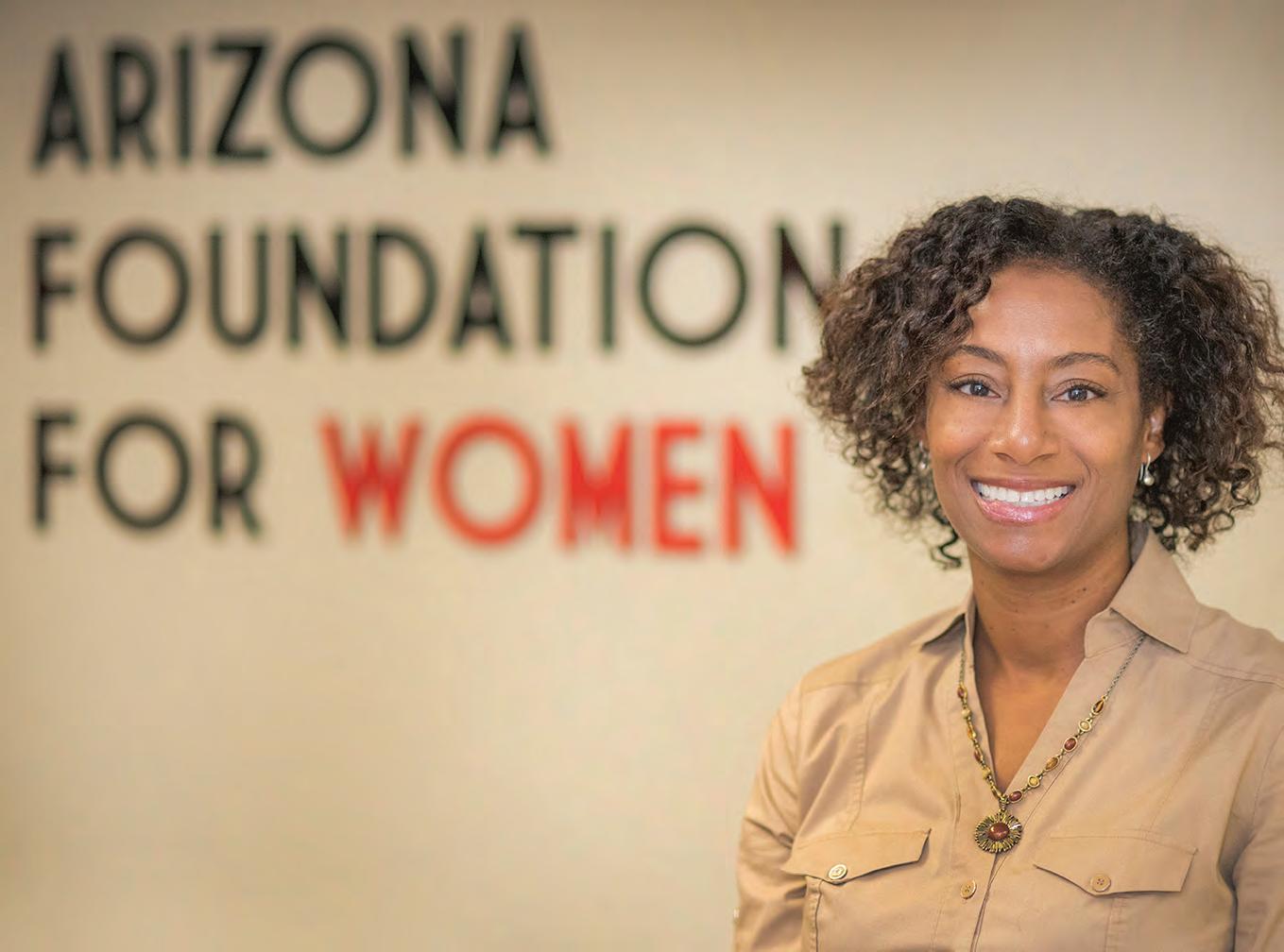
Mesha, can you tell us about your childhood and the drive that led you to where you are today?
In kindergarten, I realized I was not a typical child. I was an only child raised by a single mother. I sensed that I didn’t want to do what was not okay. I respected my elders, yet I questioned why they would like to ask me to do things that didn’t make me happy. For example, at school, no one would listen to the teacher, but they would listen to me. I didn’t always want to do what the teachers asked, so I was labeled a defiant child.
What were you experiencing in your environment when you first saw this happening?
I experienced racism in first grade in Milwaukee, Wisconsin. I was expelled from almost every school from kindergarten to high school. One of my classmates called me the N-word. I didn’t know what it meant, but I knew it was not a good word and it was something that they shouldn’t say to me. I punched him. I knew I should not have reacted this way, but it was my instinct. I was fighting for my rights.
In fifth grade, my mom transferred me to a school in a farmland community because she felt I needed a new experience. Immediately upon entering, I felt there wasn’t anyone there like me.
I was the only black person in this entire school. Yet, when I was introduced to the class, a student picked up a desk, placed it right next to him, and said, “She can sit next to me.” That was the moment I knew I was home. I had the best time at that school.
In high school, my mom took me out of private school because she couldn’t afford the tuition. I went back to Milwaukee and into a program called Chapter 220. The program provided busing for black inner-city students to attend suburban schools and suburban students to attend city specialty schools. The school districts developed the program to integrate students from different communities, and as an incentive, the district would receive additional funding. Unfortunately, after they received the money, the way they had the program set up caused racial tension between the black and white students that were not there before.
I noticed the bused kids had to attend one class where we watched TV and played games. It was a free-for-all! I asked, “Why are we in this room?” I was told, “Because you students are so behind, and your grades are bad.”
I said, “I don’t know whose report card you looked at, but I have straight A’s. I want to be taken out of this class immediately and have a full load, just like every other student.” The teacher said, “Mesha, you can’t tell us what to do.”
Off to the principal I went. I told him how I felt and said I would call Contact 6 at Fox News if I couldn’t leave the classroom. They quickly took me out of the classroom but told me that all the regular classes were too full. I worked the rest of the semester in the school office until the following semester when I was allowed a full load like the other students.
It took time to navigate through others’ ignorance, but I kept my momentum and achievements moving forward by believing in myself.
Where did your momentum and achievements take you next?
I knew what I was going to do. After finishing college, I wanted to be a top VP at a huge advertising agency in New York, Chicago, or LA. I had it all planned.
As a first job to set me on my path, I interviewed for the membership and marketing director position at a local YMCA. I never thought of myself in the nonprofit sector. To prepare, I asked many questions, “How long have you been working here? Do you like it?”
My interview started with the Executive Director saying, “I fired this person last week. I fired that person a month ago, and the person in your position never made it past a year.” He was bragging about firing people! So, I flipped the interview and started drilling them with questions. Later I learned after I left the interview, he said, “Did she interview us, or did we interview her?”
They hired me, and I said to myself, “You know what? I will go in there and prove that I can do this position, and I will make it past a year. I was there for almost 12 years and covered six positions.”
I served on national committees for the YMCA of the USA as a part of the movement and initiative around health. I spearheaded initiatives throughout Milwaukee. I wanted to be over operations, not an executive director or CEO, but they saw something in me. They said, “If you want to do this, you need to be an executive director because the COO oversees all the executive directors, and you need to know what they’ve gone through.”
Who knew that I would love being an executive director? With the Y, you had to do it all. That’s when I fully grasped what running a nonprofit is like. Almost every nonprofit leader can run a corporation.
The CEO running the largest YMCA in the country would call me and ask me to run one of his branches in New York. I didn’t want to go to New York. I wanted to go somewhere warm. Then, there was a leadership change, and I didn’t like the direction. It began to be more about money and business versus relationship-based business.
I always saw the YMCA as being there for people, helping them be healthy and enhance their skills, not so “money” focused. It lost the part about taking care of people. I’m not saying it was in the wrong direction, but it wasn’t for me.
After leaving YMCA, what was next for you?
I wanted to get my arms wrapped around fundraising, so I got a job as vice president of development at an organization and I found that opportunity in the Midwest.
I was fortunate to volunteer for the Women’s Foundation of Minnesota. I helped start a giving circle for African American women where we would raise money to support women-serving organizations for the African American community. I helped write the bylaws and job descriptions. The biggest joy was when we received grants to support these causes.
I had a long-distance relationship with my now husband, and he asked me to move to where he was in Arizona. It took me two years because I didn’t just find and take a job. When I finally moved to Phoenix, Arizona, I had an opportunity to work for an HIV / AIDS organization. I wanted to work for this organization and learn about it. And the best way to learn about and meet people quickly is to do a capital campaign with the city behind you. I took that job and was there for five years.
I saw an opening for the CEO at the Arizona Foundation for Women. Honestly, it was my dream job to be able to get up every day and help women.
I looked at their past leaders and thought they would never hire me because it was always older white women at the helm. I got a call, had a phone
I want women to step up. I want them to be leaders. I want them to know financially what’s going on in their homes. I want to get out there to educate and help women empower themselves. I want them to know they have the right, the ability, and the options.
interview, and then had an in-person interview. What did it mean for me when I met the founder of the organization, Marilyn Seaman? It is amazing to hear her story of why she started the foundation. She noticed that out of all philanthropic dollars in Arizona, only 4% went to help women and girls. She got community leaders together and said, “We need to do something about this. I want to start a foundation.”
It started with domestic violence being our key focus area and then on to the ebbs and flows of need. We’ve always looked for things where we see a gap in what women aren’t getting. I knew this was where I wanted to be to fulfill her mission.
During a strategic planning session, one person remarked, “I don’t know how to explain what we do.” We decided to show our vision through RAP . Research, Advocacy, and Philanthropic work with people who want to give back, to keep women safe, healthy, and economically empowered.
The Greater Phoenix Economic Council did a study they called GPEC. The study showed that if women here in Arizona were afforded the same rights and equal pay as men, our economy in Arizona would grow exponentially because women still make most of the buying decisions for household goods and services.

The support ran strong before COVID. But now - women are not receiving that attention like before. In the early ‘90s, 4% of the philanthropic dollars went to support women and girls – in 2021, it dropped to less than 2%. It’s where we need the most support. So that’s the ‘why’ for me. I want women to step up. I want them to be leaders. I want them to know financially what’s going on in their homes. I want to get out there to educate and help
women empower themselves. I want them to know they have the right, the ability, and the options.
Listen to the whole phrase before you judge what I’m about to say. We, as women, are part of the problem, not purposely. After COVID, I was leading a CEO panel of nonprofits, and I asked the women when we first started how they all were doing. No one said anything. I shared what had happened to me and where I was at mentally. It caused a domino effect. I started hearing about the school shutdowns, being there for the kids, and caring for an elderly parent. When the schools shut down, I asked them how many had discussed with their partner who would stay home with the kids.
None of them. These are all CEOs. And then, I asked how many of their partners have flexible jobs where they could stay home. They all did. I said, “So, no discussion in the home?” And they got angry. I said in followup, “Wait, wait, wait. I’m not trying to make you go home, start a fight with your husband and get a divorce. I just want you to recognize that it’s because it’s in our nature. We instantly, as women, take charge and take care of everything.”
I wanted to let women know that we are part of this problem where we jump right in, burn ourselves out, don’t take care of ourselves, and don’t ask for help. I hope that changes.
Who keeps you inspired to continuously reach for more in life?
My mother wanted a better life for me. Every day I create more strength and momentum for women. I dedicate it to her.

What is the best way for people to find and follow you?
AZFW.org | #SHECOUNTSAZ | Facebook | Instagram u


Being different is Super Normal, and the differences that establish that super normalcy amongst us begin with our value systems.
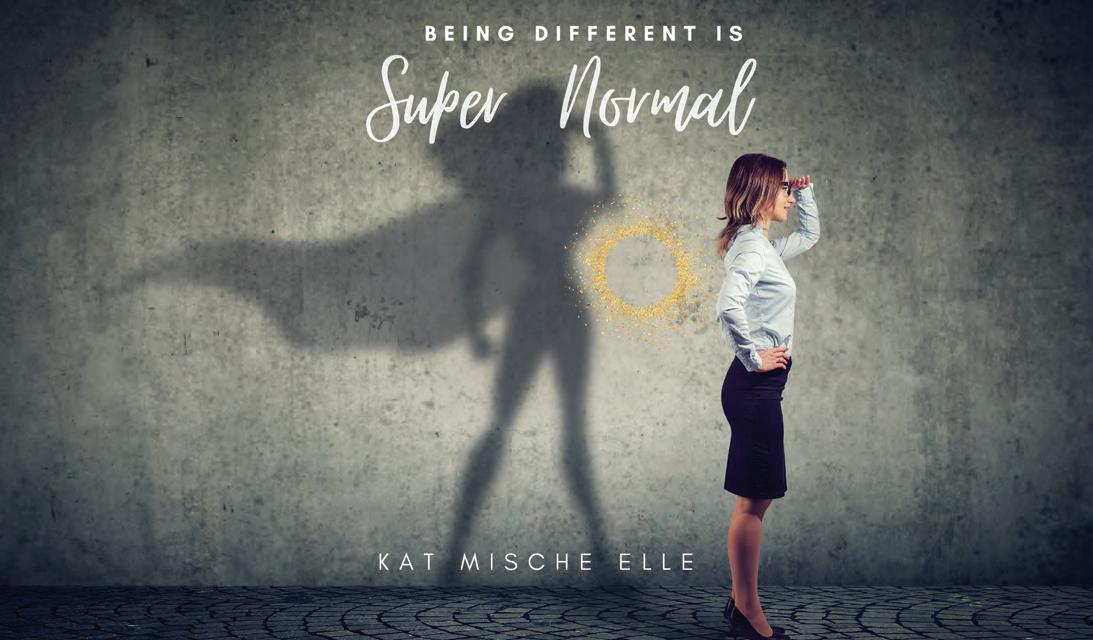
By embracing our unique differences and the values that shape us, we can create a more accepting, diverse, and proactive society. Embracing our individuality can lead to greater understanding, empathy, and on impact for important personal and global endeavors.
When we learn to silence the noise that often fills our minds, we open ourselves up to new ideas and perspectives. It’s easy to get caught up in our personal thoughts and opinions, but by taking the time to truly listen to others, we can gain a greater appreciation for one another. This can ultimately lead to a more harmonious world, where we celebrate our differences and work together towards a common goal.
It’s important to be mindful of the static, (the distractions that are lined up in front of us each day to divert our focus) that can cloud our thinking and prevent us from seeing things from a different point of view. By doing so, we can cultivate a more empathetic and compassionate society, where understanding and respect are at the forefront of our interactions.
Personal values are a set of beliefs and principles that guide an individual’s behavior and decisionmaking. Beliefs and values that guide your behaviors and choices develop from those aspects that shape you - upbringing, culture, religion, education, and personal experiences. These beliefs and values can vary widely in honesty, compassion, fairness, respect, responsibility, and integrity.
Values can evolve and change when influenced by changing circumstances and life experiences. For example, an individual may come to prioritize environmental sustainability after witnessing the impact of climate change in their community. At the same time, another individual may see the chaos and believe it means it’s time to relocate to a ‘better’ place. Both outcomes are normal reactions. Each featured story ultimately exemplifies that value systems create individuality and that being different can create positive progress for women everywhere. u
What you do makes a difference, and you have to decide what kind of difference you want to make.
– Jane Goodall
I raise up my voice—not so that I can shout, but so that those without a voice can be heard. We cannot all succeed when half of us are held back.
– Malala Yousafzai






Henry David Thoreau once wrote that ‘success usually comes to those who are too busy to be looking for it.’ It’s for the driven to achieve that we built our all-new, nearly 100,000 square foot combined Ultra Showroom and Service facility. Within you’ll find vehicles that represent the pinnacle of luxury, backed by a heightened level of concierge-style customer service and the best in after-sale care. Come visit us on South La Brea between 4th and 6th. And see how, when it comes to giving you an Ultra Experience, we’re ready to roll, too.



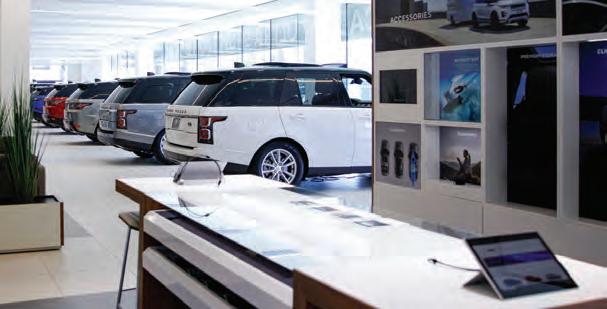

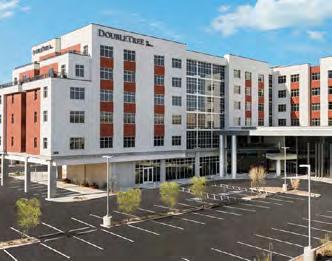
As of 2019, 11 out of the 15 fastest growing cities were located in the southwest region*. The Caliber Tax Advantaged Opportunity Zone Fund II, LLC ( CTAF II ) is designed, indirectly through its subsidiaries, to acquire, develop, redevelop, and manage a portfolio of commercial properties located in federally designated Qualified Opportunity Zones. CTAF II has acquired holdings in Arizona, and is targeting additional holdings in Colorado, Texas, Nevada, and Utah; Caliber believes due to long-term population and job growth trends, asset prices will be driven up in opportunity zones located in the Southwest, and therefore the opportunity zones in these areas have, in Caliber’s opinion, good return opportunities for investors.
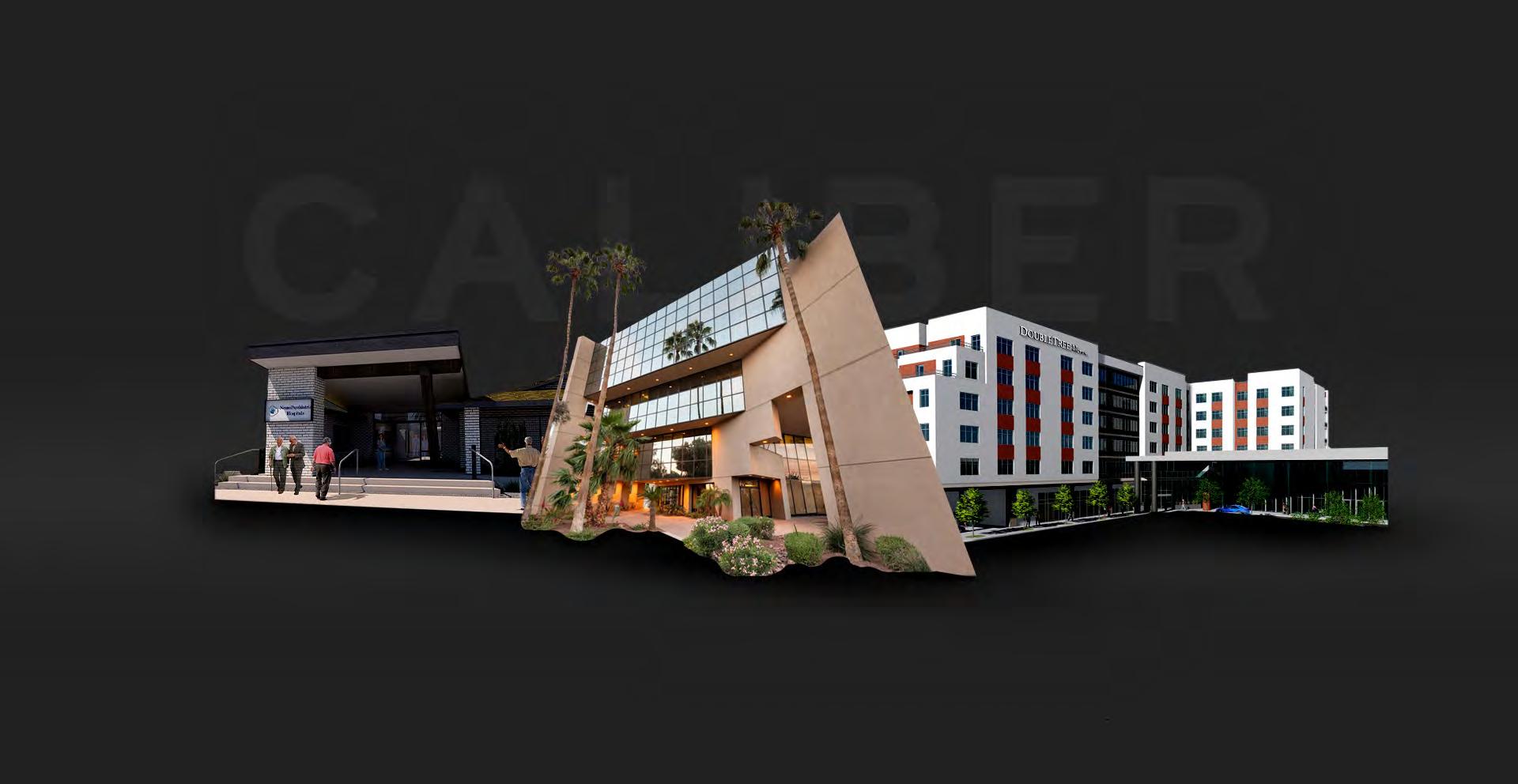

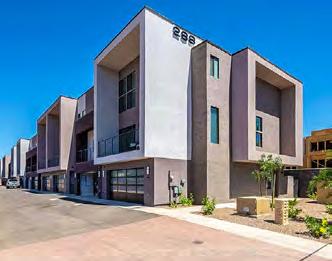

CALIBERFUNDS.CO | INVEST@CALIBERFUNDS.CO | 480.295.7600
All photos are properties within the Caliber Tax Advantaged Opportunity Zone Fund, LP. | * As reported by the United States Census Bureau. This overview is for information purposes only and does not constitute an offer to sell or a solicitation of an offer to buy any interests in the Caliber Tax Advantaged Opportunity Zone Fund II, LLC (CTAF II) or any other securities. Any such offer will be made only pursuant to CTAF II’s Private Placement Memorandum, as amended and restated, and other offering documents. This overview may include or be based in part on projections, valuations, estimates and other financial data supplied by third parties, which have not been verified by CaliberCos, Inc., its affiliates or CTAF II. This information should not be relied upon for the purpose of investing in CTAF II or for any other purpose. Any information regarding projected or estimated investment returns are estimates only and should not be considered indicative of the actual results that may be realized or predictive of the performance of CTAF II or any underlying assets in which the Fund invests. Past investment results of any underlying managers should not be viewed as indicative of future performance of CTAF II. Prior to investing, investors are strongly urged to review carefully the Private Placement Memorandum (including the risk factors described therein), the Limited Partnership Agreement of CTAF II and the subscription documents, to ask such questions of the general partner as they deem appropriate, and to discuss any prospective investment in the Fund with their legal and tax advisers in order to make an independent determination of the suitability and consequences of an investment. Investment in CTAF II is suitable only for sophisticated investors for whom an investment in the CTAF II does not constitute a complete investment program and who fully understand, and are willing to assume, the risks involved in an investment in CTAF II. 125-TOB-020923